Broadcom BRCM1005-HC 802.11g Mini PCI card co-located with Bluetooth User Manual startup and reference guide
Broadcom Corporation 802.11g Mini PCI card co-located with Bluetooth startup and reference guide
Broadcom >
Contents
User Guide Setup 2
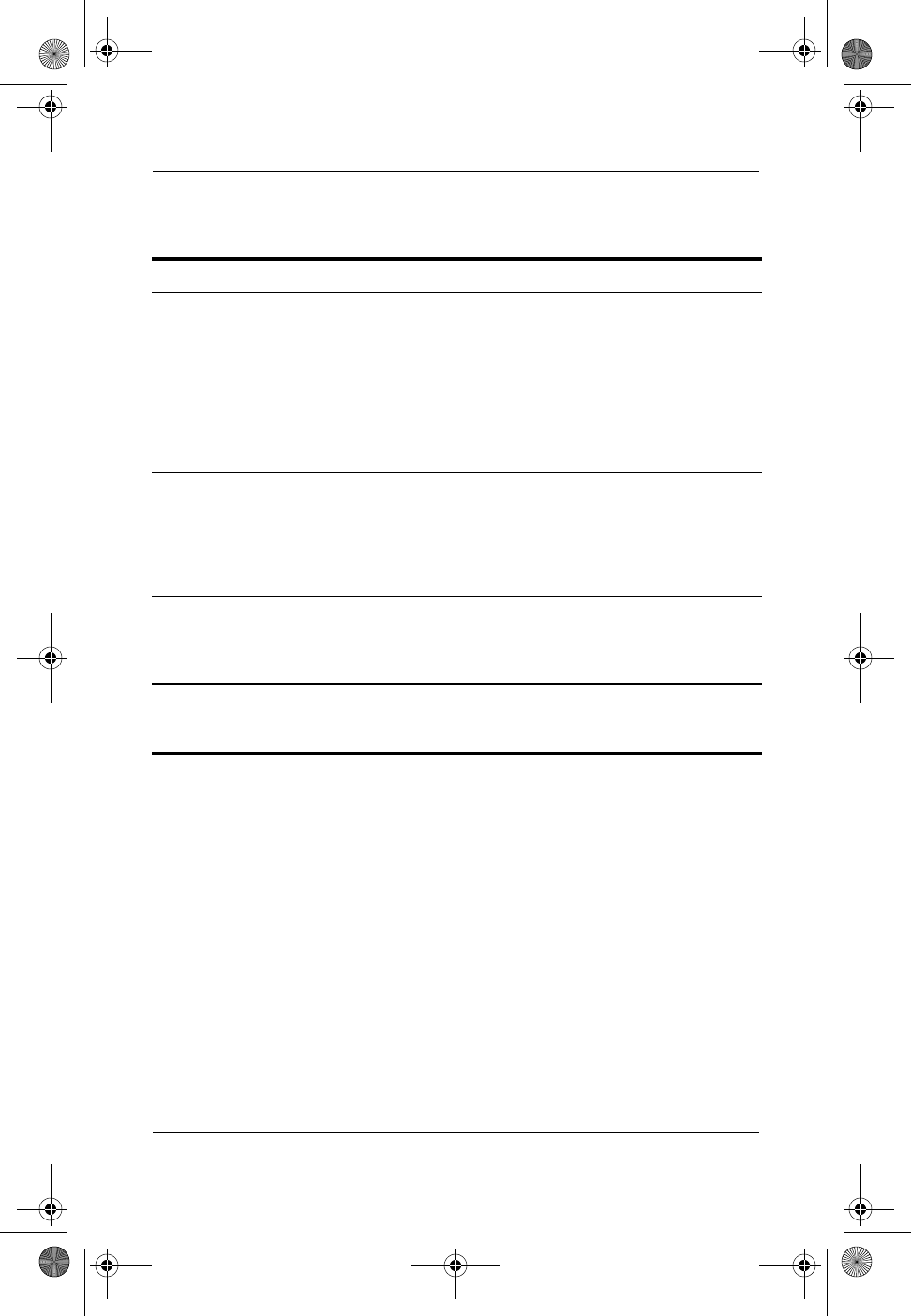
4–6 Startup and Reference Guide—Part 2
Power
Turning the Notebook or Display On or Off
Using Emergency Shutdown Procedures
If the notebook does not respond to the Windows shutdown
procedure (Start > Turn Off Computer > Turn Off), try the
following emergency shutdown procedures in the sequence
provided:
■If the notebook is running Windows XP Professional: Press
ctrl+alt+delete. Select the Shut Down button, then select Shut
down from the drop down list.
■Press and hold down the power button for at least 4 seconds.
■Unplug the notebook from external power and remove the
battery pack. For battery pack removal instructions see the
“Replacing a Battery Pack” section, later in this chapter.
Task Procedure Results
Turn on the
notebook.
Press the power button.
✎Pressing the
power button
turns on the
notebook from
Standby,
Hibernation, or
shutdown.
■Power/standby light
turns on.
■Operating system loads.
Shut down the
notebook.*
Select Start > Turn Off
Computer > Turn Off.
■Power/standby light
turns off.
■Operating system
shuts down.
■Notebook turns off.
Turn off the display
when the notebook
is closed.
Close the notebook. When the notebook is
closed, the display presses
the display switch, which
then turns off the display.
*If the system is unresponsive, and you are unable to shut down the notebook
with this procedure, see “Using Emergency Shutdown Procedures” next in this
section.
HP-323140-001.book Page 6 Tuesday, April 1, 2003 4:20 PM
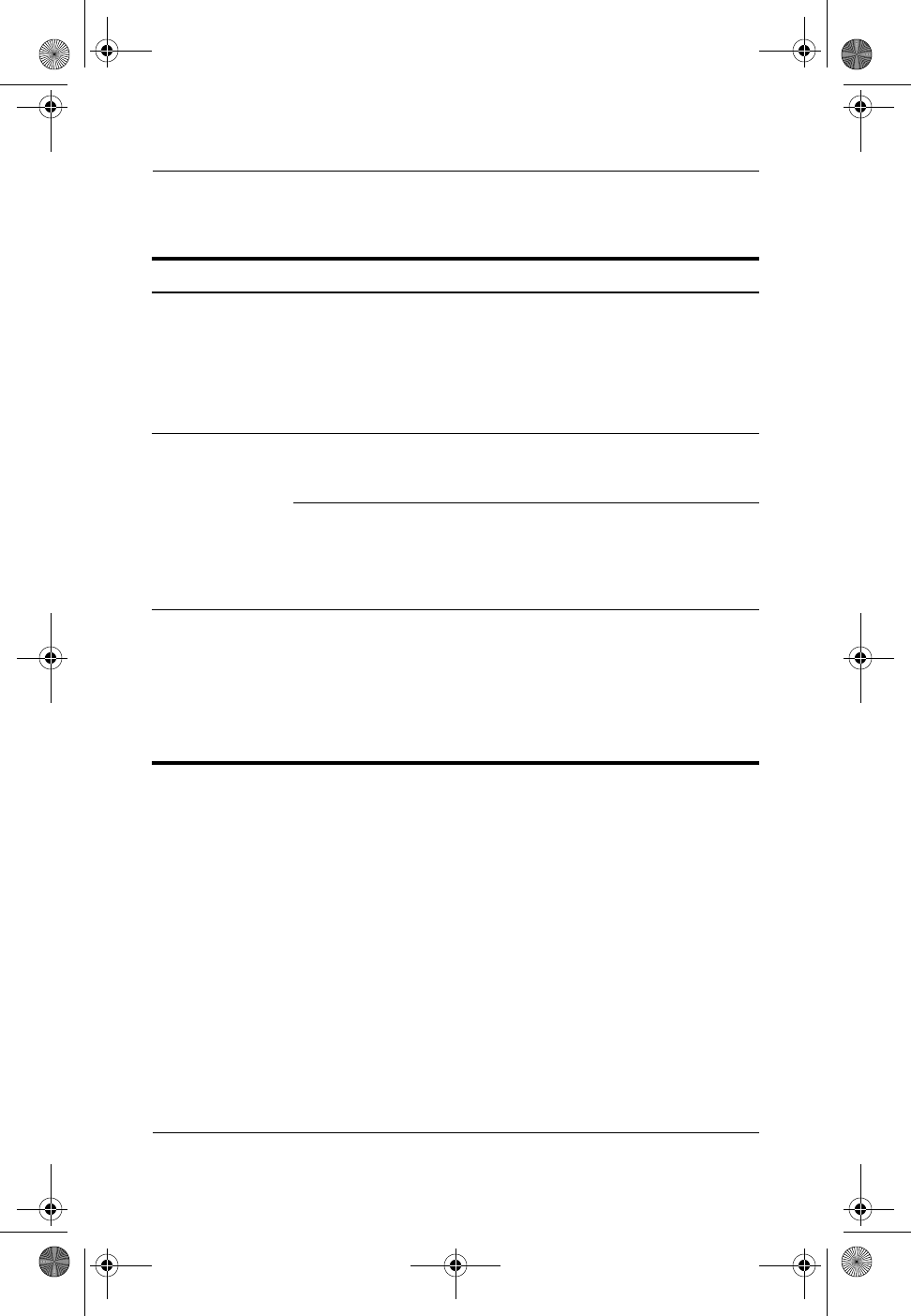
Power
Startup and Reference Guide—Part 2 4–7
Initiating or Resuming from Standby
Task Procedure Result
User-initiated
Standby
With the notebook on, use
either of the following
procedures:
■Press the Fn+F5 hotkeys.
■Select Start > Turn off
Computer > Stand by.
■Power/standby light
flashes.
■Screen clears.
System-initiated
Standby
If the notebook is running on
external power, the system
does not initiate Standby.
If the notebook is running on
battery power, the system
initiates Standby after
10 minutes of notebook
inactivity.
■Power/standby light
flashes.
■Screen clears.
Resume from
user-initiated or
system-initiated
Standby.
■Briefly press the power
button, or move (or click
any button on) an optional
external USB mouse.
■If the display was closed
while the notebook was in
Standby, open the display.
■Power/standby light
turns on.
■Your work returns to the
screen.
HP-323140-001.book Page 7 Tuesday, April 1, 2003 4:20 PM
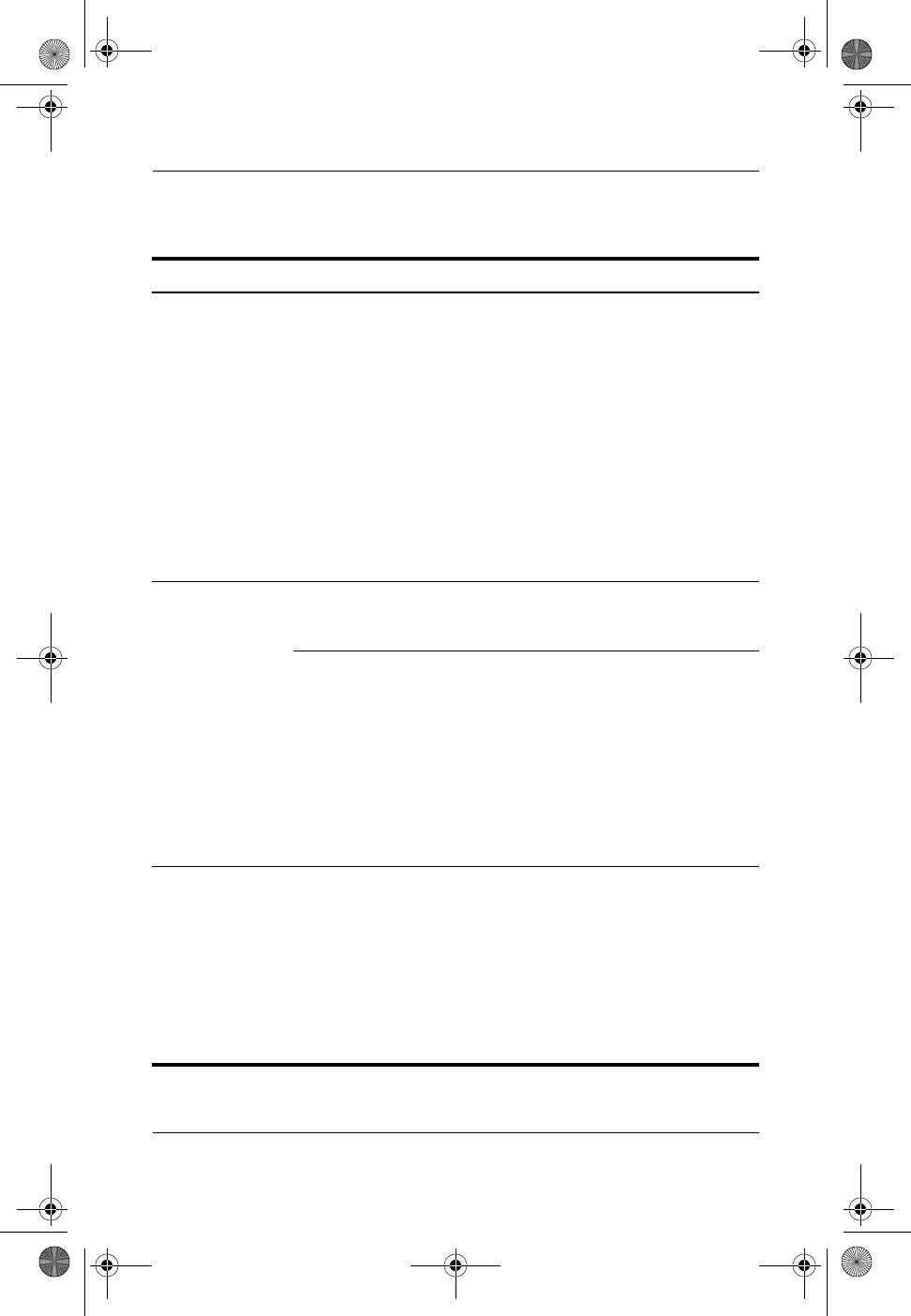
4–8 Startup and Reference Guide—Part 2
Power
Initiating or Restoring from Hibernation
Task Procedure Result
User-initiated
Hibernation
With the notebook on, use either
of the following procedures:
■Briefly press the power
button.
■Select Start > Shut Down >
Hibernate. (If the Hibernate
option is not displayed, press
and hold shift.)
✎If the notebook is in
Standby, you must
resume from Standby
before you can initiate
Hibernation.
■Power/standby light
turns off.
■Screen clears.
System-initiated
Hibernation
If the notebook is running on
external power, the system does
not initiate Hibernation.
If the notebook is running on
battery power, the system
initiates Hibernation:
■After 30 minutes of notebook
inactivity, or
■When an inserted battery
pack reaches a critical
low-battery condition
(1 percent of a full charge
remaining).
■Power/standby light
turns off.
■Screen clears.
Restore from
user-initiated or
system-initiated
Hibernation.
Press the power button.
✎If the system initiated
Hibernation because of
a critical low-battery
condition, connect
external power or insert
a charged battery pack
before you press the
power button.
■Power/standby light
turns on.
■Your work returns to
the screen.
HP-323140-001.book Page 8 Tuesday, April 1, 2003 4:20 PM
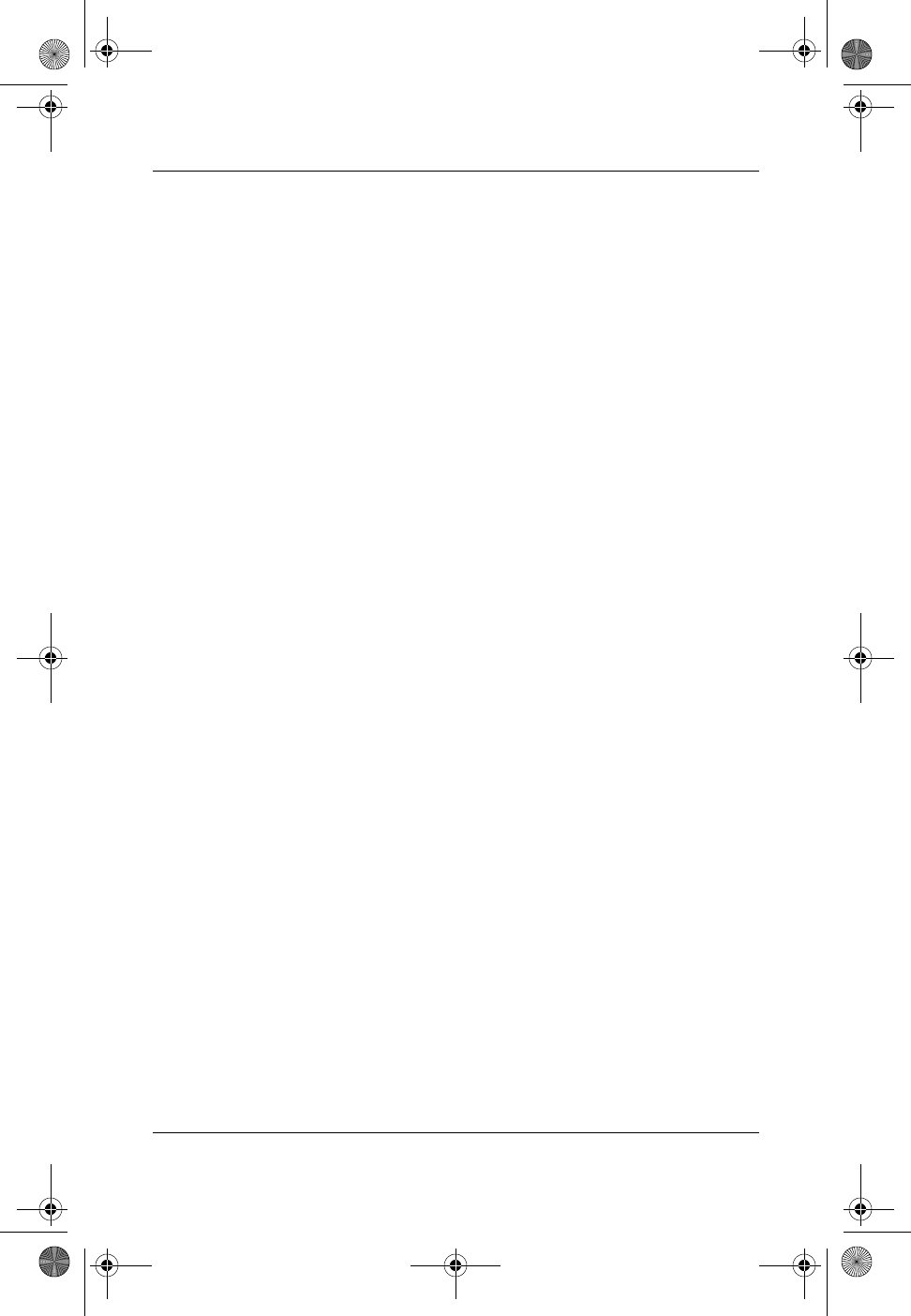
Power
Startup and Reference Guide—Part 2 4–9
Setting Power Control Preferences
By default, when the notebook is on:
■Briefly pressing the power button initiates Hibernation.
■Pressing the Fn+F5 hotkeys, called the “sleep button” in the
operating system, initiates Standby.
■The display switch turns off the display. The display switch is
activated by closing the display. (At default and all custom
settings, the display switch also turns on the notebook if the
display is opened while the notebook is in Standby.)
To change the function of the power button, the Fn+F5 hotkeys, or
the display switch:
1. Select Start > Control Panel > Performance and
Maintenance icon > Power Options icon > Advanced tab.
❏To change the power button function, select a function
from the drop-down list for When I Press The Power
Button On My Computer.
❏To change the function of the Fn+F5 hotkeys, select a
function from the drop-down list for When I Press The
Sleep Button On My Computer.
❏To change the display switch function, select a function
from the drop-down list for When I Close The Lid Of My
Portable Computer.
2. Select the OK button.
The Hibernate function is available in the power button, sleep
button, and display switch drop-down lists only if Hibernation is
enabled.
HP-323140-001.book Page 9 Tuesday, April 1, 2003 4:20 PM
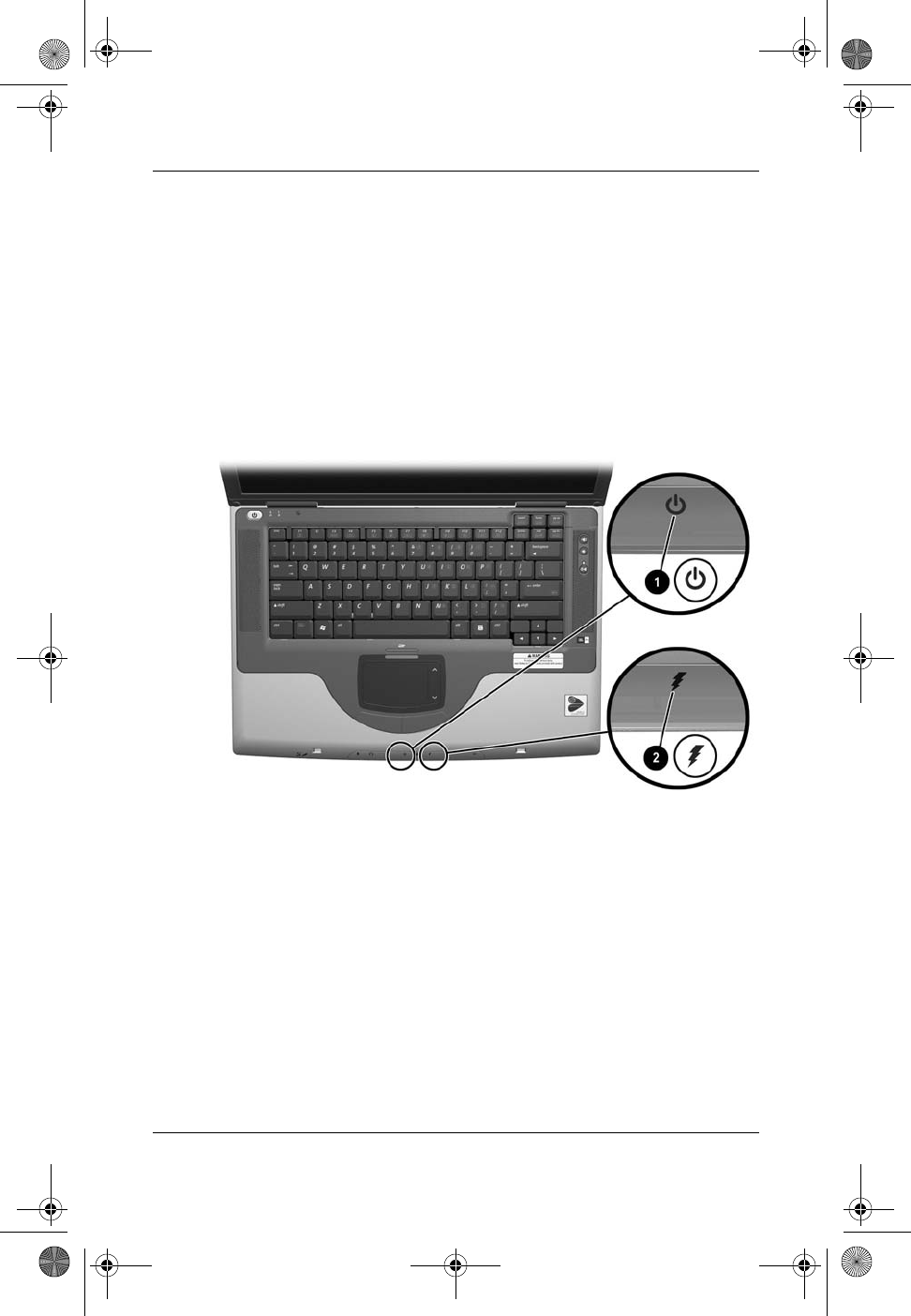
4–10 Startup and Reference Guide—Part 2
Power
Using Battery Power
Identifying the Battery and Power/Standby
Lights
Battery pack procedures refer to the:
1 Power/standby light
2 Battery light
Identifying the battery and power/standby lights
HP-323140-001.book Page 10 Tuesday, April 1, 2003 4:20 PM
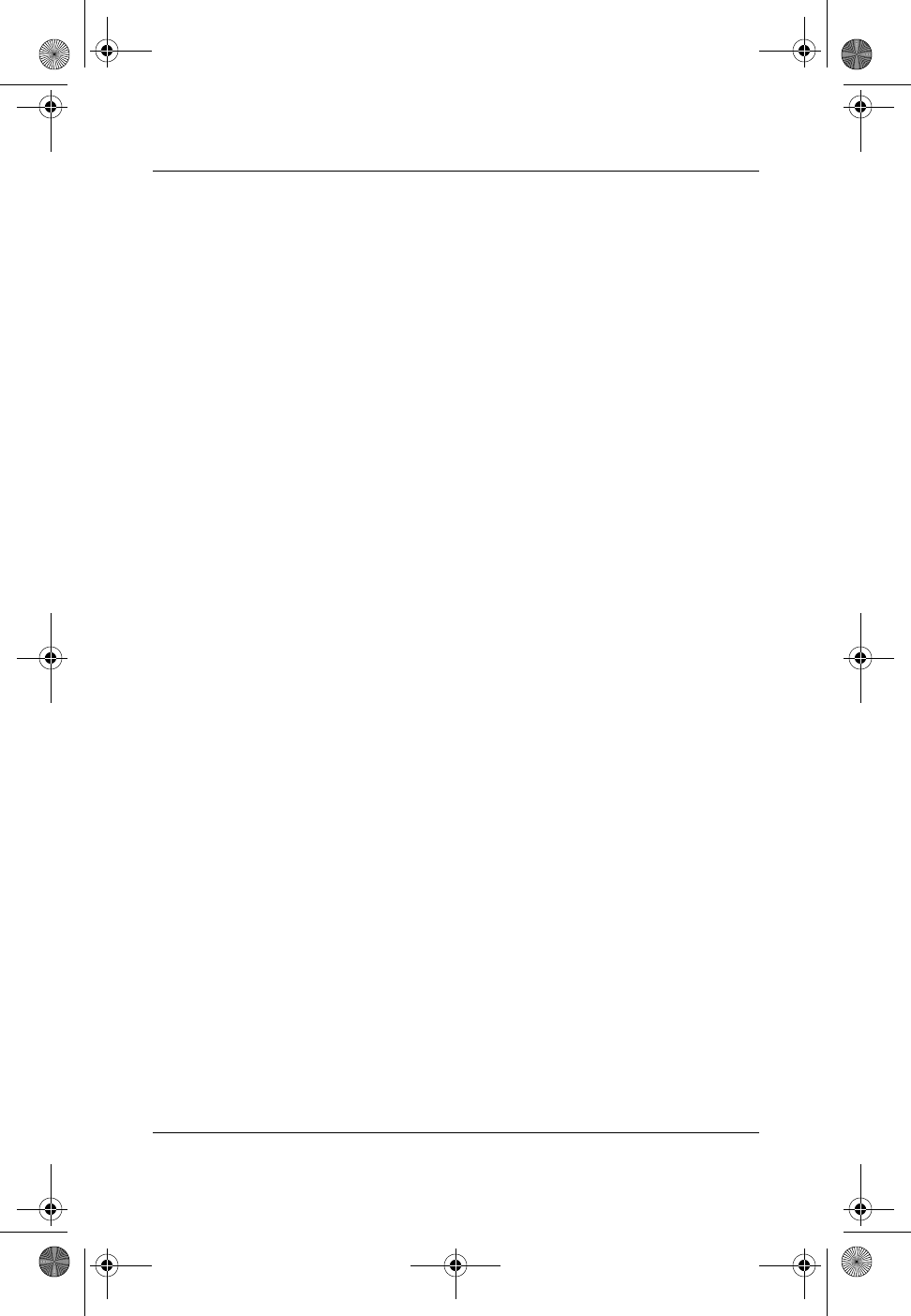
Power
Startup and Reference Guide—Part 2 4–11
Switching Between Battery and External
Power
The notebook switches between external power and battery
power according to the availability of external power. To conserve
the charge in an inserted battery pack, the notebook runs on
external power whenever external power is available. External
power can be supplied from an electrical outlet through an
AC adapter or an optional DC cable.
If the notebook contains a charged battery pack and is running on
external power, the notebook switches to battery power only if the
AC adapter or DC cable is disconnected from the notebook.
The Power Meter icon in the system tray changes shape whenever
the power source changes between battery power and external
power.
Charging a Battery Pack
The battery pack charges whenever the notebook is connected to
external power through an AC adapter or an optional DC cable.
The battery pack charges whether the notebook is turned off or
turned on, but charges most quickly when the notebook is turned
off. When the notebook is turned on, charging times are longer
and vary with system activity.
The battery light displays charge status:
■On and amber: the battery pack is charging.
■On and green: the battery pack is fully charged.
■Flashing: the battery pack is malfunctioning and may need to
be replaced.
HP-323140-001.book Page 11 Tuesday, April 1, 2003 4:20 PM
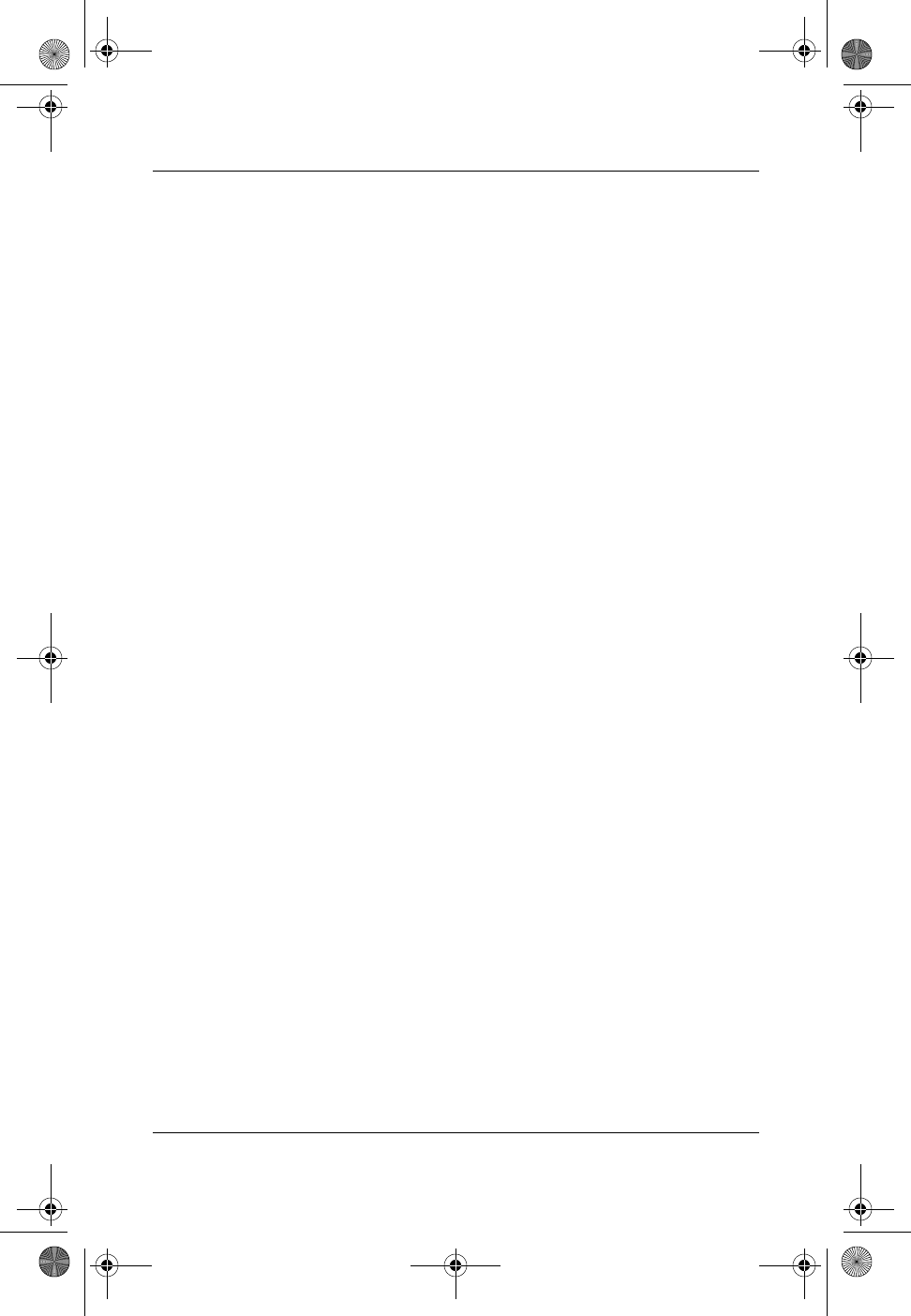
4–12 Startup and Reference Guide—Part 2
Power
Monitoring the Charge in a Battery Pack
Obtaining Accurate Charge Information
To increase the accuracy of all battery charge displays:
■Allow the battery pack to discharge to less than 10 percent of
a full charge through normal use before charging it.
■Charge the battery pack fully. Even a new battery pack can
display charge information inaccurately if it has not been
fully charged.
■If a battery pack has not been used for one month or more, the
battery pack may need to be calibrated.
Displaying Charge Information
To display battery charge information on the screen, use the
operating system Power Meter feature. To access Power Meter
displays, select Start > Control Panel > Performance and
Maintenance icon > Power Options icon > Power Meter tab.
Power Meter displays battery status in both percent and time:
■The percent indicates the amount of charge remaining in the
battery pack.
■The time indicates the approximate running time remaining
on the battery pack if the battery pack continues to provide
power at the current level. For example, the time remaining
will decrease if you start playing a DVD and will increase if
you stop playing a DVD.
HP-323140-001.book Page 12 Tuesday, April 1, 2003 4:20 PM
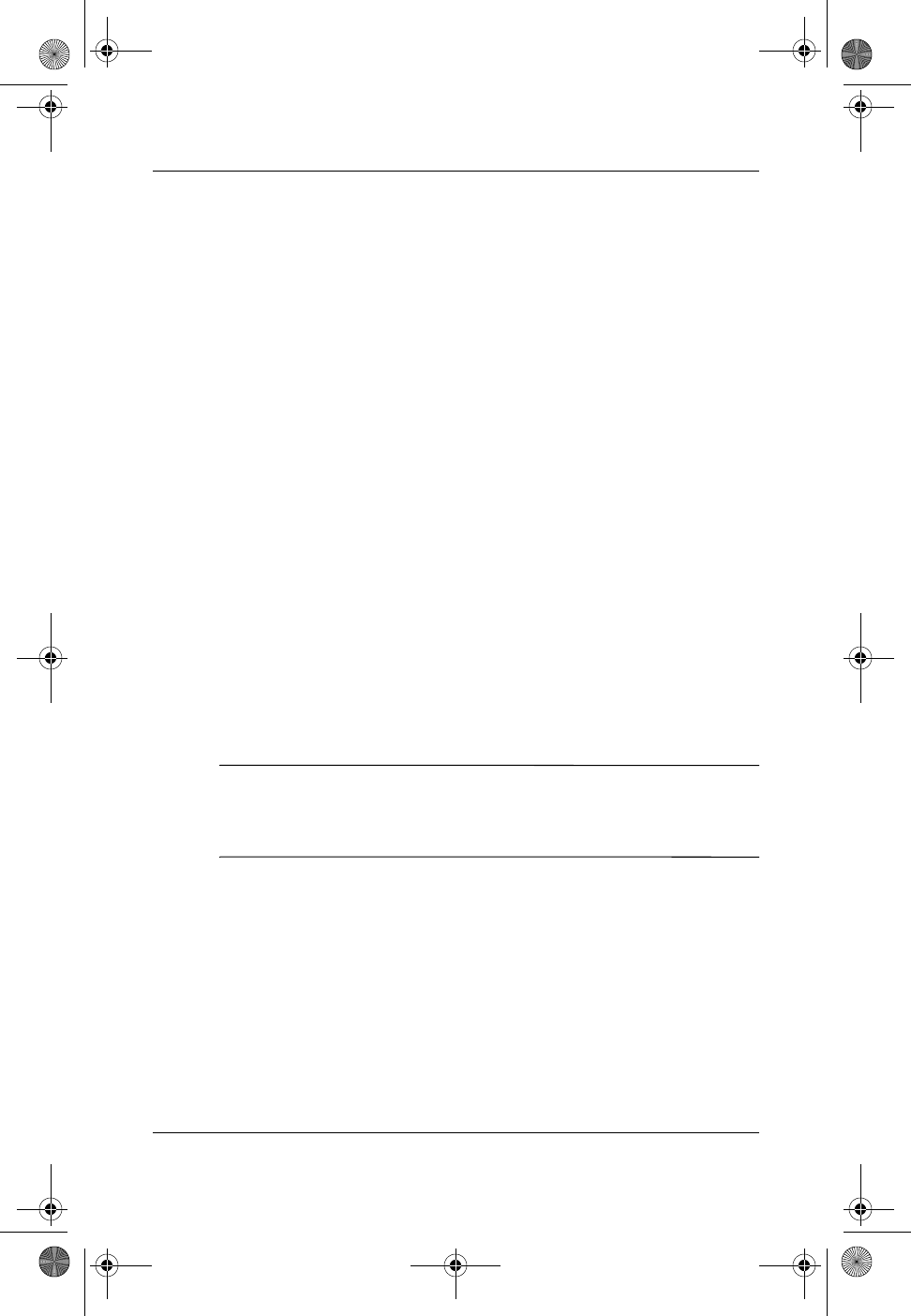
Power
Startup and Reference Guide—Part 2 4–13
Managing Low-Battery Conditions
The information in this section describes default alerts and
system responses.
Identifying Low-Battery Conditions
When the battery pack is the only power source for the notebook
and drops to 10 percent of a full charge, the notebook has reached
alow-battery condition. A text warning message appears on the
screen.
If a low-battery condition is not resolved and the amount of
charge remaining in the battery pack continues to drop, the
notebook eventually enters a critical low-battery condition. Then,
if the notebook is on or in Standby:
■If Hibernation is enabled, the system initiates Hibernation.
Unsaved work may be lost.
■If Hibernation is disabled, the notebook remains briefly in
Standby, then shuts down. The power/standby light turns off,
and the notebook cannot save system memory to the hard
drive.
Resolving Low-Battery Conditions
ÄCAUTION: If the notebook has reached a critical low-battery condition
and has begun to initiate Hibernation, do not restore power until
Hibernation is complete. When Hibernation is complete, the
power/standby light turns off.
If external power is available, connect the notebook to the
external power source.
If a charged battery pack is available, shut down the notebook or
initiate Hibernation. Insert a charged battery pack, then turn on
the notebook.
If no power source is available, save your work. Then initiate
Hibernation or shut down the notebook.
HP-323140-001.book Page 13 Tuesday, April 1, 2003 4:20 PM
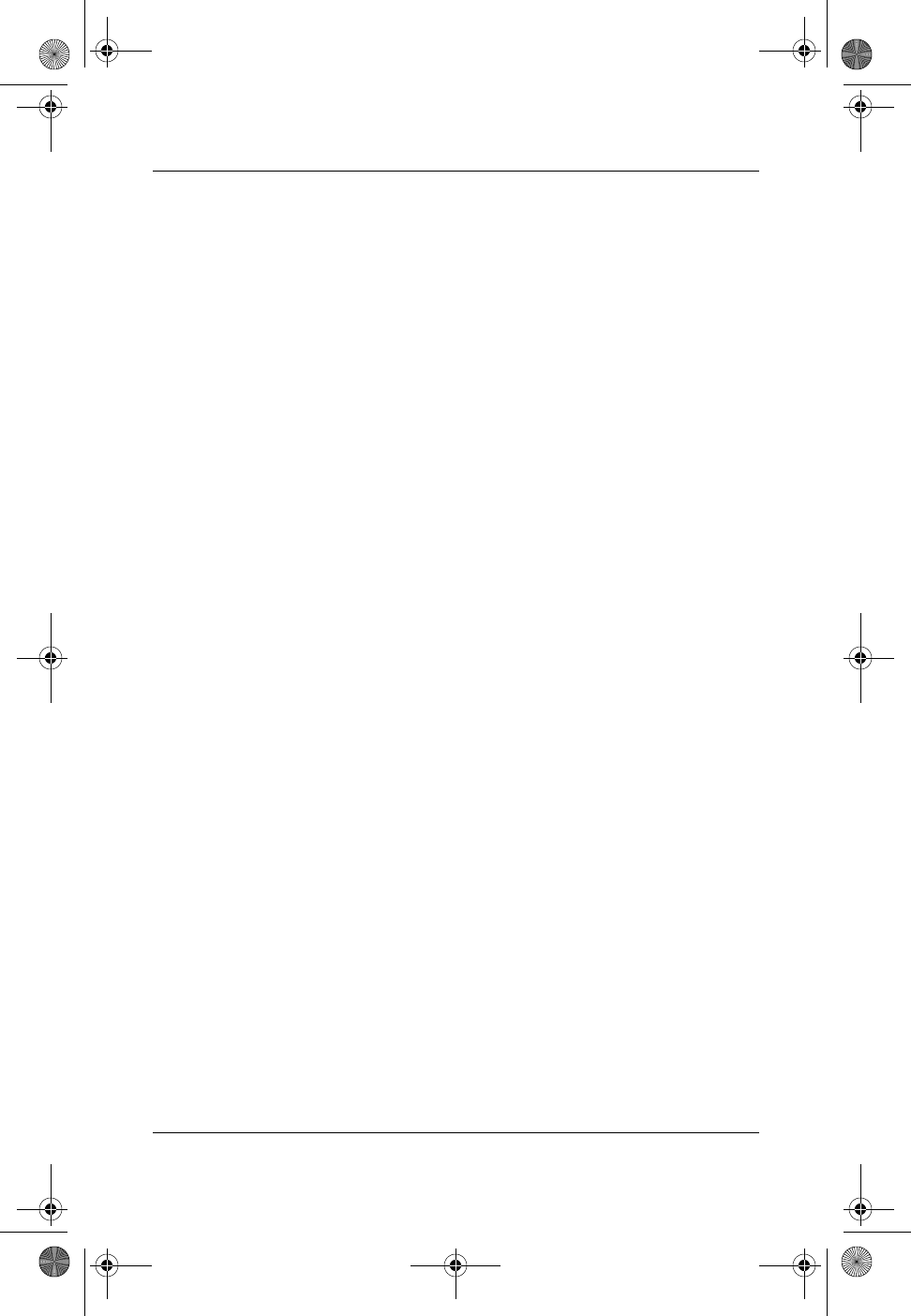
4–14 Startup and Reference Guide—Part 2
Power
Calibrating a Battery Pack
When to Calibrate
Even if a battery pack is heavily used, it should not be necessary
to calibrate it more than once a month. It is not necessary to
calibrate a new battery pack before first use. Calibrate the battery
pack under the following conditions:
■When battery charge displays seem inaccurate.
■When you observe a significant change in battery run time.
■When the battery pack has not been used for one month
or more.
How to Calibrate
To calibrate a battery pack, you must fully charge, fully
discharge, then fully recharge the battery pack.
Charging the Battery Pack
Charge the battery pack while the notebook is in use. To charge
the battery pack:
1. Insert the battery pack into the notebook. For instructions, see
“Replacing a Battery Pack” later in this chapter.
2. Connect the notebook to external power. (The battery light is
on and amber as the battery pack charges.)
3. Leave the notebook connected to external power until the
battery pack is fully charged. (The battery light turns green.)
Discharging the Battery Pack
Before you begin the full discharge, disable Hibernation. To
disable Hibernation, select Start > Control Panel > Performance
and Maintenance > Power Options > Hibernate tab. Then clear
the Enable Hibernation check box.
HP-323140-001.book Page 14 Tuesday, April 1, 2003 4:20 PM
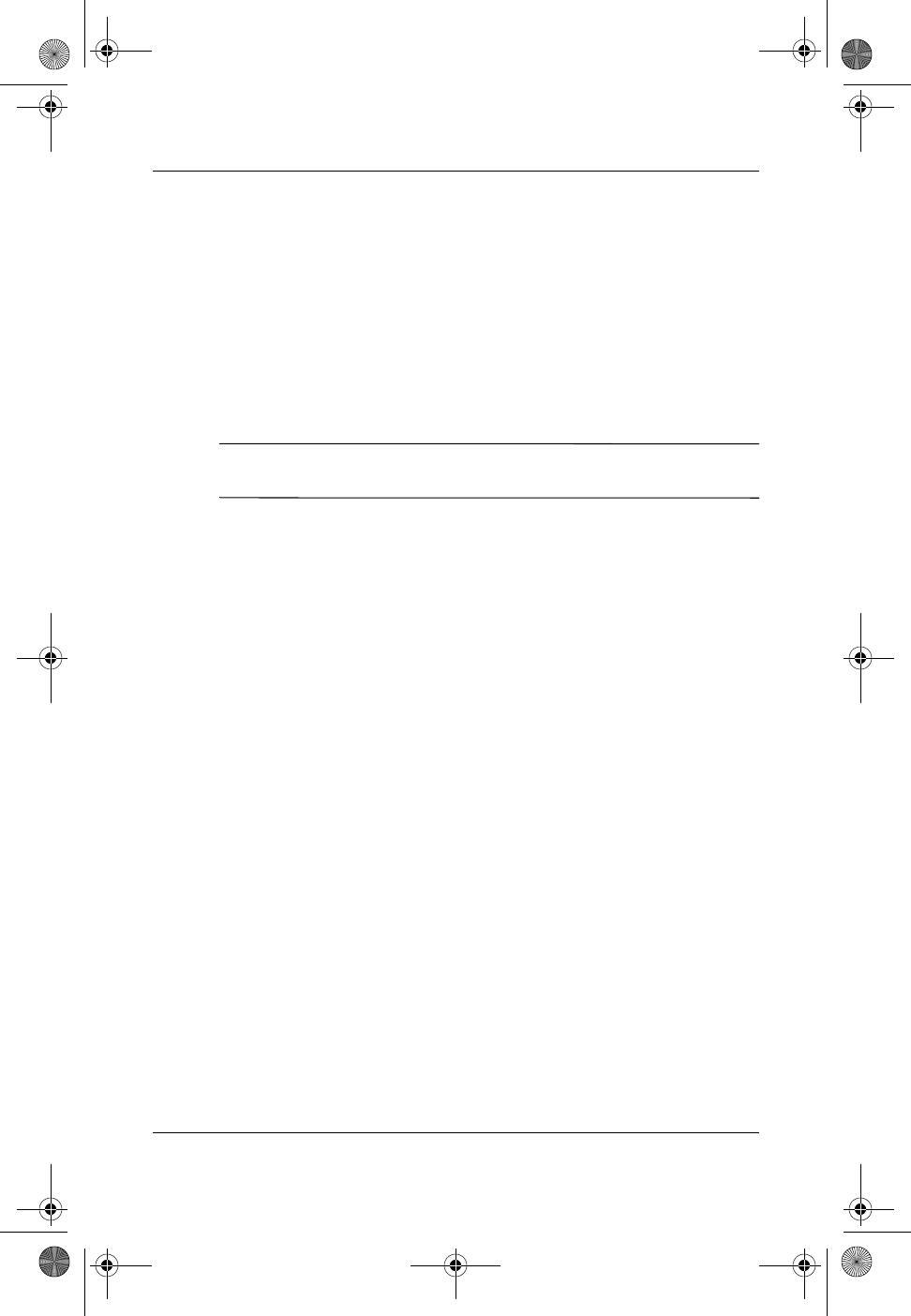
Power
Startup and Reference Guide—Part 2 4–15
If you use the notebook occasionally during the discharge
procedure and have set energy-saving timeouts, expect the
following performance from your system during the discharge
process:
■The monitor will not turn off automatically.
■Hard drive speed will not decrease automatically while the
notebook is idle.
■System-initiated Standby will not occur.
ÄCAUTION: If you plan to leave the notebook unattended during
discharge, save your work before starting the discharge procedure.
To fully discharge the battery pack:
1. Select the power icon on the taskbar or select Start > Control
Panel > Performance and Maintenance icon > Power
Options icon > Power Schemes tab.
2. Record all settings in the Plugged In column and all settings
in the Running On Batteries column, so you can reset them
after calibration.
3. Use the drop-down lists to set each item in both columns
to Never.
4. Select the OK button.
5. Disconnect the notebook from the external power source, but
do not turn off the notebook.
6. Run the notebook on battery power until the battery pack is
fully discharged. When the battery pack is fully discharged,
the battery light turns off and the notebook shuts down.
HP-323140-001.book Page 15 Tuesday, April 1, 2003 4:20 PM
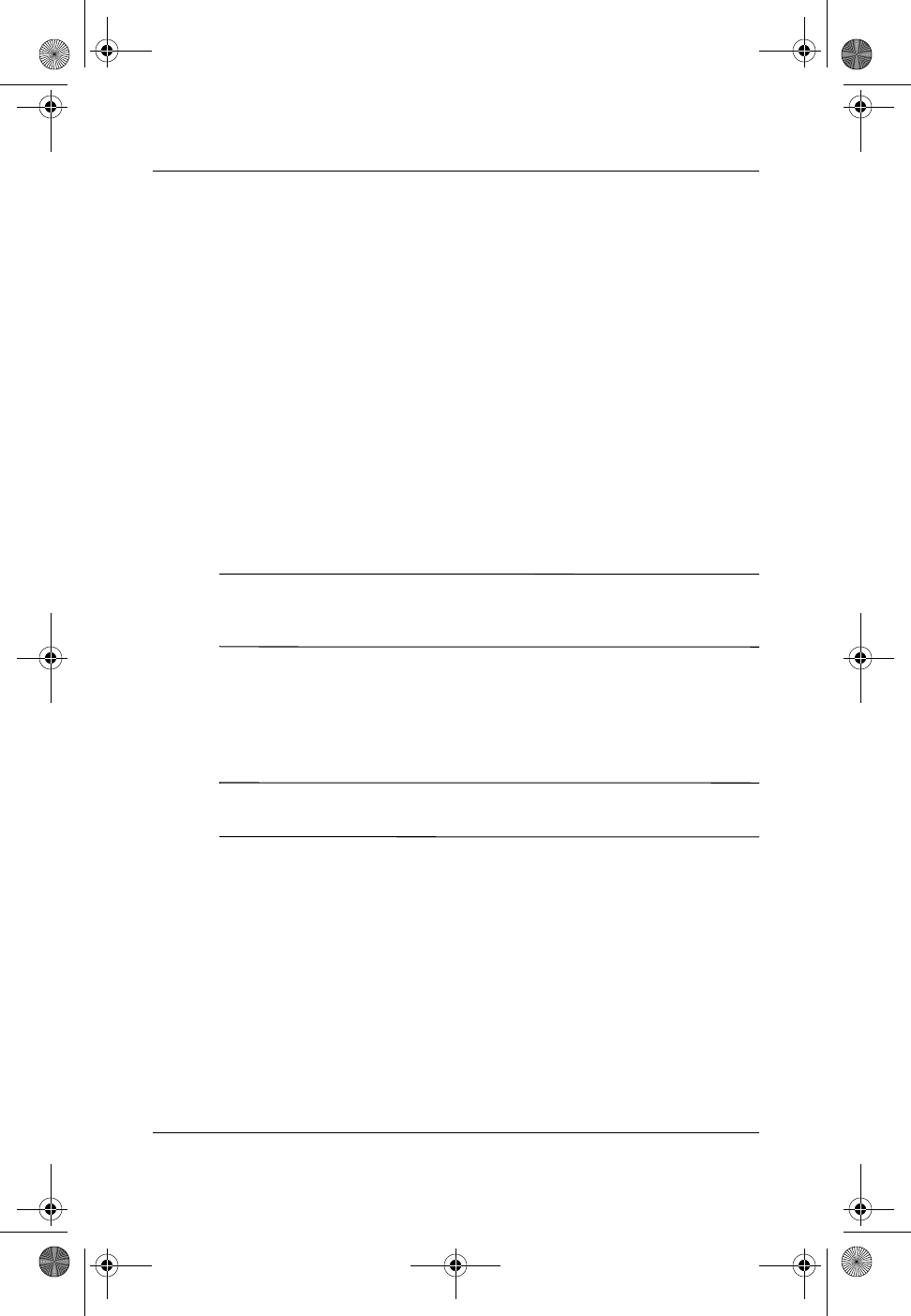
4–16 Startup and Reference Guide—Part 2
Power
Recharging the Battery Pack
1. Connect the notebook to external power and keep the
notebook connected until the battery pack is fully recharged
and the battery light turns green.
You can use the notebook while the battery pack is
recharging, but the battery pack will charge faster if the
notebook is turned off.
2. Select the Power icon on the taskbar or select Start > Control
Panel > Performance and Maintenance icon > Power
Options icon > Power Schemes tab.
3. Reenter the settings you recorded for the items in the Plugged
In column and the Running on Batteries column.
4. Select the OK button.
ÄCAUTION: After calibrating the battery pack, reenable Hibernation:
select Start > Control Panel > Performance and Maintenance > Power
Options > Hibernate tab, then select the Enable Hibernation check box.
Storing a Battery Pack
If the notebook will be unused and unplugged for more than
2 weeks, remove and store the battery pack.
ÄCAUTION: To prevent damage to a battery pack, do not expose it to
high temperatures for extended periods of time.
High temperatures, which may be present in parked cars or some
workplaces, accelerate the self-discharge rate of a stored battery
pack. To prolong the charge of a stored battery pack, place it in a
location that is cool and dry.
To maintain the accuracy of battery charge displays, calibrate a
battery pack that has been stored for one month or more before
using it.
HP-323140-001.book Page 16 Tuesday, April 1, 2003 4:20 PM
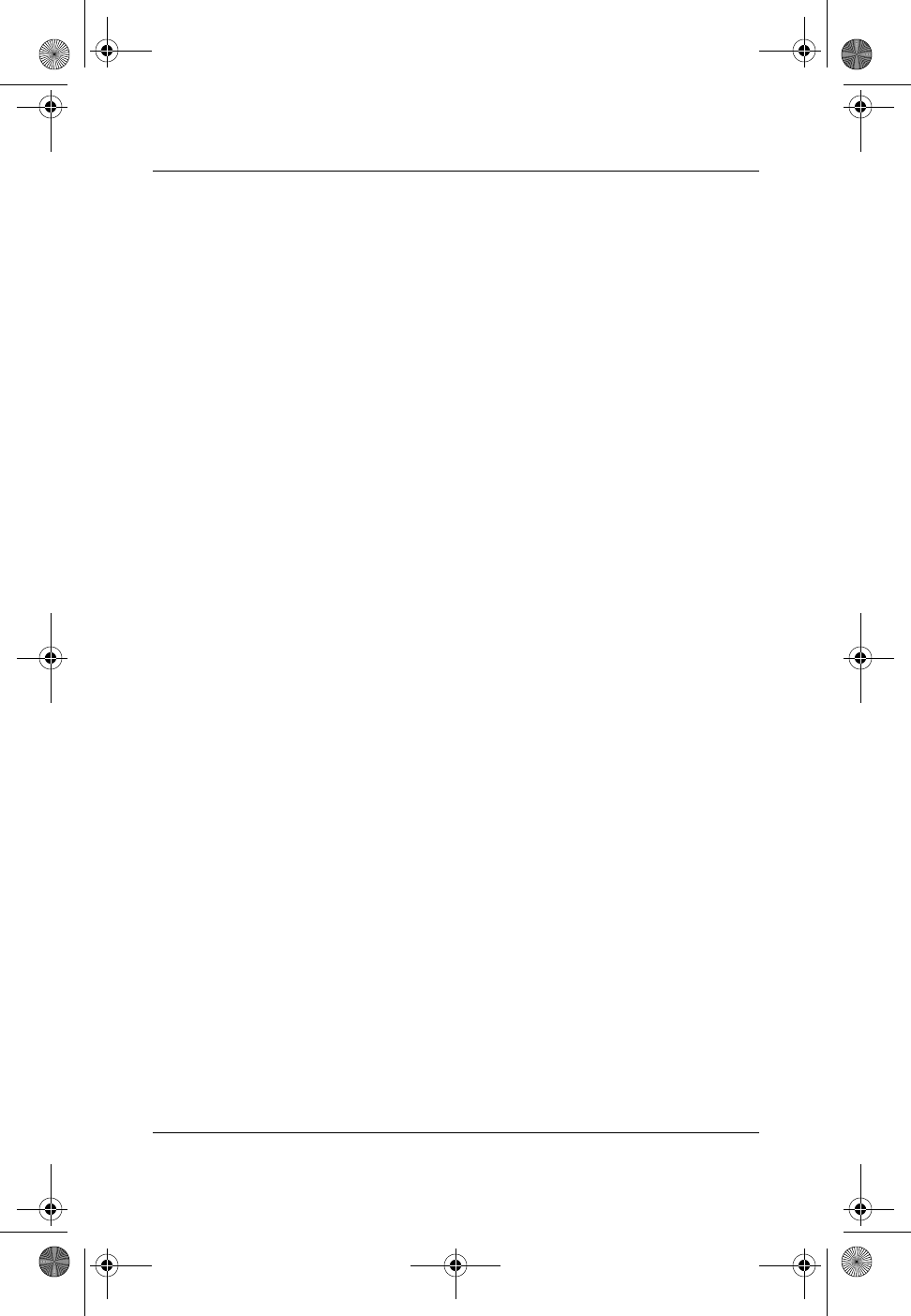
Power
Startup and Reference Guide—Part 2 4–17
Battery Conservation Settings and
Procedures
Using the following battery conservation settings and procedures
extends the run time of a battery pack.
■Turn off wireless and local area network (LAN) connections
and exit modem applications when you are not using them.
■Disconnect from the notebook any external devices that use
power from the notebook. Battery run time is not affected by
external devices that are plugged into an external power
source.
■Stop or remove a PC Card you are not using.
■Disable or remove an SD (Secure Digital) Card or MMC
(multimedia card) you are not using.
■Lower screen brightness. Screen brightness can be lowered
by pressing the Fn+F7 hotkeys.
■Lower system volume. Volume can be lowered with the
decrease volume button.
■Turn off a device connected to the S-Video connector. A
device connected to the S-Video connector can be turned
off by using the Fn+F4 hotkeys to switch the image from the
S-Video device to the notebook display.
■If you leave your work, initiate Standby or Hibernation or
shut down the notebook.
■Select a short wait time, 5 minutes or less, for the monitor
timeout. To change monitor timeout settings, select Start >
Control Panel > Performance and Maintenance icon > Power
Options icon > Power Meter tab. Select a short wait time
from the Turn Off Monitor drop-down list, then select OK.
HP-323140-001.book Page 17 Tuesday, April 1, 2003 4:20 PM
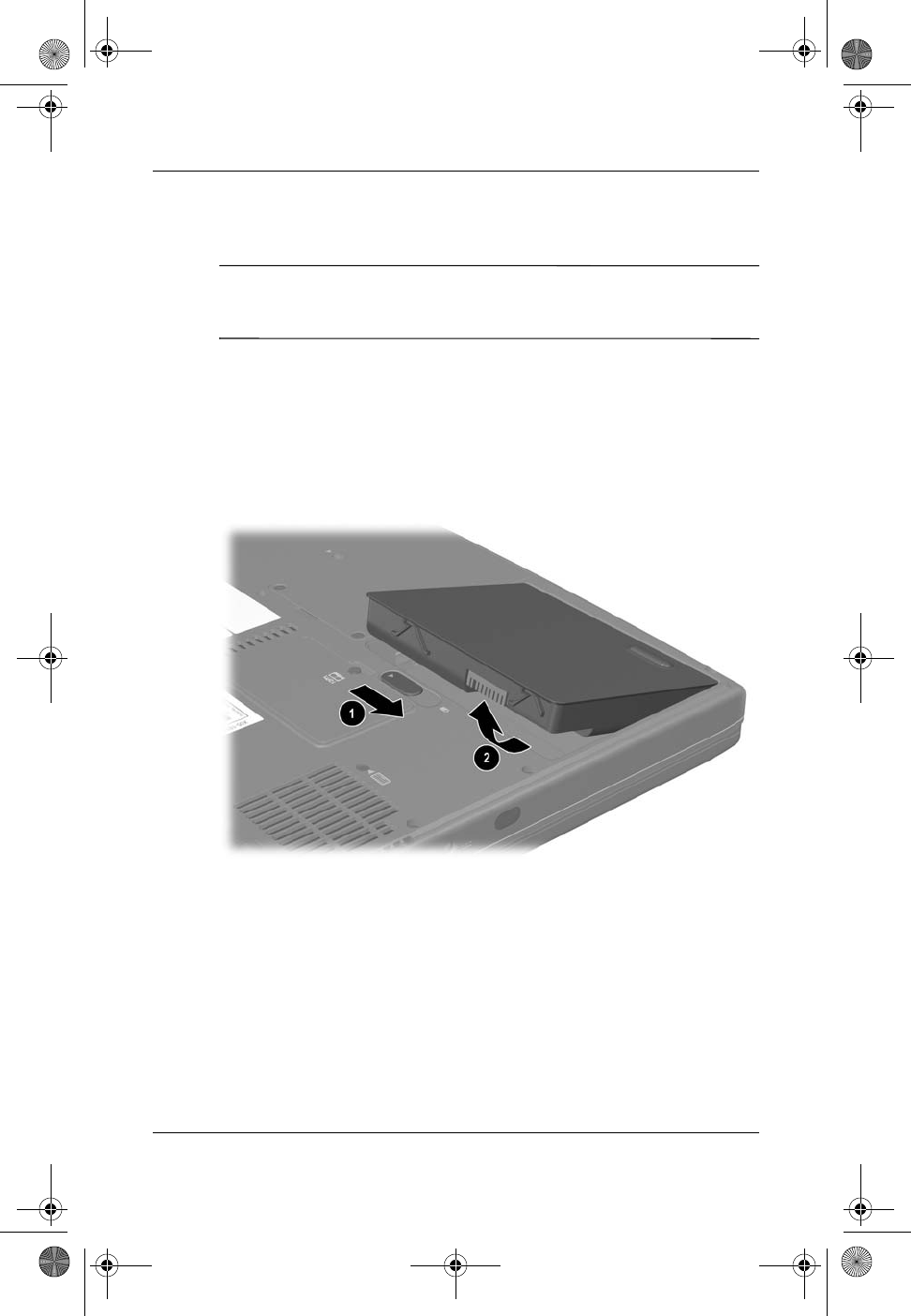
4–18 Startup and Reference Guide—Part 2
Power
Replacing a Battery Pack
ÄCAUTION: To prevent loss of work when removing a battery pack that
is the only power source, initiate Hibernation or turn off the notebook
before removing the battery pack.
To replace the battery pack:
1. Turn the notebook underside up.
❏To remove a battery pack, slide the battery release
latch 1. (The battery pack tilts upward.) Then pull the
battery pack out of the battery bay 2.
Removing a battery pack
HP-323140-001.book Page 18 Tuesday, April 1, 2003 4:20 PM
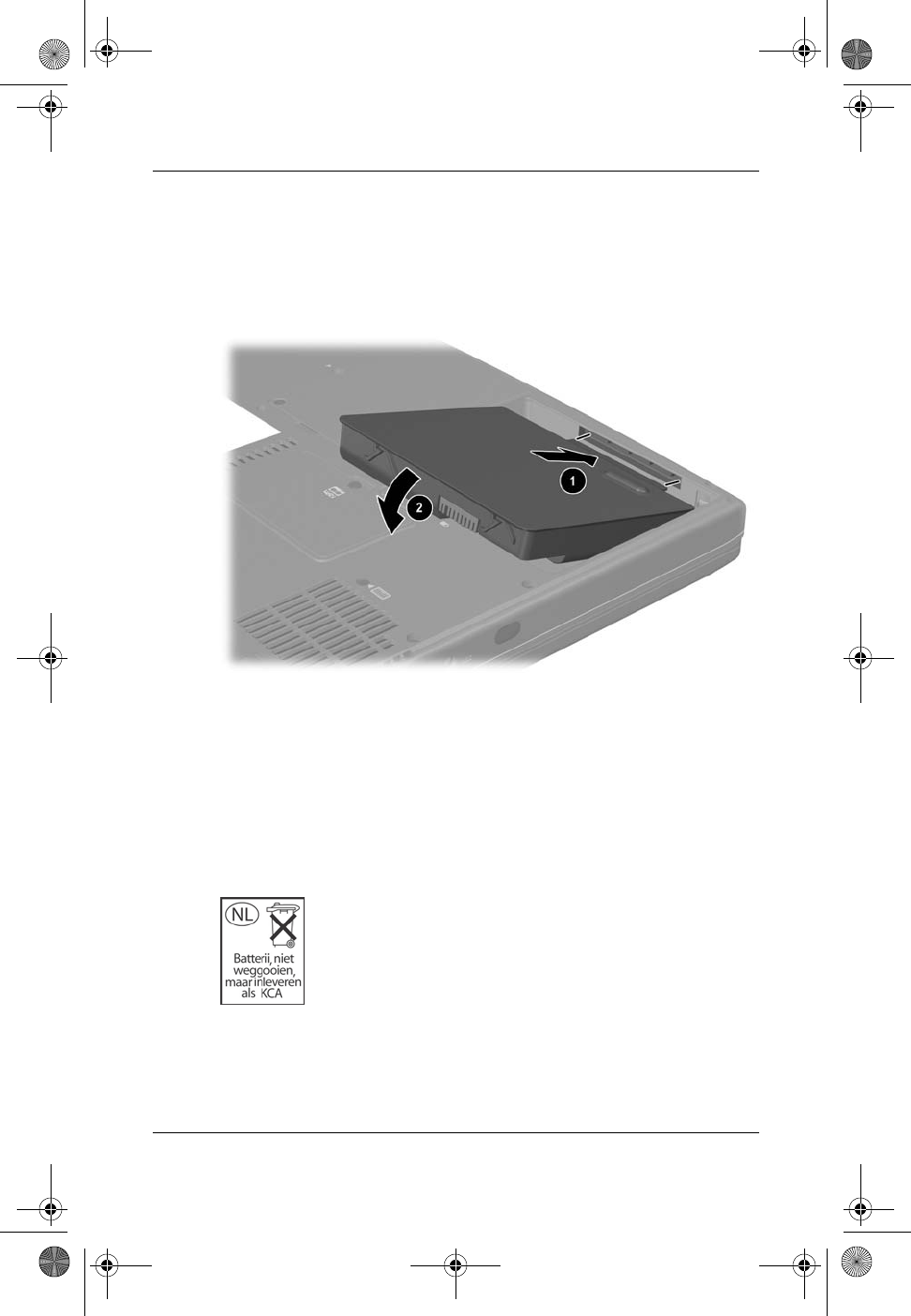
Power
Startup and Reference Guide—Part 2 4–19
❏To insert a battery pack, insert the alignment tab on the
battery pack into the alignment slot on the notebook 1,
then tilt the battery pack downward until it snaps into
place 2.
Inserting a battery pack
2. To restore from Hibernation or to turn on the notebook, press
the power button.
Recycling or Disposing of a Used
Battery Pack
For information about recycling or disposing of
a used battery pack, refer on the Documentation
Library CD to the Regulatory and Safety Notices
guide, “Battery Notice” section.
HP-323140-001.book Page 19 Tuesday, April 1, 2003 4:20 PM
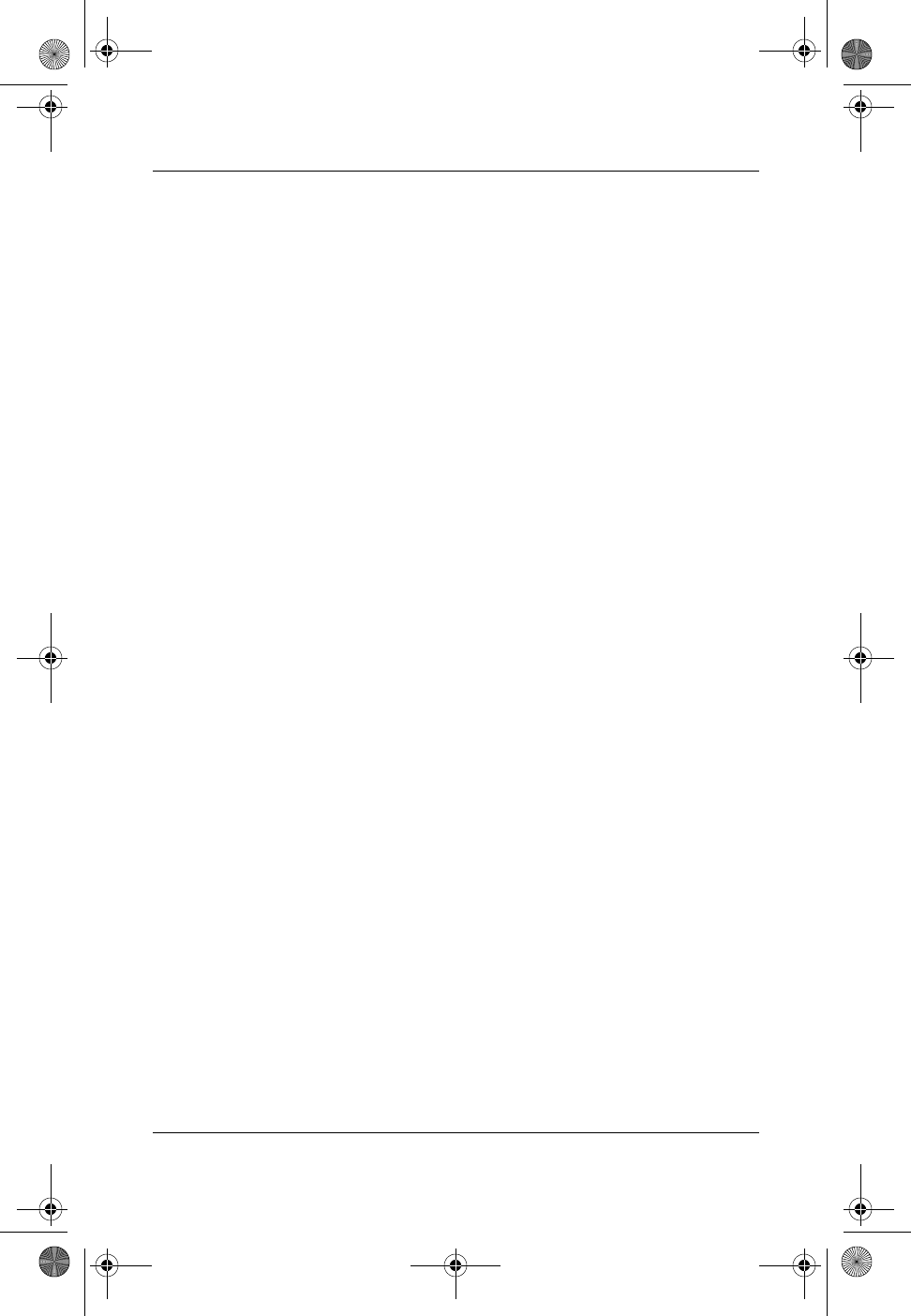
4–20 Startup and Reference Guide—Part 2
Power
HP-323140-001.book Page 20 Tuesday, April 1, 2003 4:20 PM
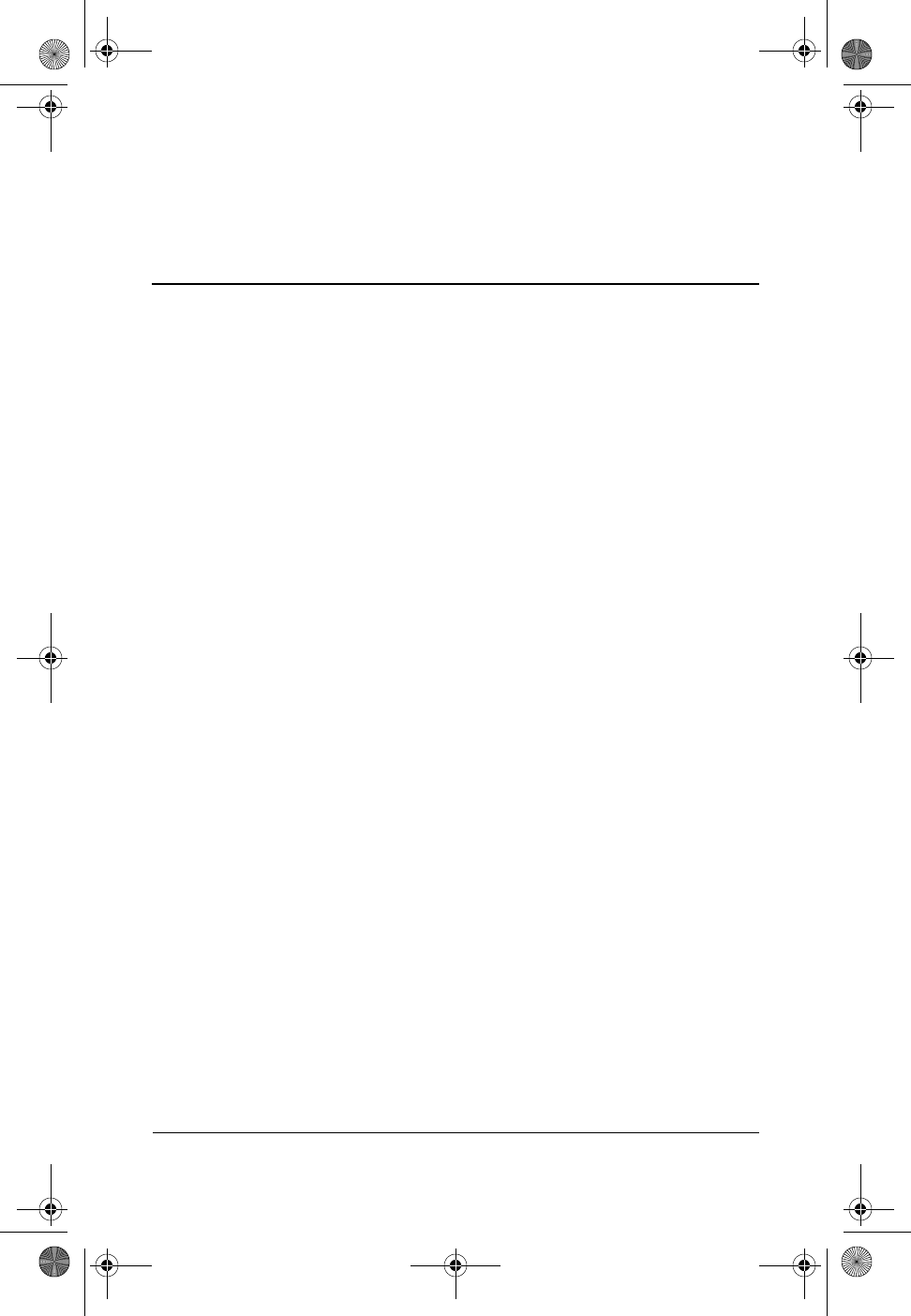
Startup and Reference Guide—Part 2 5–1
5
Drives and Drive Media
Contents
Understanding Drive and Drive Media Terms. . . . . . . . . 5–2
Caring for Drives and Drive Media . . . . . . . . . . . . . . . . . 5–3
Adding a Drive to the System . . . . . . . . . . . . . . . . . . . . . 5–4
Using the IDE Drive Light. . . . . . . . . . . . . . . . . . . . . . . . 5–4
Inserting or Removing a Disc . . . . . . . . . . . . . . . . . . . . . 5–5
Inserting a Disc . . . . . . . . . . . . . . . . . . . . . . . . . . . . . 5–5
Removing a Disc (With Power). . . . . . . . . . . . . . . . . 5–6
Removing a Disc (Without Power) . . . . . . . . . . . . . . 5–7
Playing a Disc . . . . . . . . . . . . . . . . . . . . . . . . . . . . . . . . . 5–8
Displaying Media Contents . . . . . . . . . . . . . . . . . . . . 5–8
Protecting Playback . . . . . . . . . . . . . . . . . . . . . . . . . . 5–9
Observing the Copyright Warning . . . . . . . . . . . . . . 5–9
Setting the Boot Order . . . . . . . . . . . . . . . . . . . . . . . . . . 5–10
Replacing the Internal Hard Drive . . . . . . . . . . . . . . . . . 5–10
HP-323140-001.book Page 1 Tuesday, April 1, 2003 4:20 PM
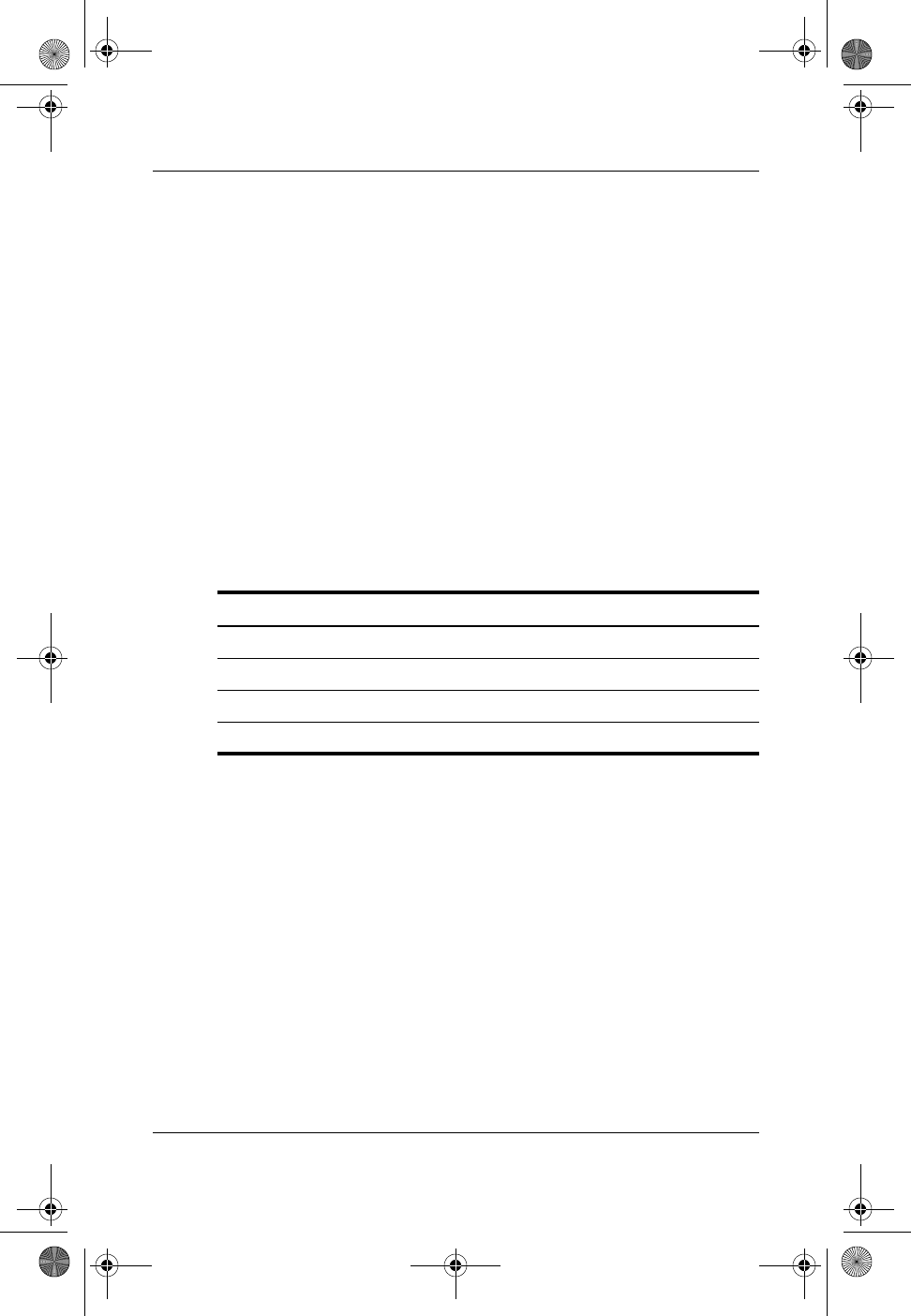
5–2 Startup and Reference Guide—Part 2
Drives and Drive Media
Understanding Drive and Drive Media
Terms
Hard drives are for the permanent storage of data files and of
software such as system files, applications, and drivers. A hard
drive is sometimes called a hard disk drive.
Diskette drives support diskettes, which are used to store or
transport data. The notebook can read or write to any diskette.
A diskette drive is sometimes called a floppy disk drive.
Optical drives include CD and DVD drives. Optical drives
support CDs and DVDs, often called discs, which are used to
store or transport data and to play music and movies. DVDs have
higher capacities than CDs. The notebook can read or write to
optical drives as described in the following table.
Adrive designation is a letter of the alphabet that the notebook
uses to identify the drive. To display the drive designation of all
the drives in the system, select Start > My Computer.
Adiskette or disc that can be inserted or removed from a drive is
referred to as a drive medium. For example, the term drive media
includes diskettes, CDs, and DVDs.
Optical Drive Read Write
CD-ROM drive Yes No
DVD-ROM drive Yes No
CD-RW drive Yes Yes
DVD/CD-RW drive Yes Yes
HP-323140-001.book Page 2 Tuesday, April 1, 2003 4:20 PM
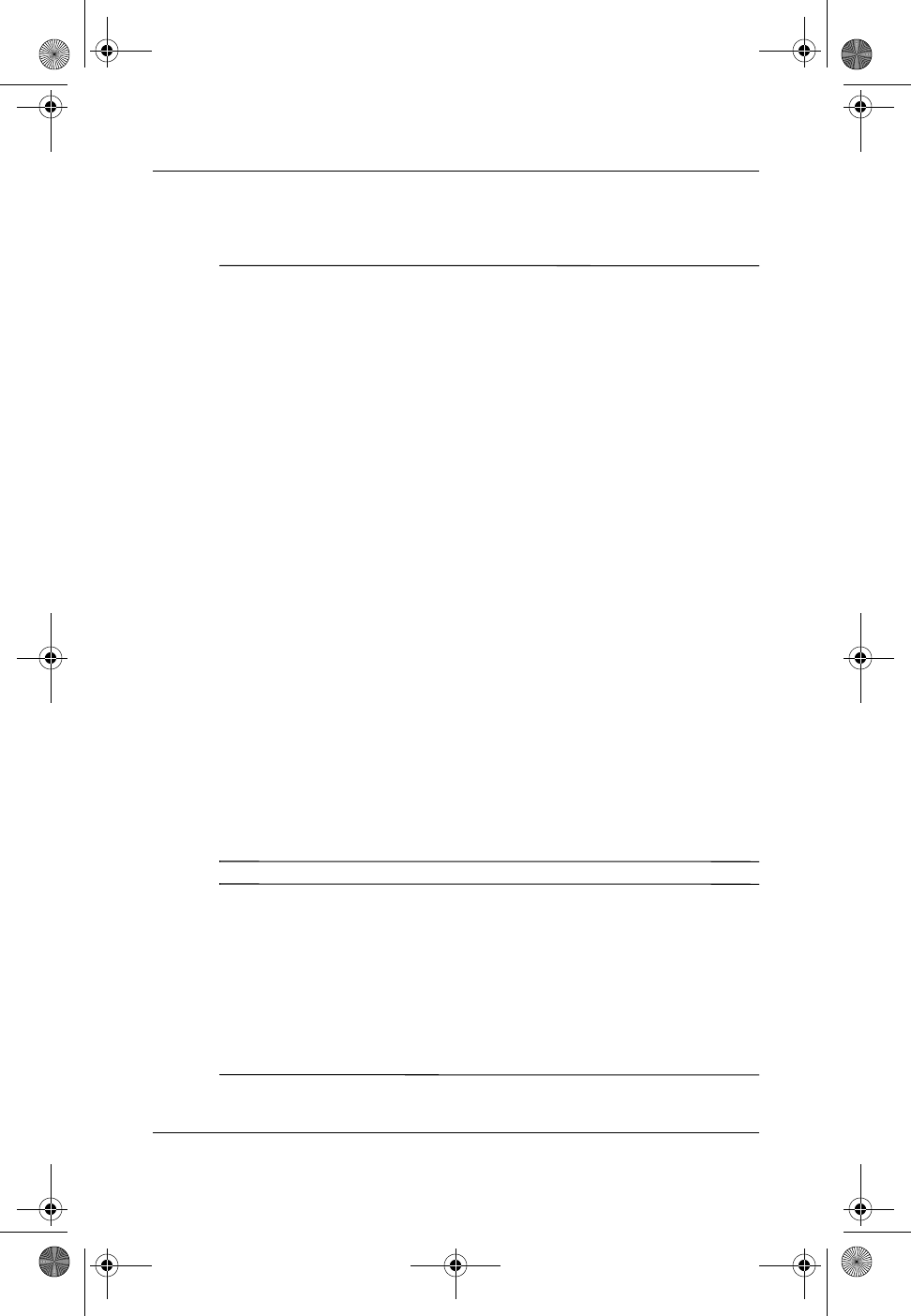
Drives and Drive Media
Startup and Reference Guide—Part 2 5–3
Caring for Drives and Drive Media
ÄCAUTION: To prevent damage to the notebook or a drive and loss
of work:
■Do not remove the internal hard drive except for repair or
replacement. For instructions, see the“Replacing the Internal Hard
Drive” section later in this chapter.
■Electrostatic discharge can damage electronic components.
To prevent electrostatic damage to the notebook or a drive, follow
these 2 precautions: (1) Discharge yourself from static electricity
before handling a drive by touching a grounded metal object and
(2) Avoid touching the connectors on a drive. For more information
about preventing electrostatic damage, refer on the Documentation
Library CD to the Regulatory and Safety Notices guide,
“Electrostatic Discharge” section.
■Excessive force can damage drive connectors. When you insert a
drive, use only enough force to seat the drive.
■Handle a drive carefully. Do not drop it.
■Avoid exposing a hard drive or a diskette to devices with magnetic
fields. Products with magnetic fields include video and audio tape
erasure products, monitors, and speakers. Security devices with
magnetic fields include airport walk-through devices and security
wands. The airport security devices that check carry-on luggage,
usually while it is placed on a conveyor belt, use x-rays instead of
magnetism and will not damage a hard drive or a diskette.
■Do not spray a drive with cleaners.
■Avoid exposing a drive to liquids or temperature extremes.
■If you mail a drive, ship it in packaging that protects it from shock,
vibration, extreme temperatures, and high humidity. Label the
package “FRAGILE.”
ÄCAUTION: To prevent damage to drive media:
■Do not open the metal shutter of a diskette or touch the disk within
the diskette case.
■Do not expose a diskette to a strong magnetic field, such as the
security field used by a walk-through security device or a handheld
security wand.
■Clean a CD or DVD only with a disc cleaning kit, available from
most electronics retailers.
HP-323140-001.book Page 3 Tuesday, April 1, 2003 4:20 PM
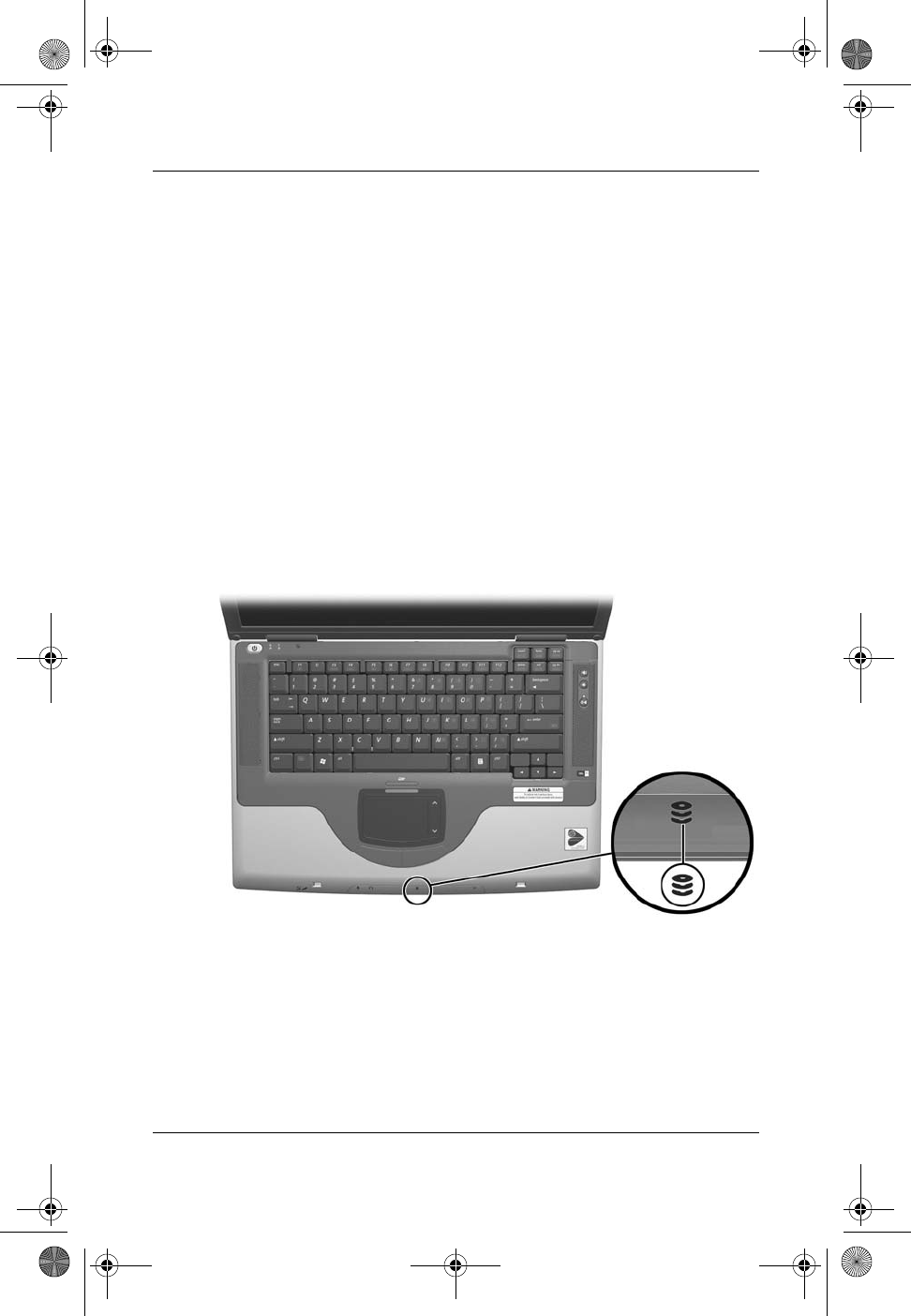
5–4 Startup and Reference Guide—Part 2
Drives and Drive Media
Adding a Drive to the System
The internal hard drive and optical drive are standard features of
the notebook. The type of optical drive varies by notebook model.
An optional drive can be added to the system by connecting it,
as instructed in the drive documentation, to one of the USB
(universal serial bus) connectors or to the 1394 connector. Hard
drive capacity can also be added with a microdrive PC Card. An
SD Card or MMC (multimedia card) can provide additional data
storage.
Using the IDE Drive Light
The IDE (Integrated Drive Electronics) light turns on when the
internal hard drive or optical drive is being accessed.
Identifying the IDE drive light
HP-323140-001.book Page 4 Tuesday, April 1, 2003 4:20 PM
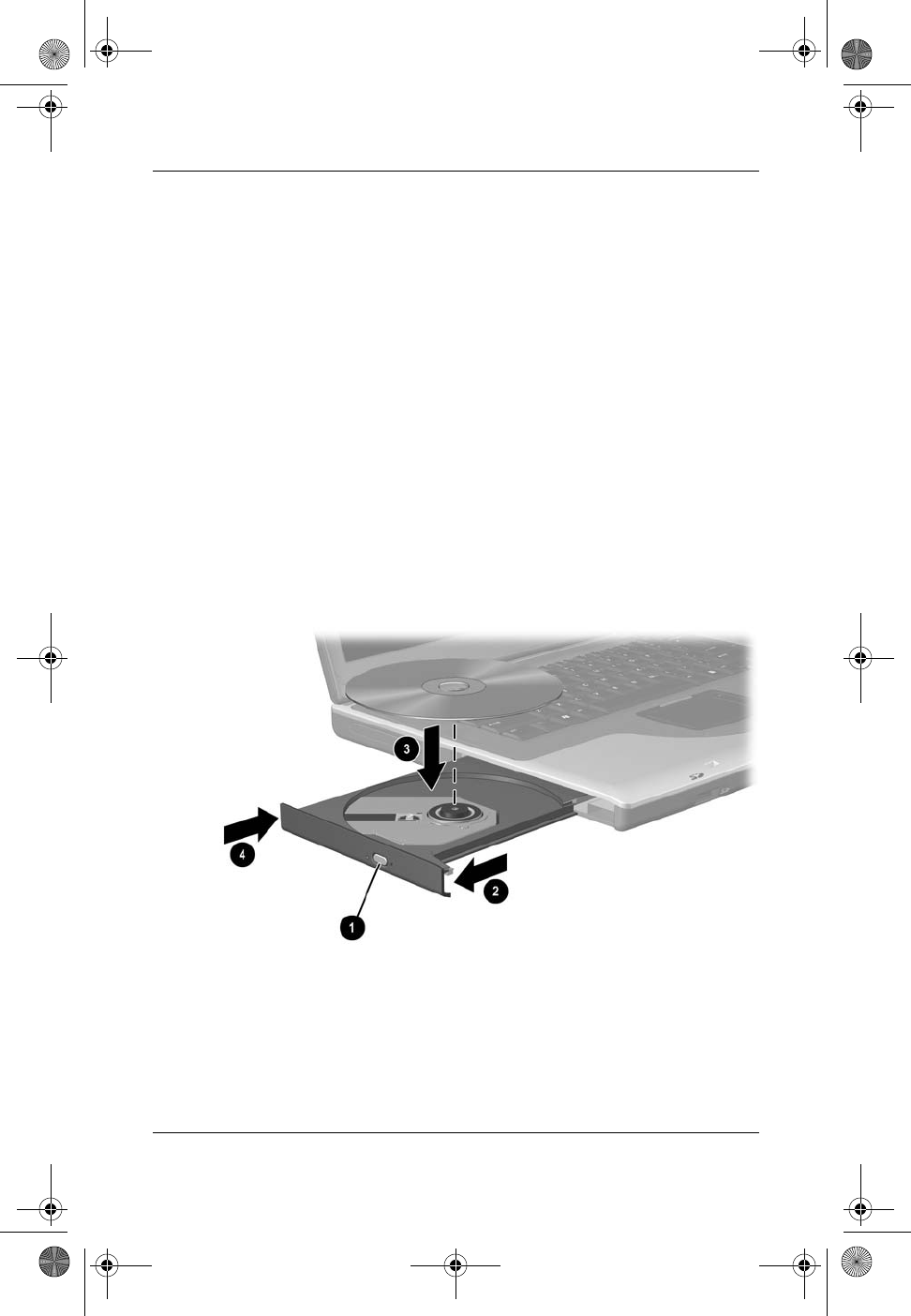
Drives and Drive Media
Startup and Reference Guide—Part 2 5–5
Inserting or Removing a Disc
Inserting a Disc
1. Turn on the notebook.
2. Press the release button 1 on the drive bezel to release the
media tray, then pull the tray outward until it is fully
extended 2.
3. Position a CD or one-sided DVD over the tray, label side up.
4. Gently press the center of the disc onto the tray spindle 3
until the disc snaps into place. Handle the disc by the edges,
not the flat surfaces. (If the media tray is not fully extended,
tilt the disc to position it over the tray spindle, then press it
downward into position.)
5. Close the media tray 4.
Inserting a disc into the optical drive
HP-323140-001.book Page 5 Tuesday, April 1, 2003 4:20 PM
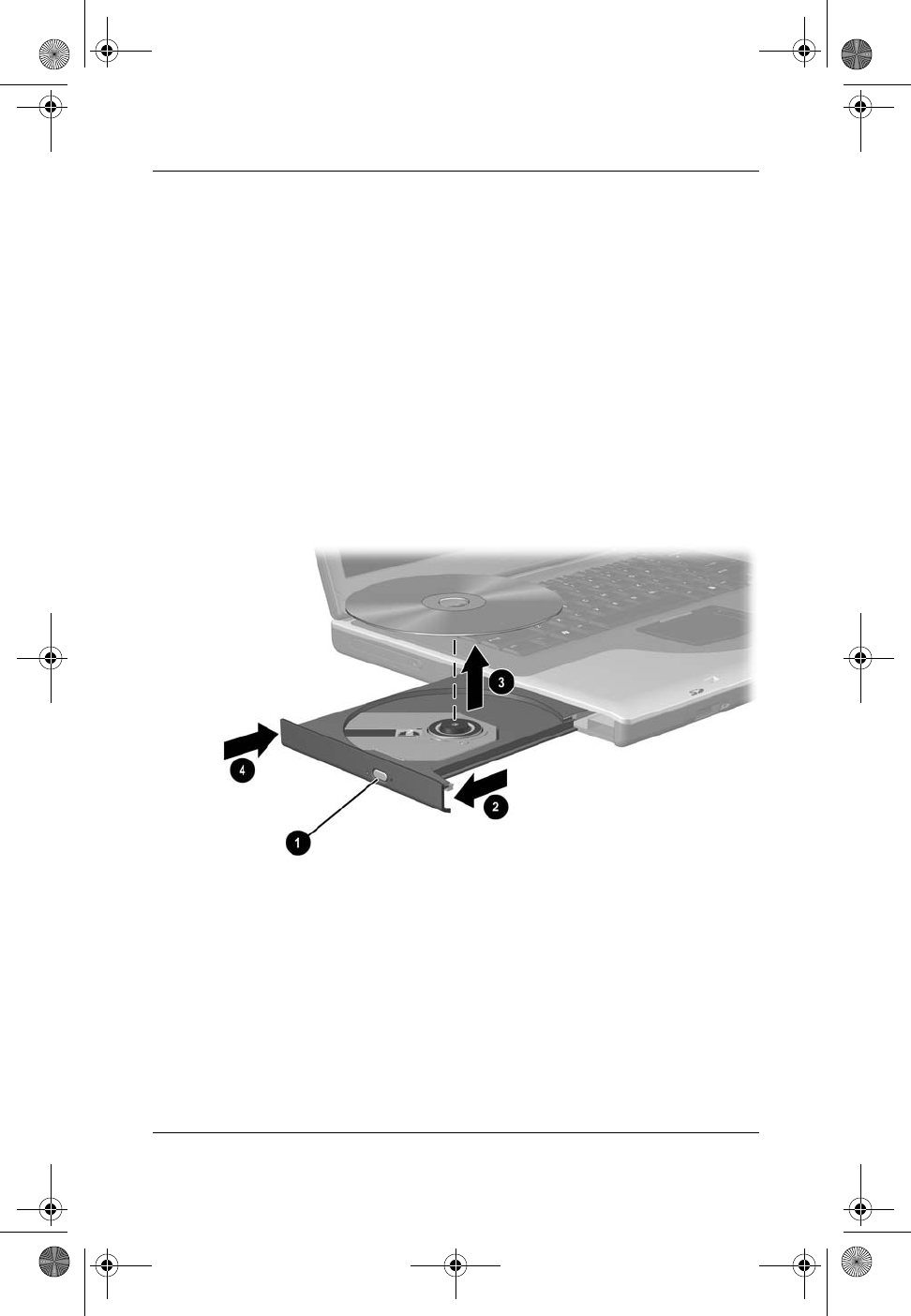
5–6 Startup and Reference Guide—Part 2
Drives and Drive Media
Removing a Disc (With Power)
1. Turn on the notebook.
2. Press the release button 1 on the drive bezel to release the
media tray, then pull the tray outward until it is fully
extended 2.
3. Remove the disc from the tray by gently pushing down on the
spindle while pulling up on the outer edges of the disc 3.
Handle the disc by the edges, not the flat surfaces. If the
media tray is not fully extended, tilt the disc as you remove it.
4. Close the media tray 4.
5. Place the disc in a protective case.
Removing a disc from the optical drive when power is available
HP-323140-001.book Page 6 Tuesday, April 1, 2003 4:20 PM
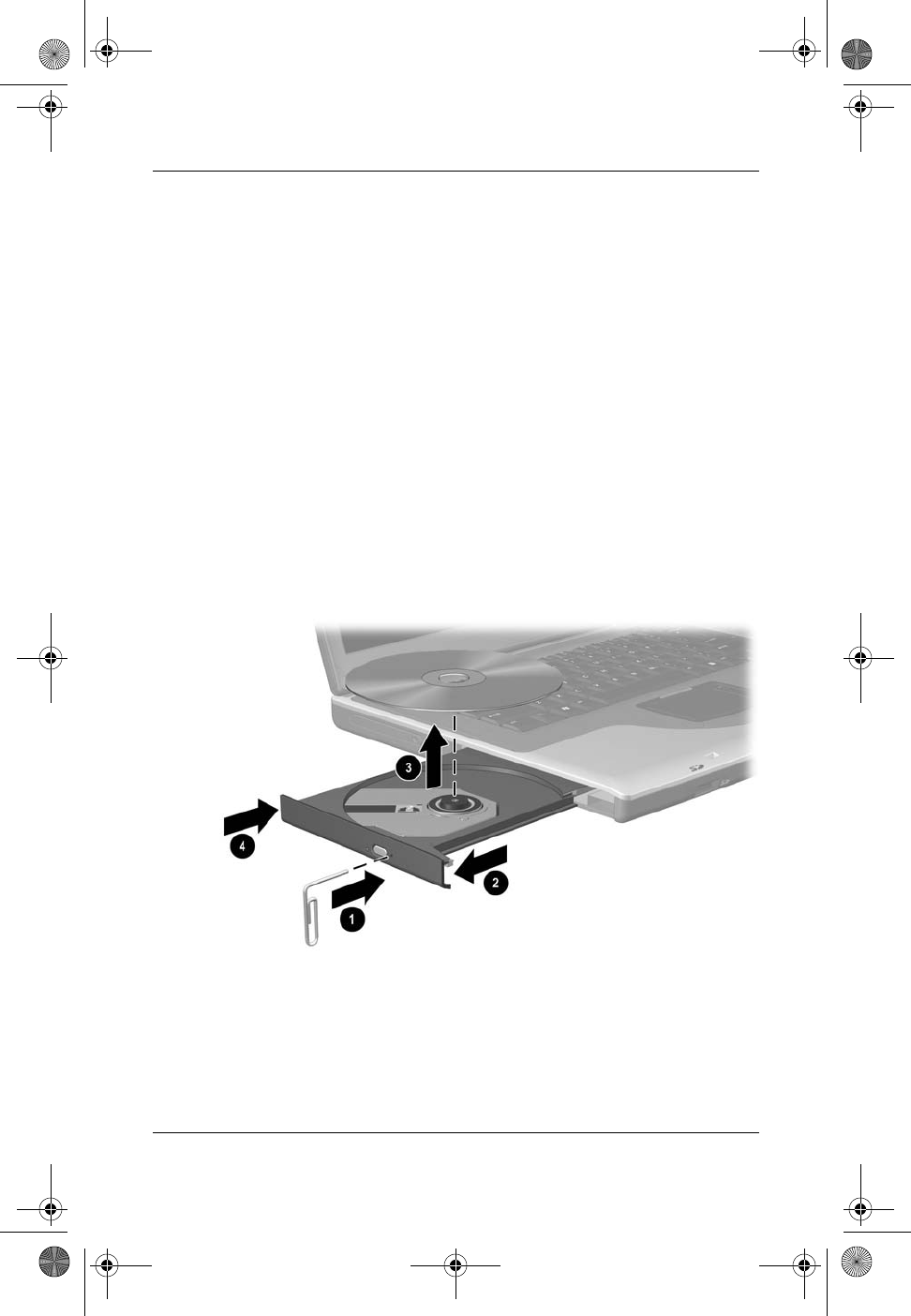
Drives and Drive Media
Startup and Reference Guide—Part 2 5–7
Removing a Disc (Without Power)
If the notebook is turned off or if no power is available, the
release button on the optical drive will not work. To remove a disc
from an optical drive without using the release button:
1. Insert the end of a small object like a paper clip into the
release access 1 in the front bezel of the drive.
2. Press gently on the paper clip until the media tray is released,
then pull the tray outward until it is fully extended 2.
3. Remove the disc from the tray by gently pushing down on the
spindle while pulling up on the outer edges of the disc 3.
Handle the disc by the edges, not the flat surfaces. If the
media tray is not fully extended, tilt the disc as you remove it.
4. Close the media tray 4.
5. Place the disc in a protective case.
Removing a disc from the optical drive when power is not available
HP-323140-001.book Page 7 Tuesday, April 1, 2003 4:20 PM
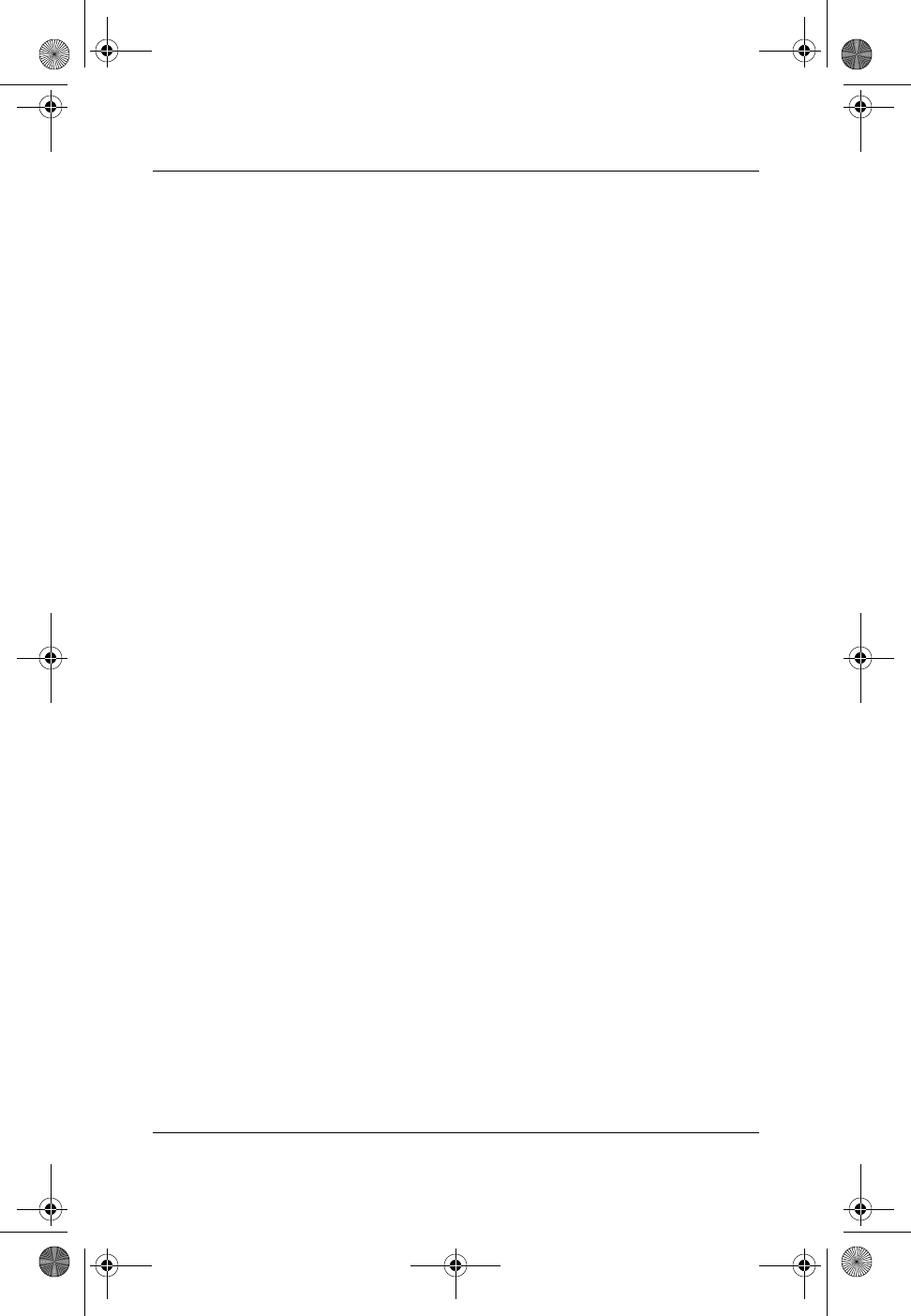
5–8 Startup and Reference Guide—Part 2
Drives and Drive Media
Playing a Disc
You can play a CD in a CD drive or a DVD drive. You can play a
DVD only in a DVD drive.
The information in this section applies to most optical drives and
most disc software. For information about specific disc software,
including Windows Media Player, WinDVD, and Easy CD
Creator, see the “Using Multimedia Software” section in
Chapter 6.
Displaying Media Contents
When you insert a CD or DVD into the system, the notebook can
play the medium, display its contents, take no action, or display a
response prompt on the screen. You can choose how the notebook
responds to the insertion of a medium by using the operating
system AutoPlay feature.
The notebook responds to the following procedures at most
AutoPlay settings:
■To prevent an audio CD from opening when AutoPlay is
enabled on the drive containing it, press the shift key as you
insert the CD.
■To display the contents of a drive medium when the contents
are not displayed by AutoPlay:
1.Insert the medium into the drive.
2. Select Start > Run, then type:
explorer x:
(where x= the drive designation of the drive containing
the medium).
3. Select the OK button.
HP-323140-001.book Page 8 Tuesday, April 1, 2003 4:20 PM
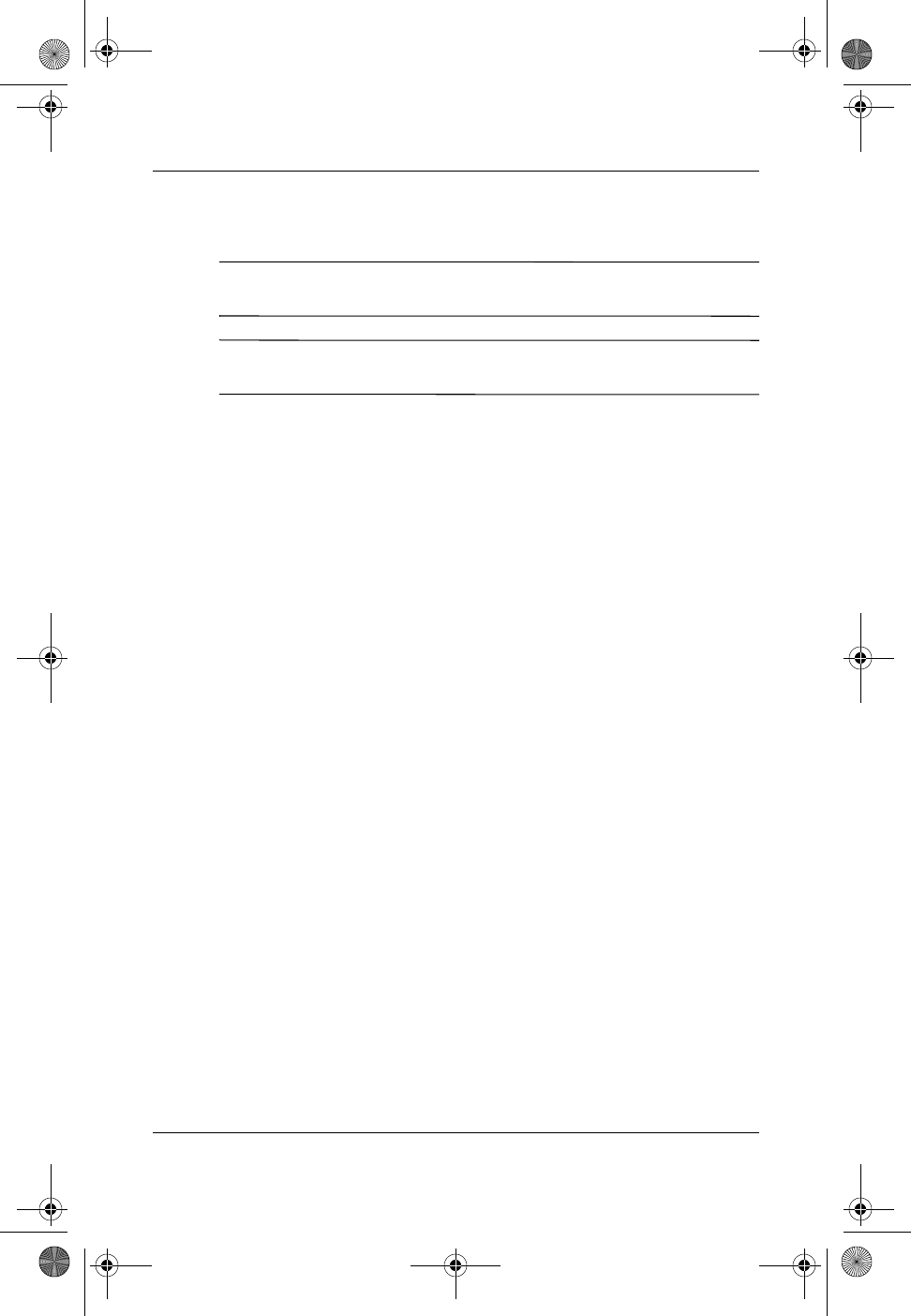
Drives and Drive Media
Startup and Reference Guide—Part 2 5–9
Protecting Playback
ÄCAUTION: Inserting or removing any device while running any
multimedia application may pause or stop the play.
ÄCAUTION: Initiating Standby or Hibernation while playing a drive
medium may stop the play or diminish the quality of the play.
If Standby or Hibernation is accidentally initiated during
playback:
■If you see the warning message “Putting the computer into
Hibernation or Standby may stop the playback. Do you want
to continue?” select No. (Audio and video may resume or you
may need to restart the drive medium.)
■If Standby or Hibernation initiates and no warning message is
displayed, resume from Hibernation or Standby by briefly
pressing the power button, then restart the medium.
Observing the Copyright Warning
It is a criminal offense, under applicable copyright laws, to make
unauthorized copies of copyright-protected material, including
computer programs, films, broadcasts, and sound recordings.
This notebook should not be used for such purposes.
HP-323140-001.book Page 9 Tuesday, April 1, 2003 4:20 PM
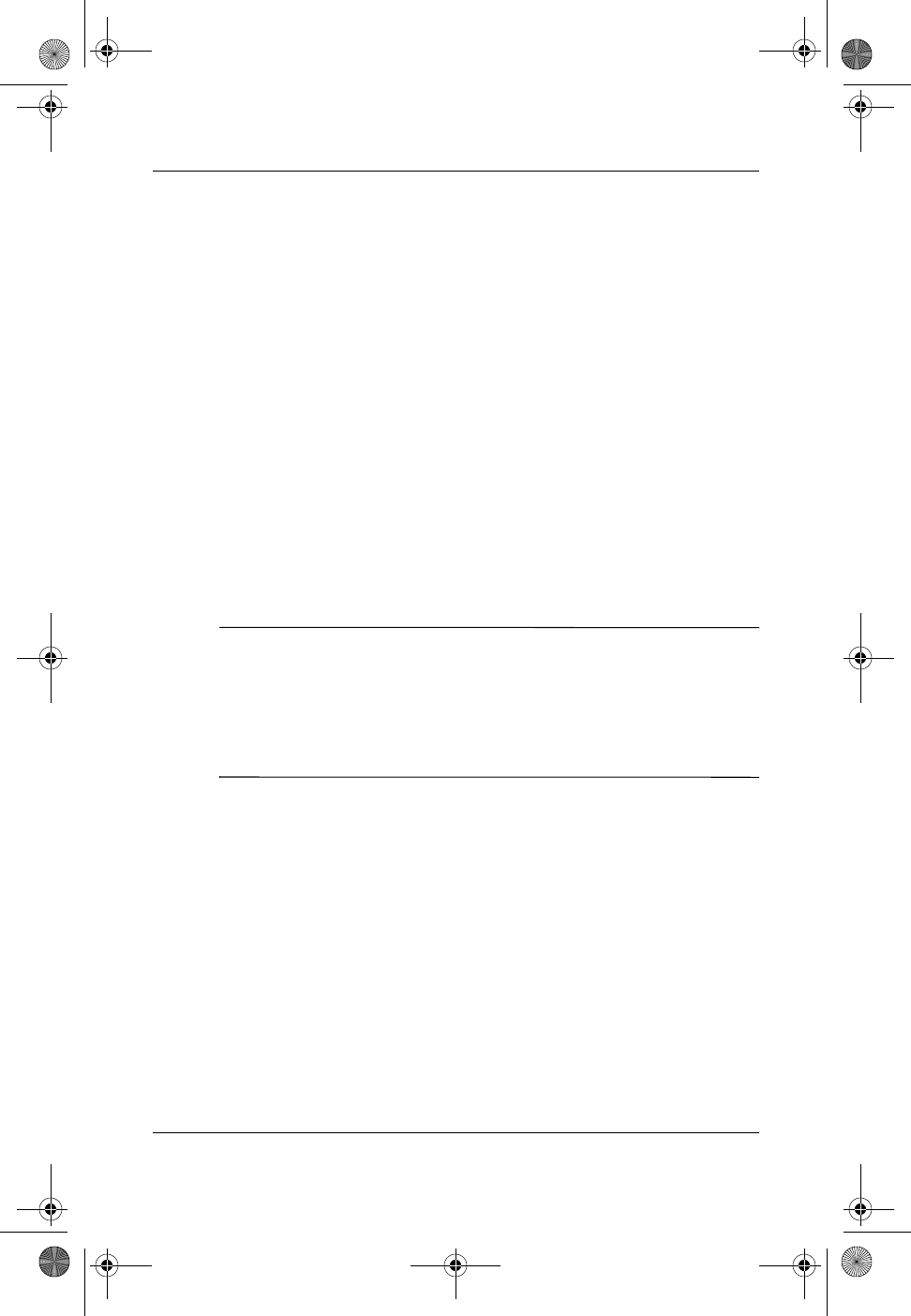
5–10 Startup and Reference Guide—Part 2
Drives and Drive Media
Setting the Boot Order
By default, the notebook starts up from the internal hard drive.
You can set the notebook to start up from any bootable CD or
DVD in the optical drive. A bootable CD or DVD contains files
needed by the notebook to start up and operate properly. On some
models, you can also start up from a drive connected to the
notebook by USB.
Startup preferences are set in the Setup utility. The Setup utility is
not a Windows utility and does not support the TouchPad. For
information about using the Setup utility, see the “Using the
Setup Utility” section in Chapter 9.
Replacing the Internal Hard Drive
The hard drive in the hard drive bay is the internal hard drive.
Remove the internal hard drive only for repair or replacement.
ÄCAUTION: To prevent an unresponsive system and loss of work, do not
begin this procedure until you have:
■Saved your work, closed all open applications, and shut down the
notebook.
■Disconnected the notebook from external power and removed the
battery pack.
1. Save your work and close all open applications.
2. Shut down the notebook and close the display.
3. Disconnect the notebook from external power.
4. Remove the battery pack.
HP-323140-001.book Page 10 Tuesday, April 1, 2003 4:20 PM
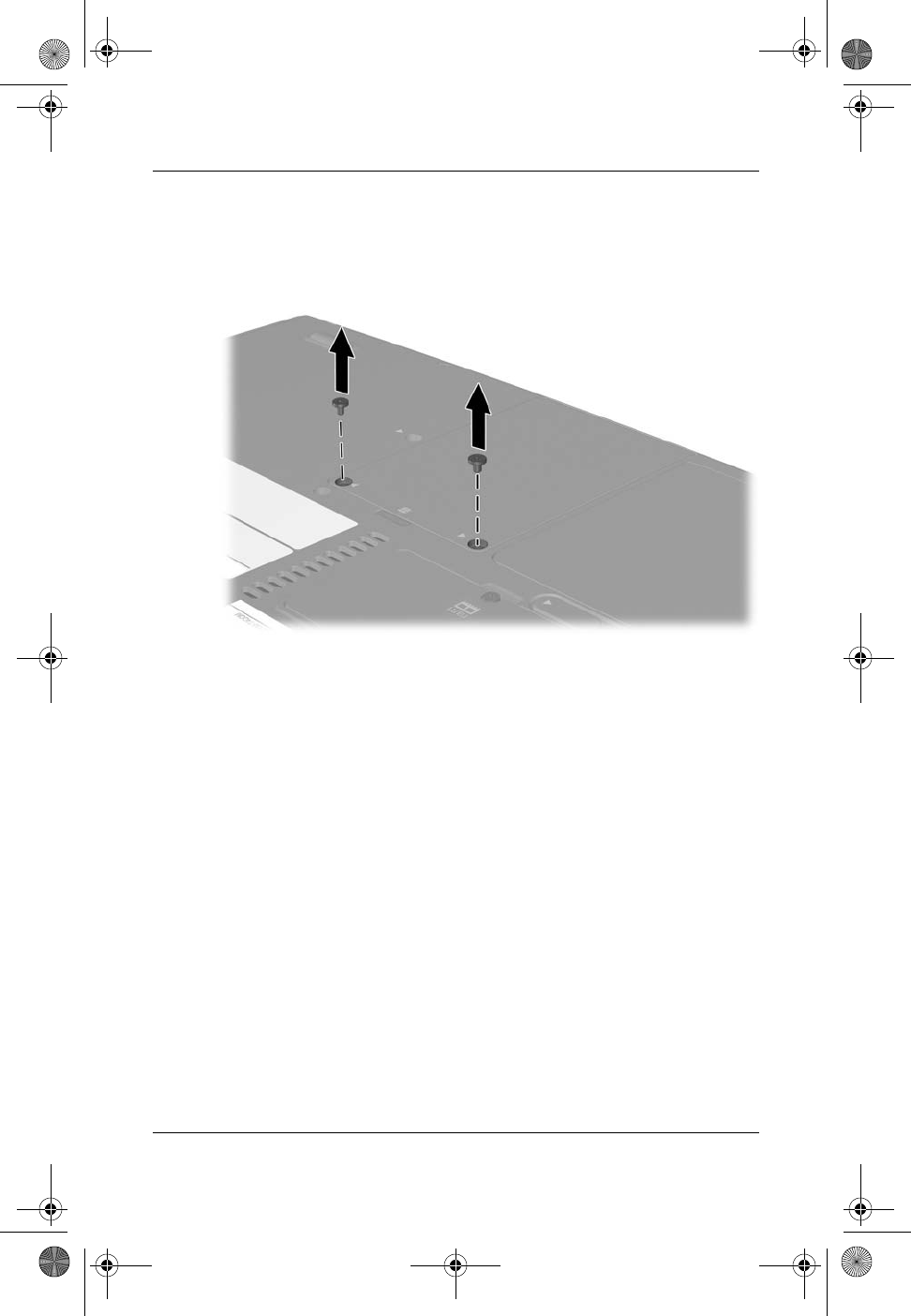
Drives and Drive Media
Startup and Reference Guide—Part 2 5–11
5. Turn the notebook underside up.
6. Remove the 2 hard drive retaining screws.
Removing the hard drive retaining screws
HP-323140-001.book Page 11 Tuesday, April 1, 2003 4:20 PM
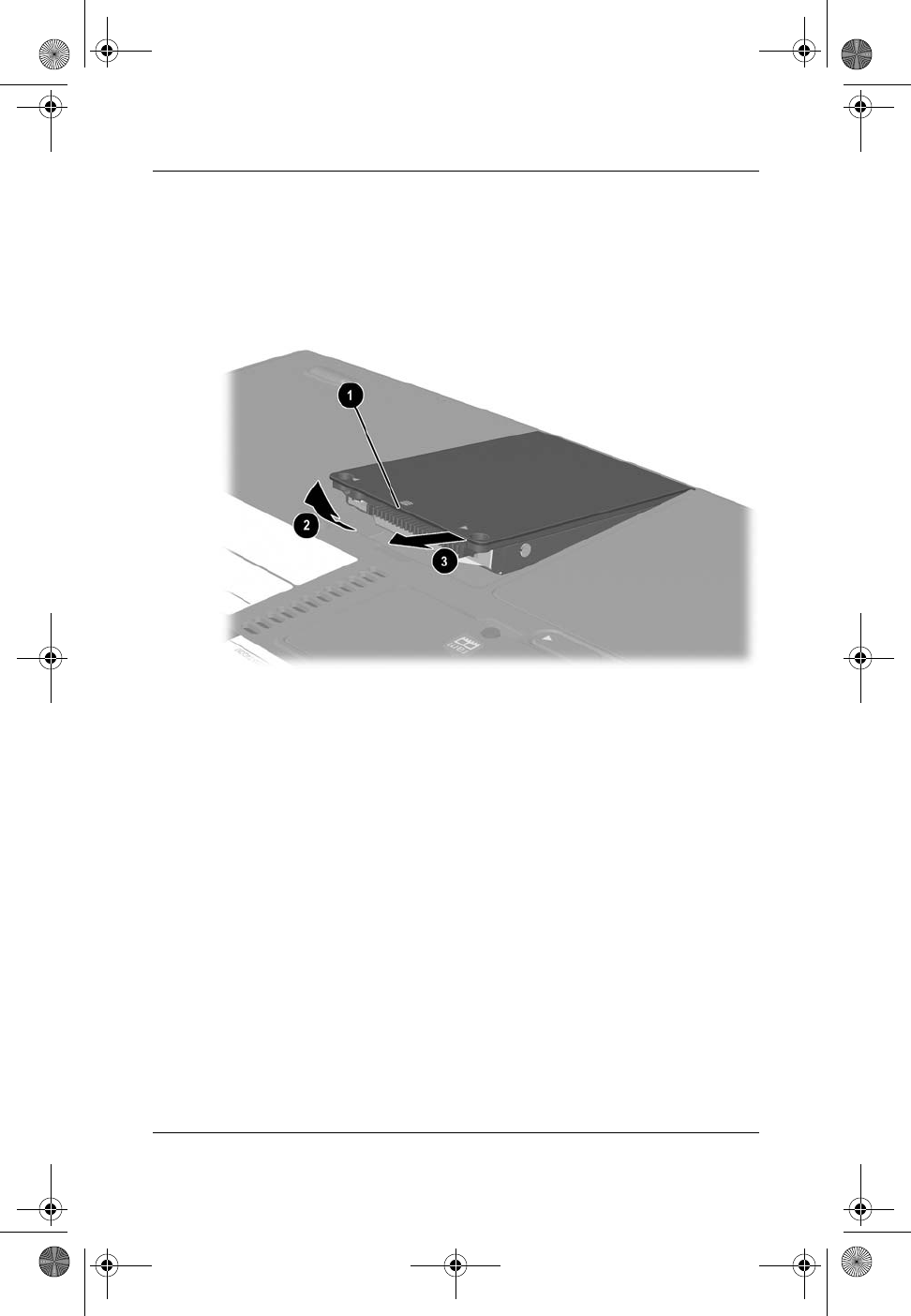
5–12 Startup and Reference Guide—Part 2
Drives and Drive Media
7. To remove a hard drive, grasp the hard drive assembly (the
hard drive, the hard drive cover, and the hard drive bracket)
using the hard drive recess 1. Tilt the hard drive assembly
upward 2, then pull the assembly from the hard drive bay 3.
Removing an internal hard drive from the hard drive bay
HP-323140-001.book Page 12 Tuesday, April 1, 2003 4:20 PM
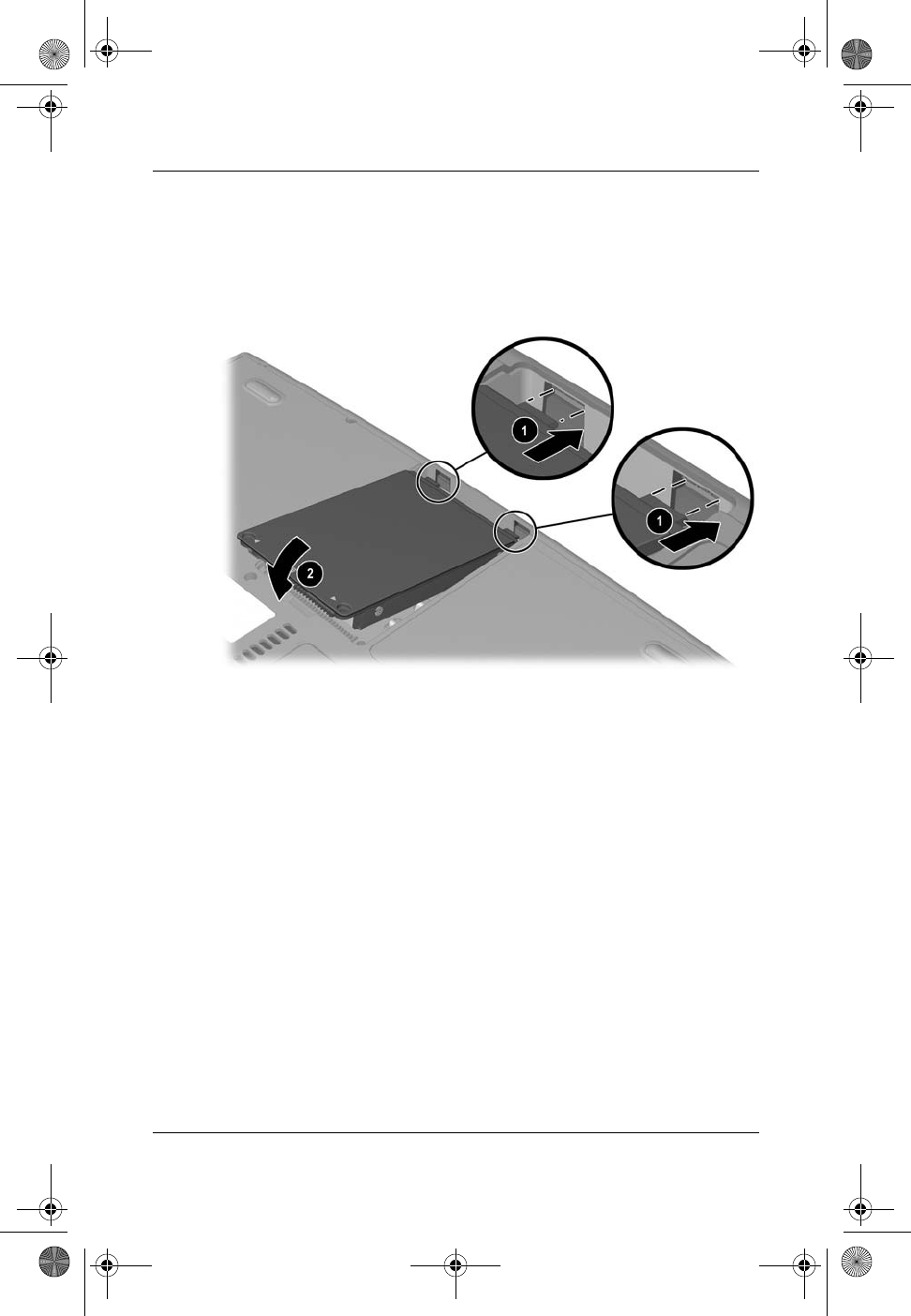
Drives and Drive Media
Startup and Reference Guide—Part 2 5–13
8. To insert a hard drive, insert the 2 alignment tabs on the hard
drive cover into the 2 alignment slots on the hard drive bay 1,
then tilt the hard drive assembly downward into the hard drive
bay until it is seated 2.
Inserting an internal hard drive into the hard drive bay
HP-323140-001.book Page 13 Tuesday, April 1, 2003 4:20 PM
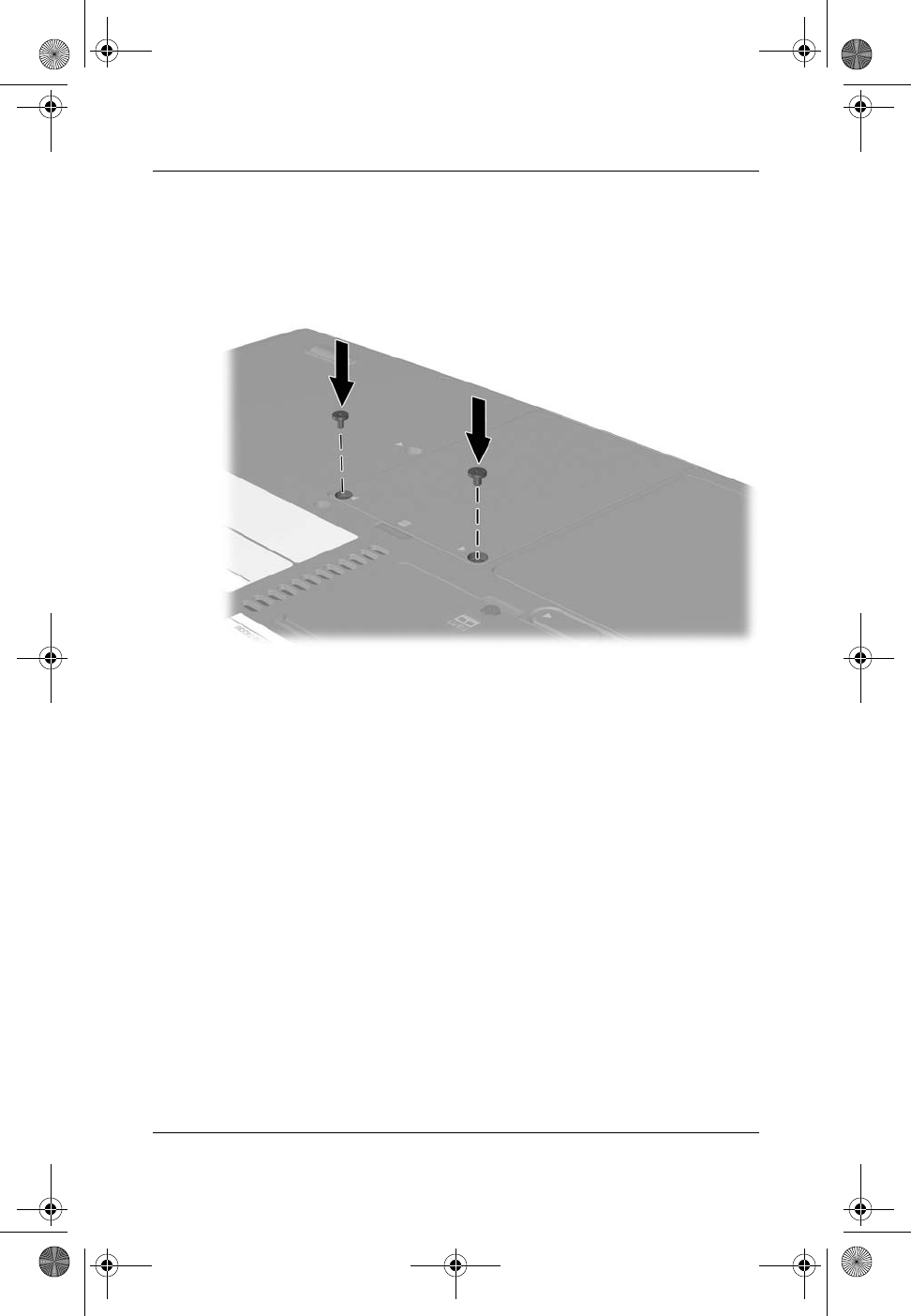
5–14 Startup and Reference Guide—Part 2
Drives and Drive Media
9. If you have inserted a hard drive, reinsert the 2 hard drive
retaining screws. (If you removed but did not replace a hard
drive, put the retaining screws in a safe place.)
Replacing the hard drive retaining screw
HP-323140-001.book Page 14 Tuesday, April 1, 2003 4:20 PM
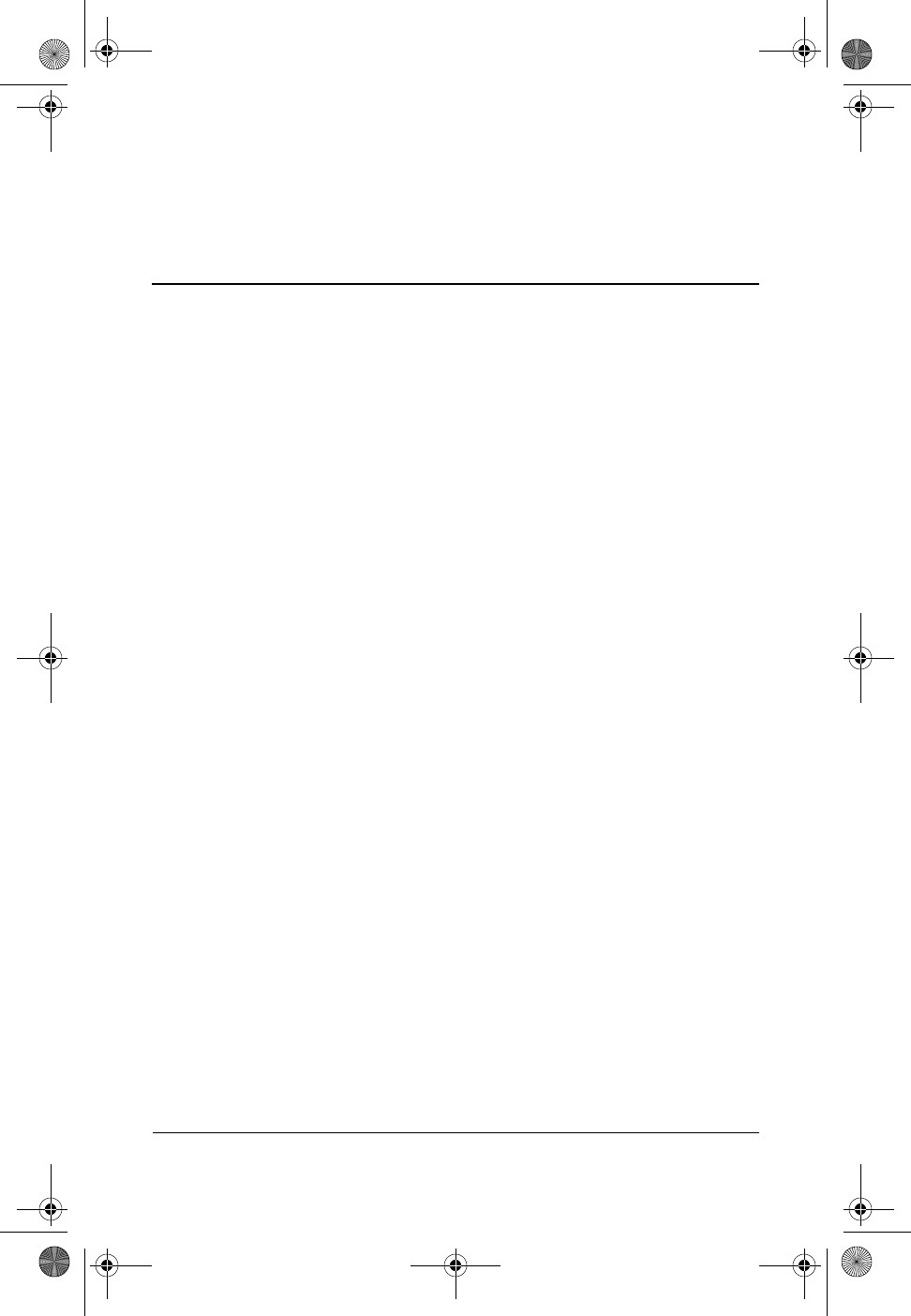
Startup and Reference Guide—Part 2 6–1
6
Multimedia
Contents
Adjusting Volume . . . . . . . . . . . . . . . . . . . . . . . . . . . . . . 6–2
Using the Internal Speakers . . . . . . . . . . . . . . . . . . . . . . . 6–3
Connecting an Audio Device . . . . . . . . . . . . . . . . . . . . . . 6–3
Connecting an S-Video Device . . . . . . . . . . . . . . . . . . . . 6–5
Connecting the Audio . . . . . . . . . . . . . . . . . . . . . . . . 6–5
Connecting the Video . . . . . . . . . . . . . . . . . . . . . . . . 6–5
Turning a Video Device On and Off . . . . . . . . . . . . . 6–6
Changing the Color Television Format . . . . . . . . . . . 6–6
Using Multimedia Software . . . . . . . . . . . . . . . . . . . . . . . 6–7
Using Windows Media Player. . . . . . . . . . . . . . . . . . 6–7
Using WinDVD . . . . . . . . . . . . . . . . . . . . . . . . . . . . . 6–7
Using Easy CD Creator . . . . . . . . . . . . . . . . . . . . . . . 6–9
HP-323140-001.book Page 1 Tuesday, April 1, 2003 4:20 PM
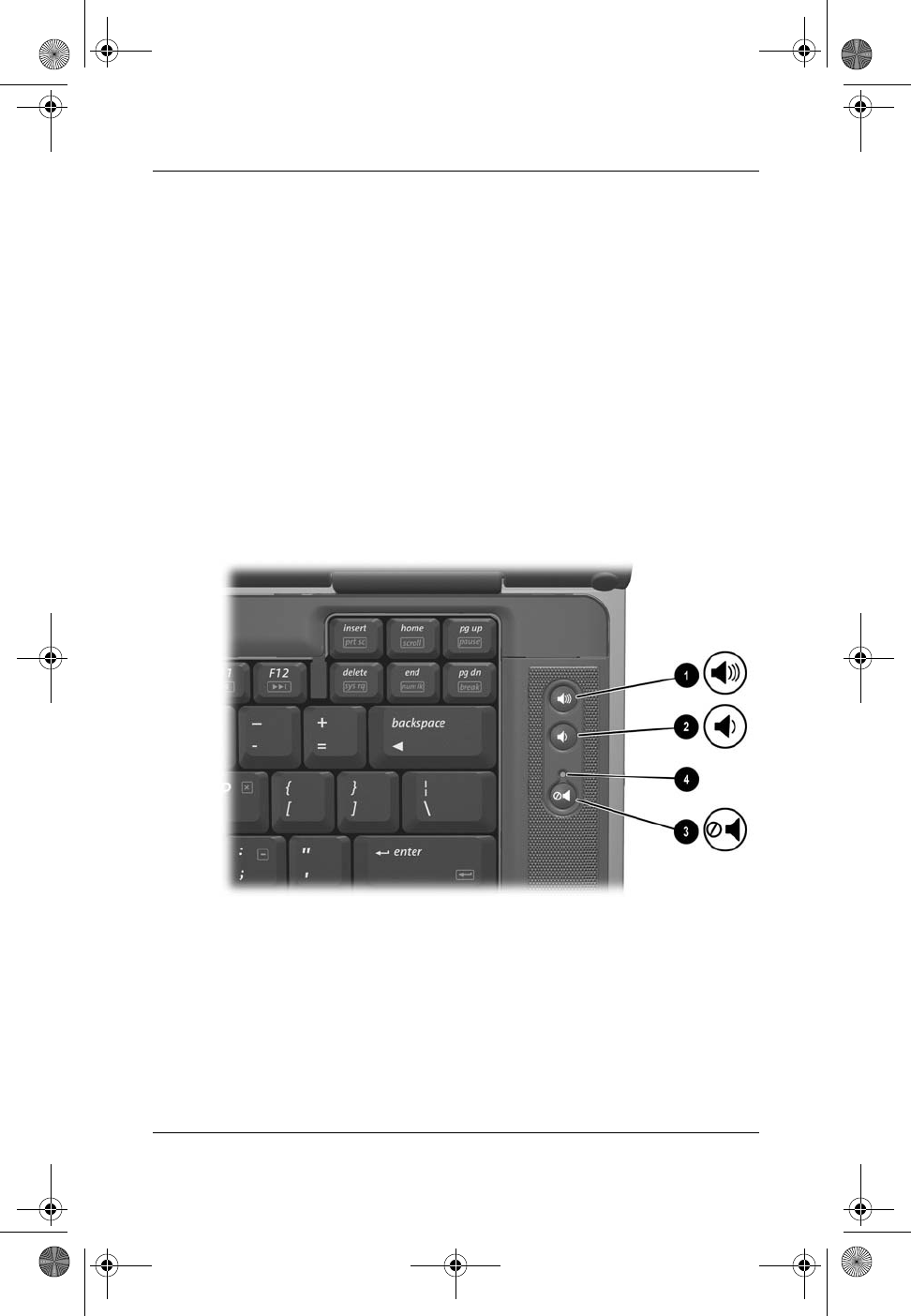
6–2 Startup and Reference Guide—Part 2
Multimedia
Adjusting Volume
Volume can be adjusted by using the audio buttons on the
notebook or by using operating system or application volume
control software. The mute button overrides all software volume
settings.
To adjust volume using the audio buttons:
■To increase volume, press the increase volume button 1.
■To decrease volume, press the decrease volume button 2.
■To mute or restore volume, press the mute button 3.
When volume is muted, the mute light 4 turns on. When volume
is restored, the mute light turns off.
Identifying the audio buttons and mute light
HP-323140-001.book Page 2 Tuesday, April 1, 2003 4:20 PM
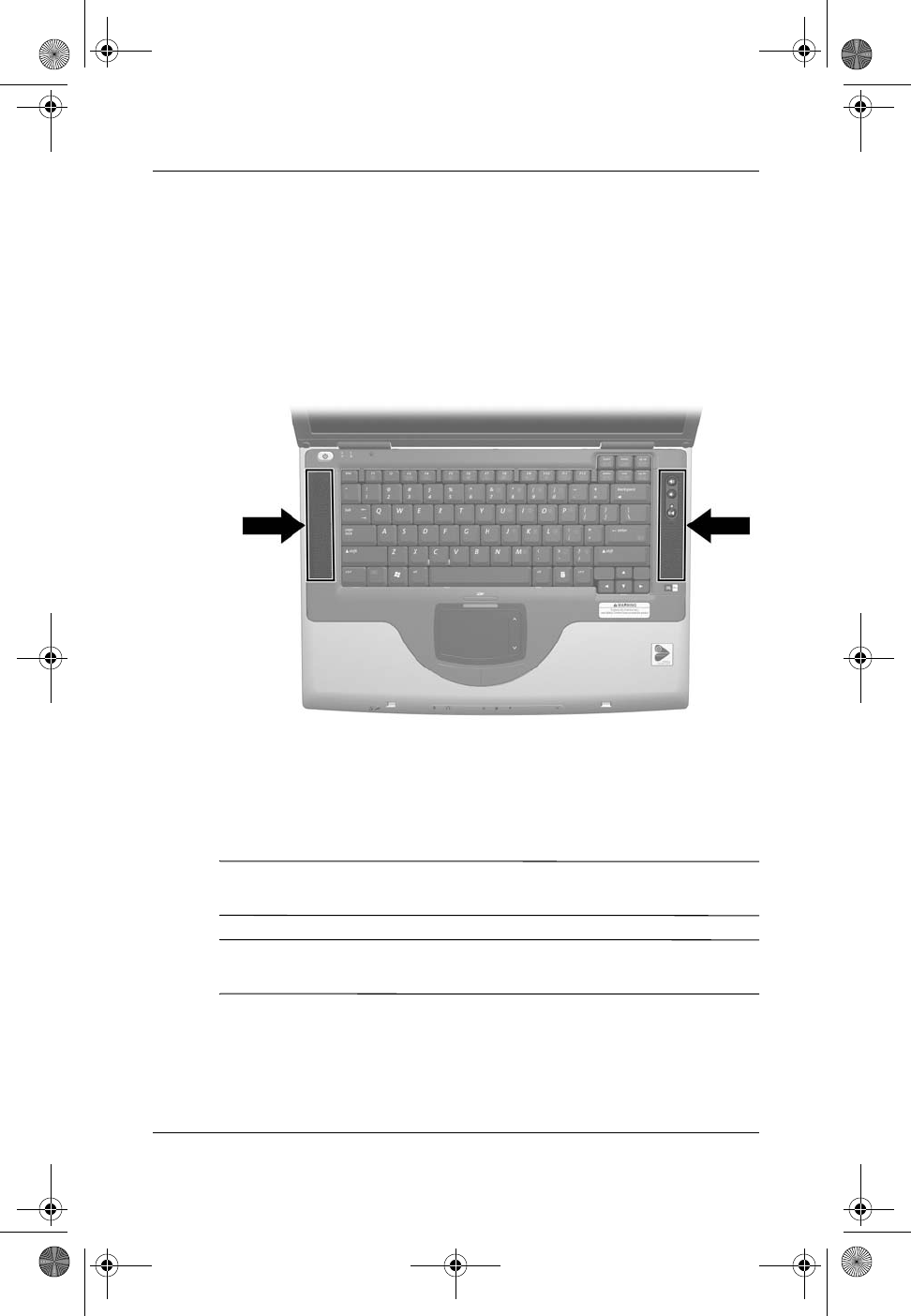
Multimedia
Startup and Reference Guide—Part 2 6–3
Using the Internal Speakers
The internal speakers play sound in stereo from applications, the
operating system, games, drive media, the Internet, and other
sources.
If an external device, such as a headset, is connected to the
audio-out jack, the internal speakers are disabled.
Identifying the internal speakers
Connecting an Audio Device
ÅWARNING: To reduce the risk of personal injury, adjust the volume
before putting on headphones or a headset.
ÄCAUTION: To prevent possible damage to an external device, do not
plug a monaural (single sound channel) plug into the audio-out jack.
HP-323140-001.book Page 3 Tuesday, April 1, 2003 4:20 PM
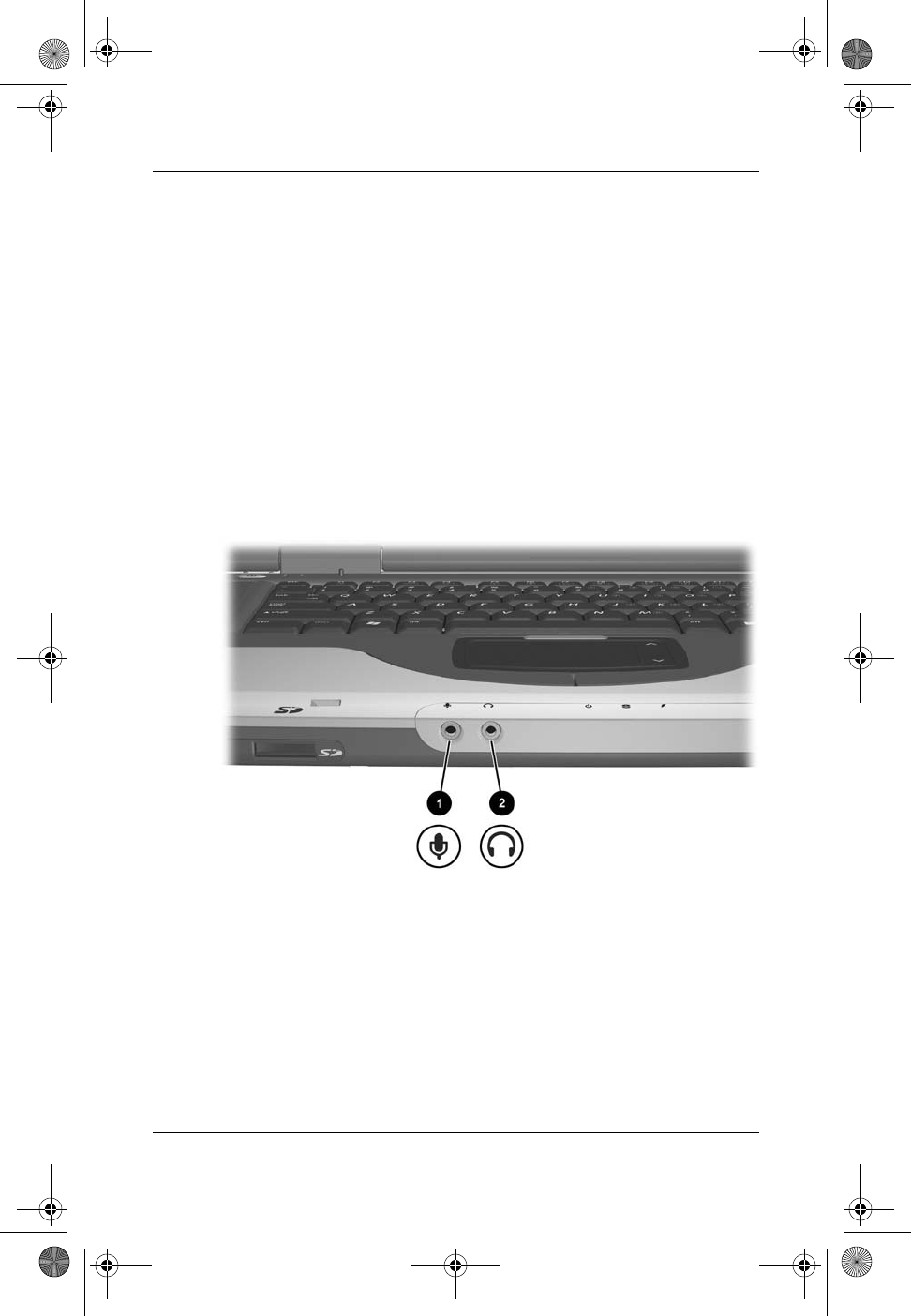
6–4 Startup and Reference Guide—Part 2
Multimedia
The notebook has 2 audio jacks:
■The microphone jack 1 connects an optional monaural or
stereo microphone. If a monaural microphone is connected,
the same information is recorded on both channels.
■The audio-out jack 2, sometimes called a line-out jack,
connects headphones or powered external stereo speakers.
The audio-out jack is also used to connect the audio functions
of an audio/video device such as a television or VCR. When
you connect a device to the audio-out jack:
❏Use only a 3.5-mm plug.
❏The internal speakers are disabled.
Identifying the audio jacks
HP-323140-001.book Page 4 Tuesday, April 1, 2003 4:20 PM
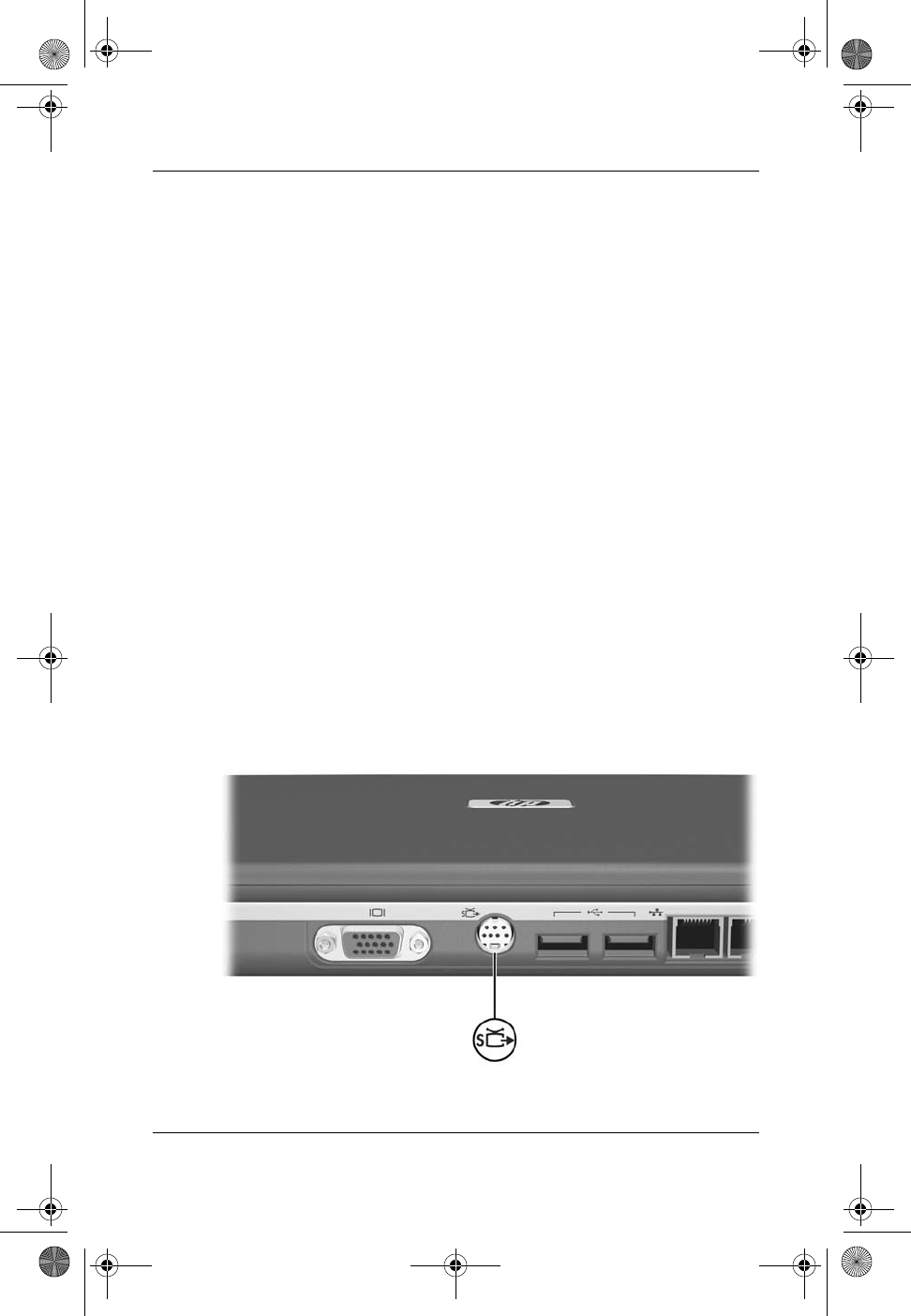
Multimedia
Startup and Reference Guide—Part 2 6–5
Connecting an S-Video Device
Connecting the Audio
The S-Video jack supports video signals only.
If you are setting up a configuration that combines audio and
video functions, such as playing a DVD movie on your notebook
and displaying it on your television, you will need a standard
3.5-mm audio cable available from most computer or electronics
retailers.
Plug the stereo end of the audio cable into the notebook audio-out
jack. Plug the other end of the cable into the audio input jack on
the external device.
Connecting the Video
To transmit video signals through the S-Video jack, you will need
a standard S-Video cable available from most computer or
electronics retailers.
Plug either end of the S-Video cable into the notebook S-Video
jack. Plug the other end of the cable into the S-Video input jack
on the external device.
Identifying the S-Video jack
HP-323140-001.book Page 5 Tuesday, April 1, 2003 4:20 PM
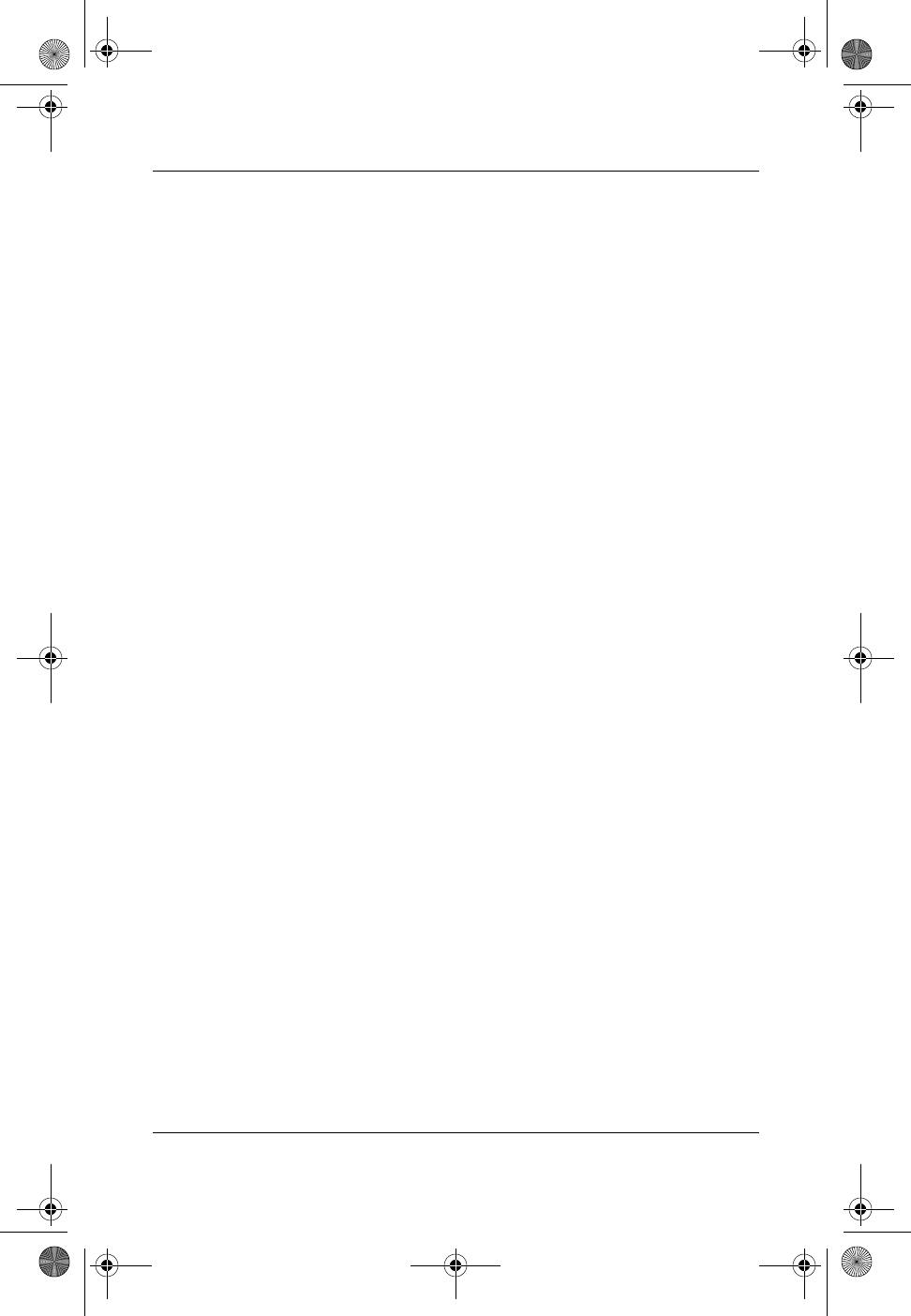
6–6 Startup and Reference Guide—Part 2
Multimedia
Turning a Video Device On and Off
To turn on a video device that is connected to the notebook, start
or restart the notebook. Or, repeatedly press the Fn+F4 hotkeys to
switch the image. Pressing the Fn+F4 hotkeys switches the image
among the notebook display, any connected displays, and
simultaneous display on the notebook and all connected displays.
■Switching the image to a connected video device turns on the
video device.
■Switching the image to the notebook display only turns off
the video device.
Changing the Color Television Format
Color television formats are modes by which television video
signals are sent and received. To send signals between the
notebook and a television, both the notebook and the television
must be using the same color television format.
The NTSC format is common in the United States, Canada,
Japan, and South Korea. The PAL format is common in Europe,
China, Russia, and Africa, and the PAL-M format is common in
Brazil. Other South American and Central American countries
may use NTSC, PAL, or PAL-M.
Region-specific formats are set at the factory for most notebooks,
but the region setting can be changed on any notebook.
Color television format settings are changed in the Setup utility.
The Setup utility is not a Windows utility and does not support
the TouchPad. For information about using the Setup utility, see
the “Using the Setup Utility” section in Chapter 9.
HP-323140-001.book Page 6 Tuesday, April 1, 2003 4:20 PM
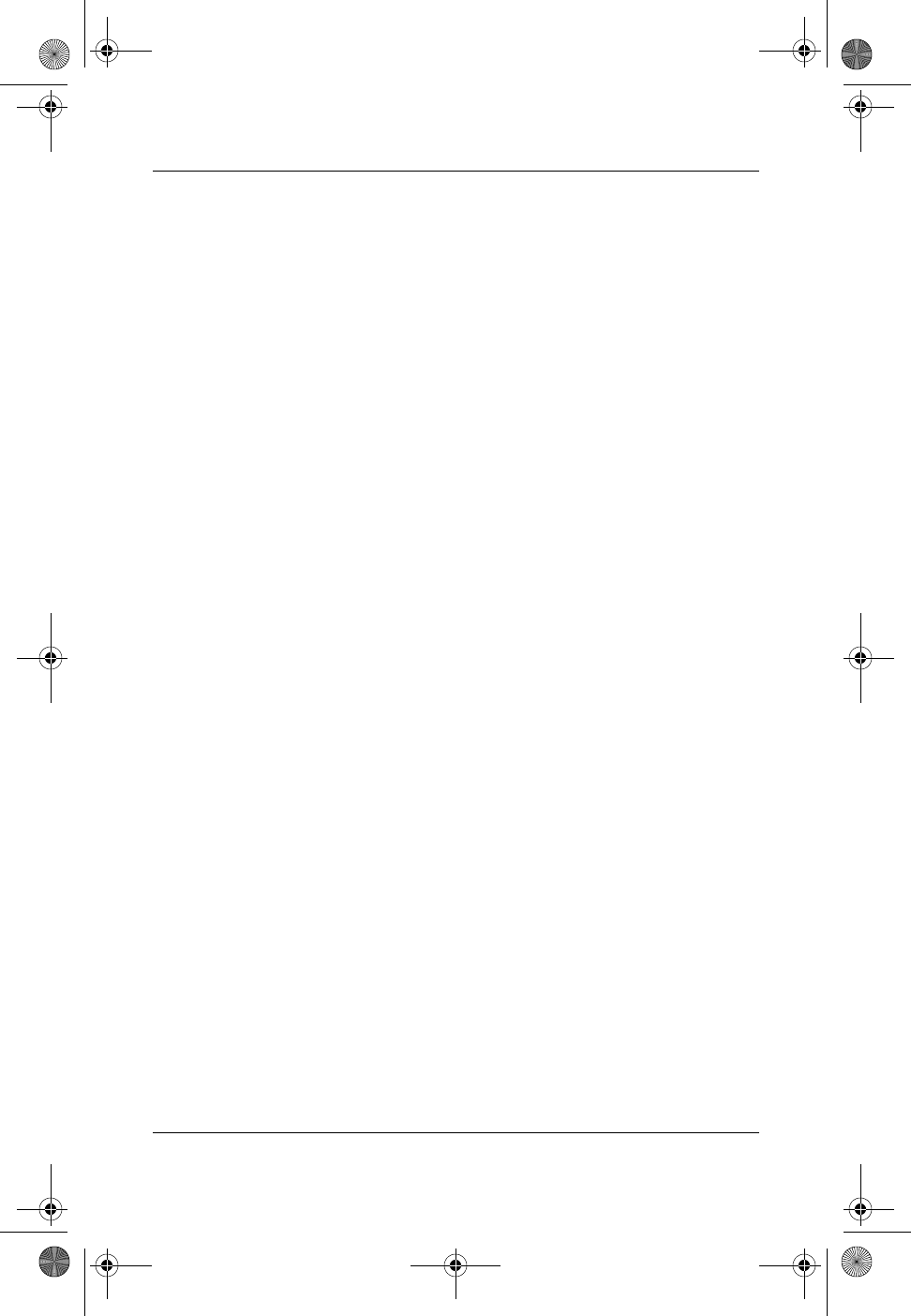
Multimedia
Startup and Reference Guide—Part 2 6–7
Using Multimedia Software
Using Windows Media Player
Use Windows Media Player primarily for playing audio CDs.
Although video CDs can be played using Windows Media Player,
InterVideo WinDVD provides higher quality playback.
To open Windows Media Player, insert a CD into the optical
drive, then close the tray. Wait several seconds. If Windows
Media Player does not open, select Start > All Programs >
Windows Media Player.
To play or stop the CD, use the on-screen Play button or Stop
button, or use the media hotkeys described in the “Hotkeys”
section of Chapter 3.
Using WinDVD
WinDVD is an application that enables you to play DVD movies
or video CDs. If WinDVD is included with your notebook, the
application is preinstalled.
Playing a DVD or Video CD
For best playback quality, save and close all files and software
unrelated to playing the DVD or video CD.
If a DVD displays a Playback Of Content From This Region Is
Not Permitted error message, stop the DVD, change the region
setting, then restart the DVD. For information about changing the
region setting, see “Managing DVD Region Settings” next in this
chapter.
To play a DVD or video CD:
1. Insert the DVD or video CD into the optical drive.
2. Assign WinDVD to play the video:
❏If the Microsoft Windows XP AppPicker window is
displayed, select Play Video By Using WinDVD.
HP-323140-001.book Page 7 Tuesday, April 1, 2003 4:20 PM
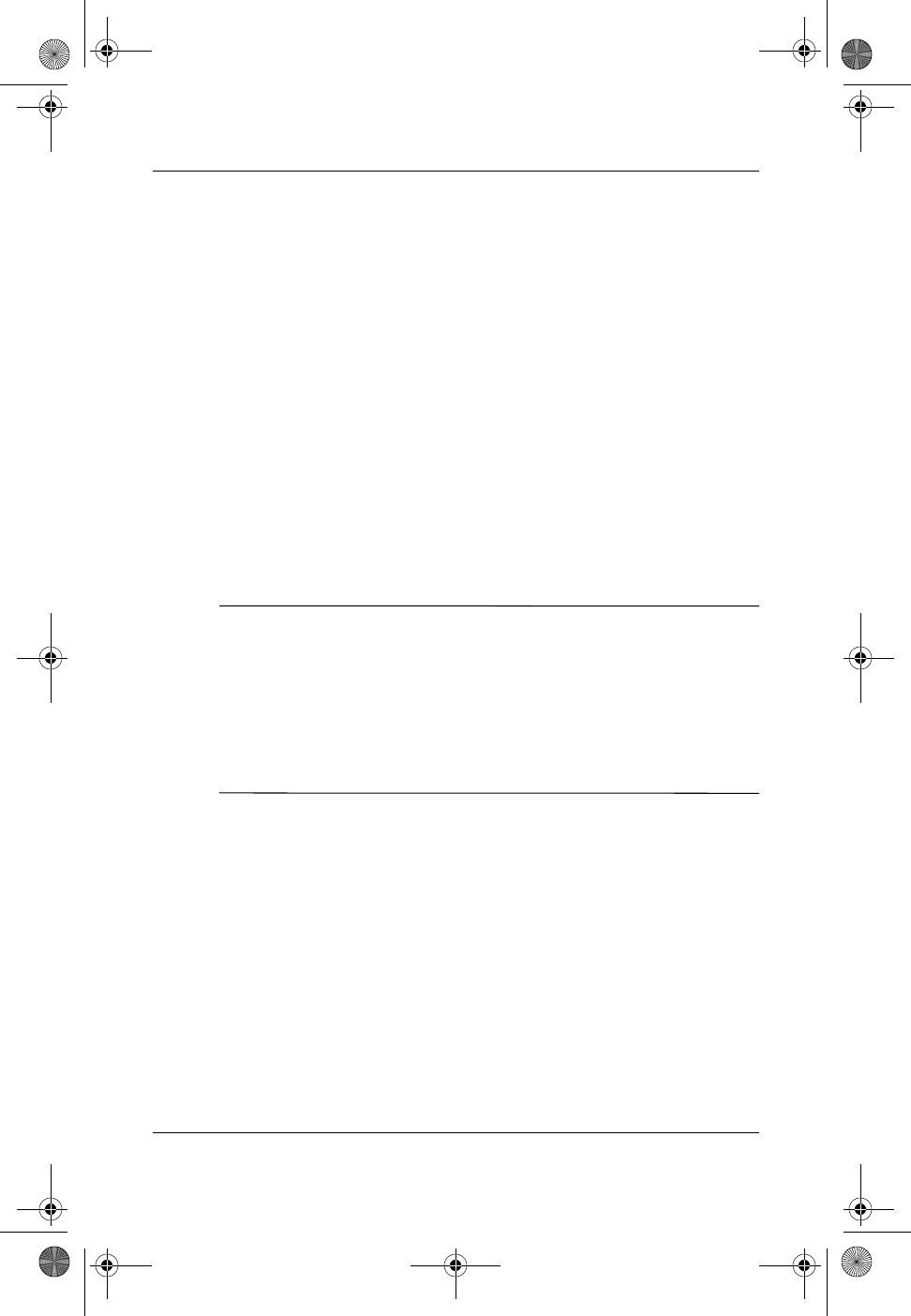
6–8 Startup and Reference Guide—Part 2
Multimedia
❏If the Microsoft Windows XP AppPicker window is not
displayed, select Start > All Programs > InterVideo
WinDVD > InterVideo WinDVD.
3. Follow the instructions on the screen.
Managing DVD Region Settings
Most DVDs that contain copyrighted files also contain region
codes. The region codes help protect copyrights internationally.
You can play a DVD containing a region code only if the region
code on the DVD matches the region setting on your DVD drive.
If the region code on a DVD does not match the region setting
on your drive, a Playback Of Content From This Region Is Not
Permitted message is displayed when you insert the DVD. To
play the DVD, you must change the region setting on your
DVD drive.
ÄCAUTION: The region setting on your DVD drive can be changed only
5times.
■The region setting you select the fifth time becomes the permanent
region setting on the drive.
■The number of allowable region changes remaining on the drive is
displayed in the Remaining Times Until Permanent field in the
WinDVD window. The number in the field includes the fifth and
permanent change.
To change the region setting on drive media:
1. Insert the DVD into the optical drive.
2. If WinDVD does not open after a short pause, select Start >
All Programs > InterVideo WinDVD > InterVideo WinDVD.
3. Select the Properties icon in the lower right corner of the
window.
4. Select the General tab.
5. Select the button for the region.
6. Select the OK button.
HP-323140-001.book Page 8 Tuesday, April 1, 2003 4:20 PM
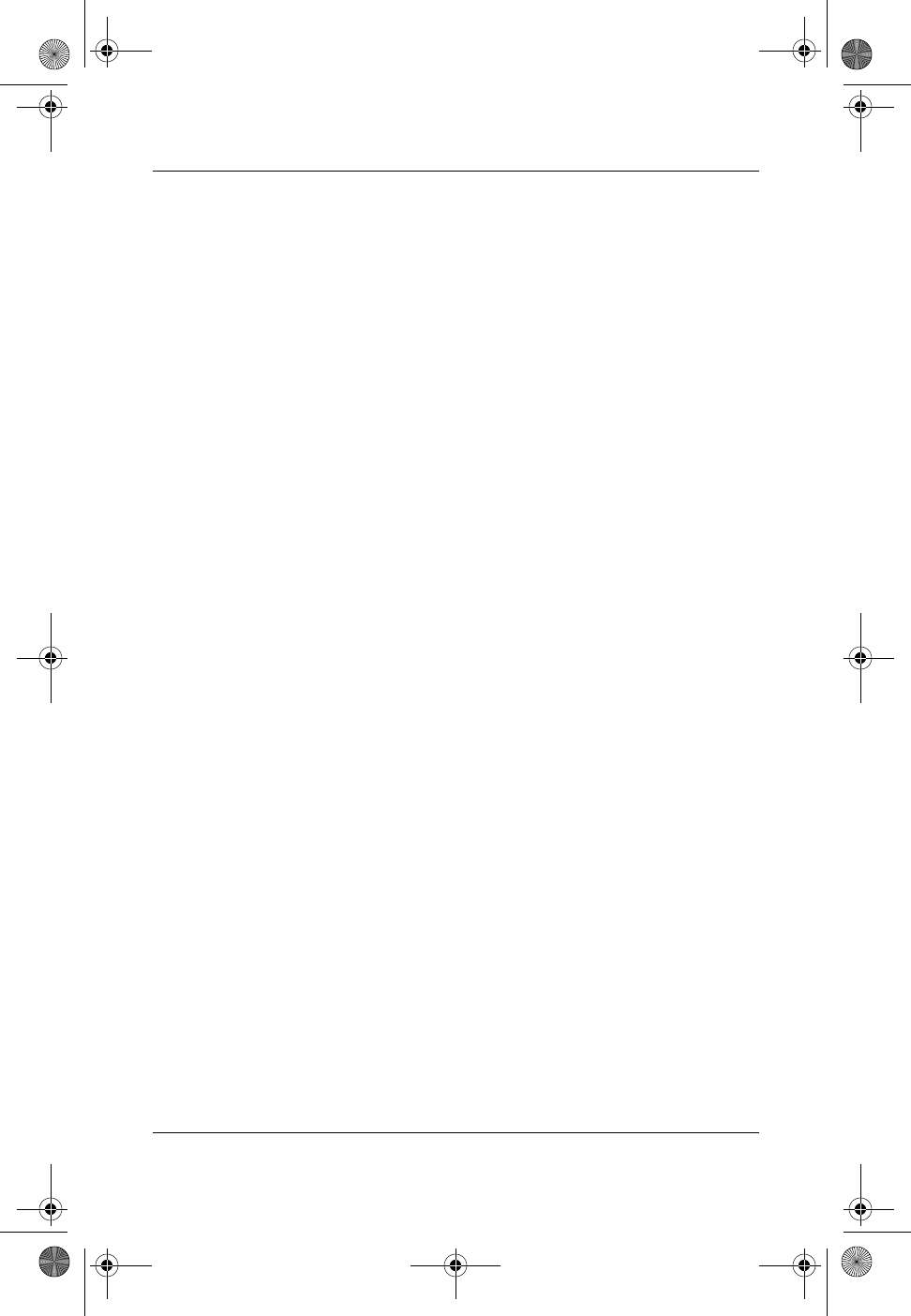
Multimedia
Startup and Reference Guide—Part 2 6–9
Using Easy CD Creator
Easy CD Creator is a data transfer utility that enables you to
create or duplicate optical drive media. The utility is installed on
select models and can be used with any CD or DVD supported by
any optical drive in the system.
When Easy CD Creator is installed, a “Burn CD & DVDs with
Roxio” icon is displayed at Start > All Programs > Start Menu.
Understanding Easy CD Creator Features
Easy CD Creator includes 2 applications: DirectCD and Easy CD
Creator. The Easy CD Creator application includes CD Copier.
■Use DirectCD with Windows Explorer to drag-and-drop data
files between your hard drive and a CD or DVD or between
your hard drive and a network drive. DirectCD is often used
to back up data files or to share them with other people.
Although DirectCD can be used with most application data
files, including Microsoft Office data files, it cannot be used
with audio files such as MP3 files.
■Use Easy CD Creator, which includes CD Copier, to copy
either data files such as Microsoft Office files, or audio files
such as MP3 files, to a CD or DVD.
❏Use Easy CD Creator to copy individual audio files to a
CD or DVD, for example, to create a CD containing only
your favorites.
❏Use CD Copier to duplicate a CD or DVD.
HP-323140-001.book Page 9 Tuesday, April 1, 2003 4:20 PM
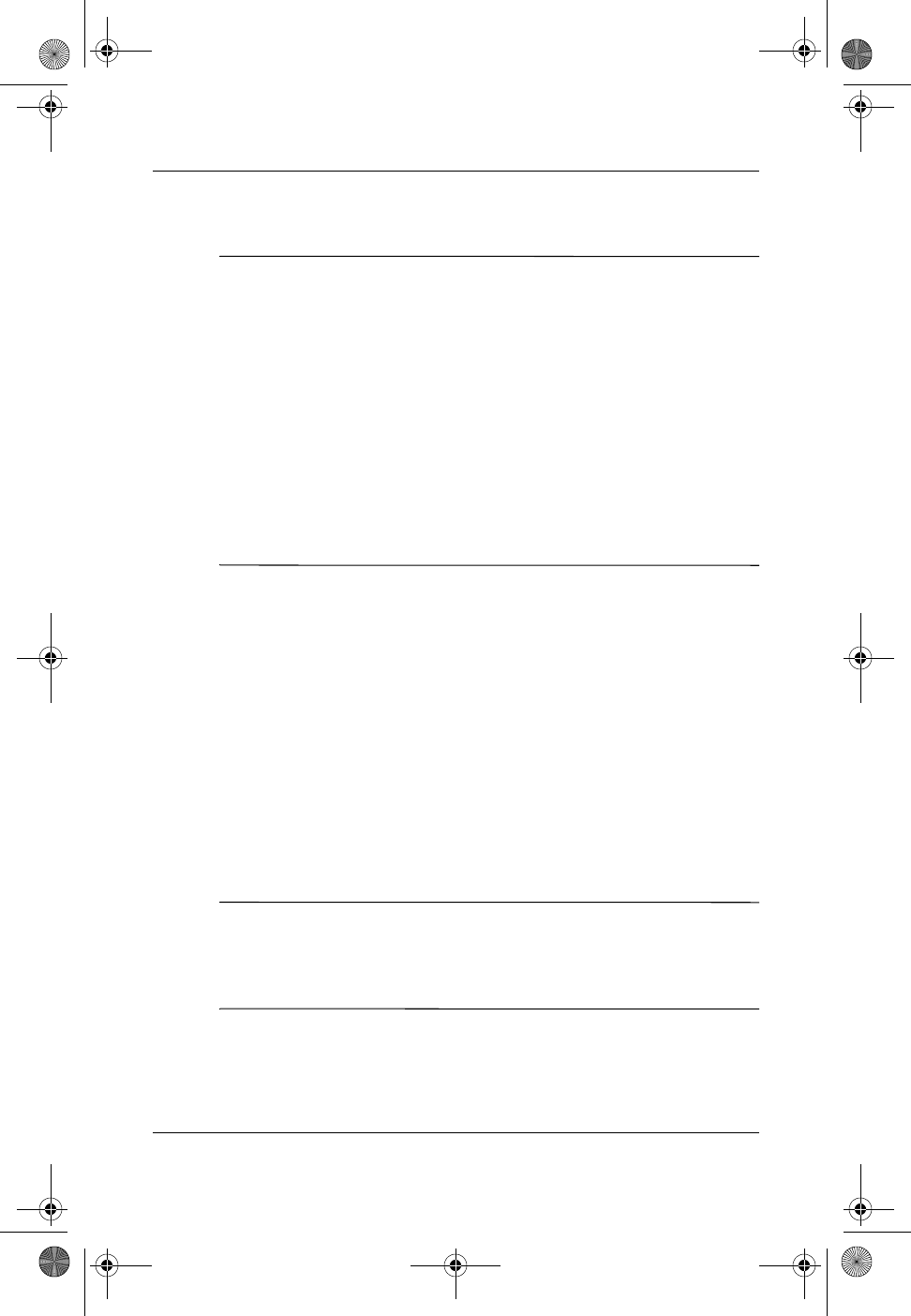
6–10 Startup and Reference Guide—Part 2
Multimedia
Preparing to Use Easy CD Creator
ÄCAUTION: To prevent loss of work and damage to a CD or DVD:
■Before writing to a CD or DVD, connect the notebook to a reliable
external power source. Do not write to a CD or DVD while the
notebook is running on battery power.
■Before writing to a CD or DVD, close all open applications
(including screen savers and antivirus software) except Easy CD
Creator Basic.
■Do not copy directly from a CD or DVD to another CD or DVD or
from a network drive to a CD or DVD. Instead, copy from a CD,
DVD, or a network drive to your hard drive, then copy from your
hard drive to the CD or DVD.
■Do not type on the notebook keyboard or move the notebook while
the notebook is writing to a CD or DVD. The write process is
sensitive to vibration.
Choosing Recording Media
HP recommends using high-quality media that correspond to the
maximum speed of the optical drive. The notebook can write or
copy to CDs and DVDs which provide one-time, non-erasable
recording or to CDs and DVDs which provide erasable recording.
Responding to the UDF Prompt
The first time you insert a CD or DVD into an optical drive, you
may be prompted to install Universal Disk Format (UDF) Reader.
When UDF Reader is installed, a CD or DVD created with
DirectCD on your notebook can be used in another computer on
which DirectCD is not installed.
✎Even if UDF Reader is installed on your notebook, a CD or DVD
created with DirectCD software can be used in a compatible
optical drive only if you select the Rearrange the Files option as
you create the CD or DVD.
HP-323140-001.book Page 10 Tuesday, April 1, 2003 4:20 PM
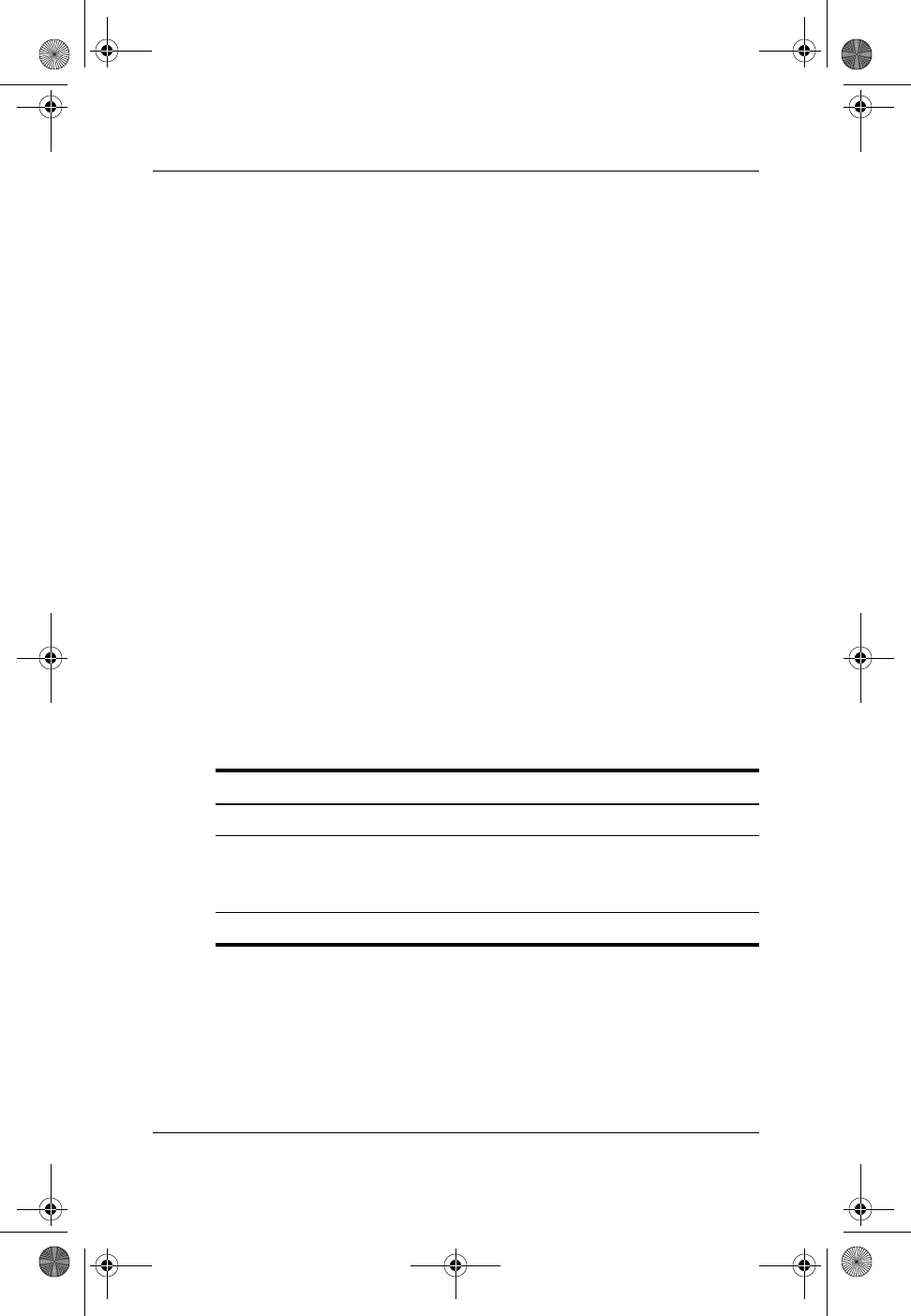
Multimedia
Startup and Reference Guide—Part 2 6–11
Formatting Recording Media
You can purchase optical drive media that either are or are not
formatted for DirectCD.
■To use DirectCD, use a CD or DVD formatted for DirectCD.
■To use Easy CD Creator or CD Copier, do not use a CD or
DVD formatted for DirectCD.
To erase DirectCD formatting from a CD or DVD so the CD or
DVD can be used with Easy CD Creator or CD Copier:
1. Insert the CD or DVD into the optical drive.
2. Select Start > All Programs > Easy CD Creator Basic >
CD-RW Eraser.
3. Select the Erase button.
4. Select the OK button.
Selecting Easy CD Creator Settings
To use DirectCD, Easy CD Creator, or CD Copier, the default
settings shown in the following table must be selected. These
settings are compatible; for example, the settings for DirectCD do
not conflict with the settings for CD Copier.
Application Required Settings
DirectCD Enable Auto Insert Notification
Easy CD Creator Disable Disk-at-Once
and
Enable Track-at-Once
CD Copier Disable Disk-at-Once
HP-323140-001.book Page 11 Tuesday, April 1, 2003 4:20 PM
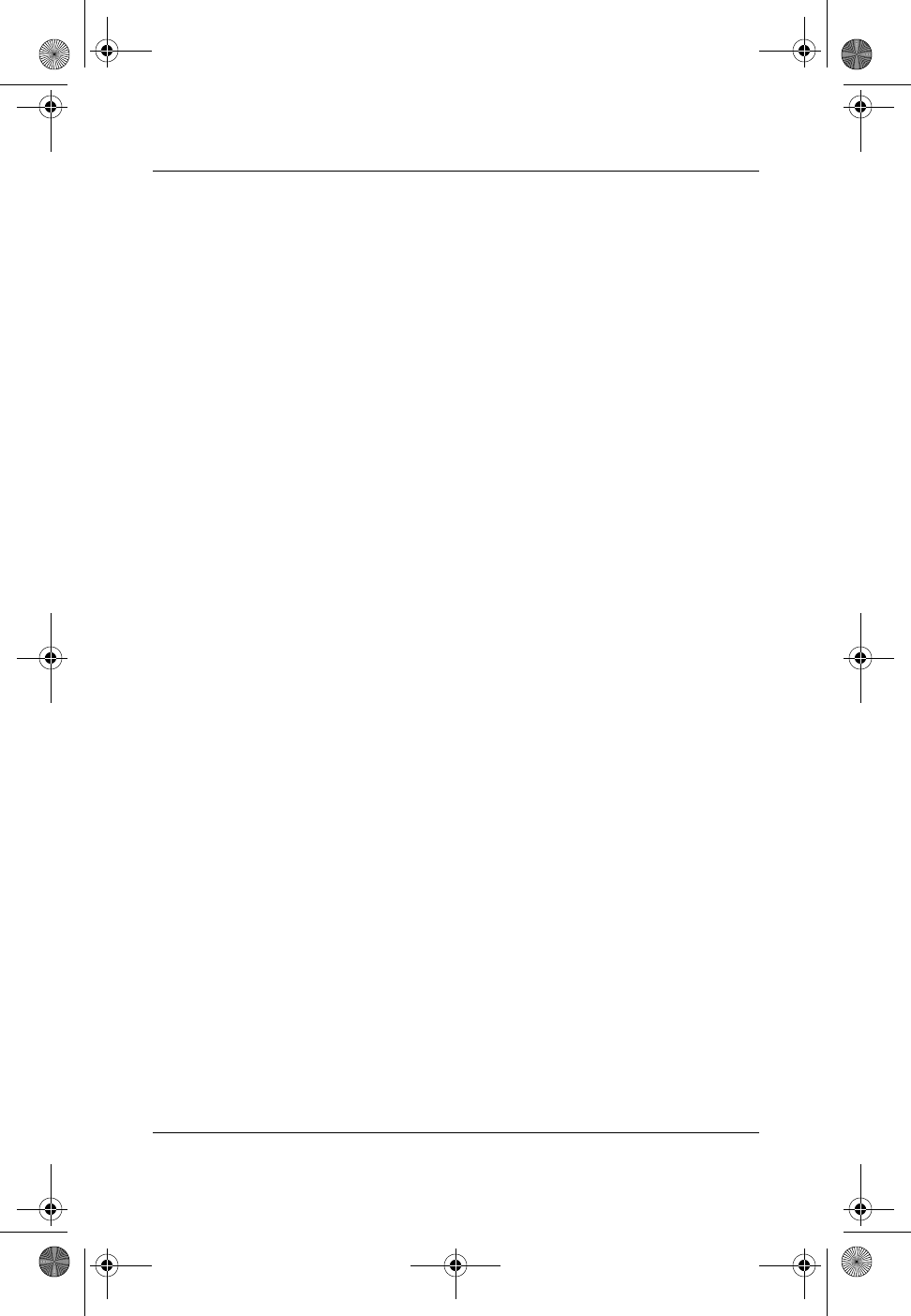
6–12 Startup and Reference Guide—Part 2
Multimedia
■Auto Insert Notification settings are selected through the
operating system.
■To select Disk-at-once settings:
1.Select Start > All Programs > Roxio Easy CD Creator 5 >
Applications > CD Copier.
2. Select the Advanced tab.
3. Clear the Disk-at-Once check box.
4. Select the Set as Default button.
■To select Track-at-once settings:
1.Select Start > All Programs > Roxio Easy CD Creator 5.
2. The fourth item on the status bar at the lower edge of the
CD Project window indicates whether Track-at-Once or
Disk-at-Once is selected.
◆If Track-at-Once is displayed on the status bar,
Track-at-Once is already enabled.
◆If Disk-at-Once is selected, double-click
Disk-at-Once to enable Track-at-Once.
HP-323140-001.book Page 12 Tuesday, April 1, 2003 4:20 PM
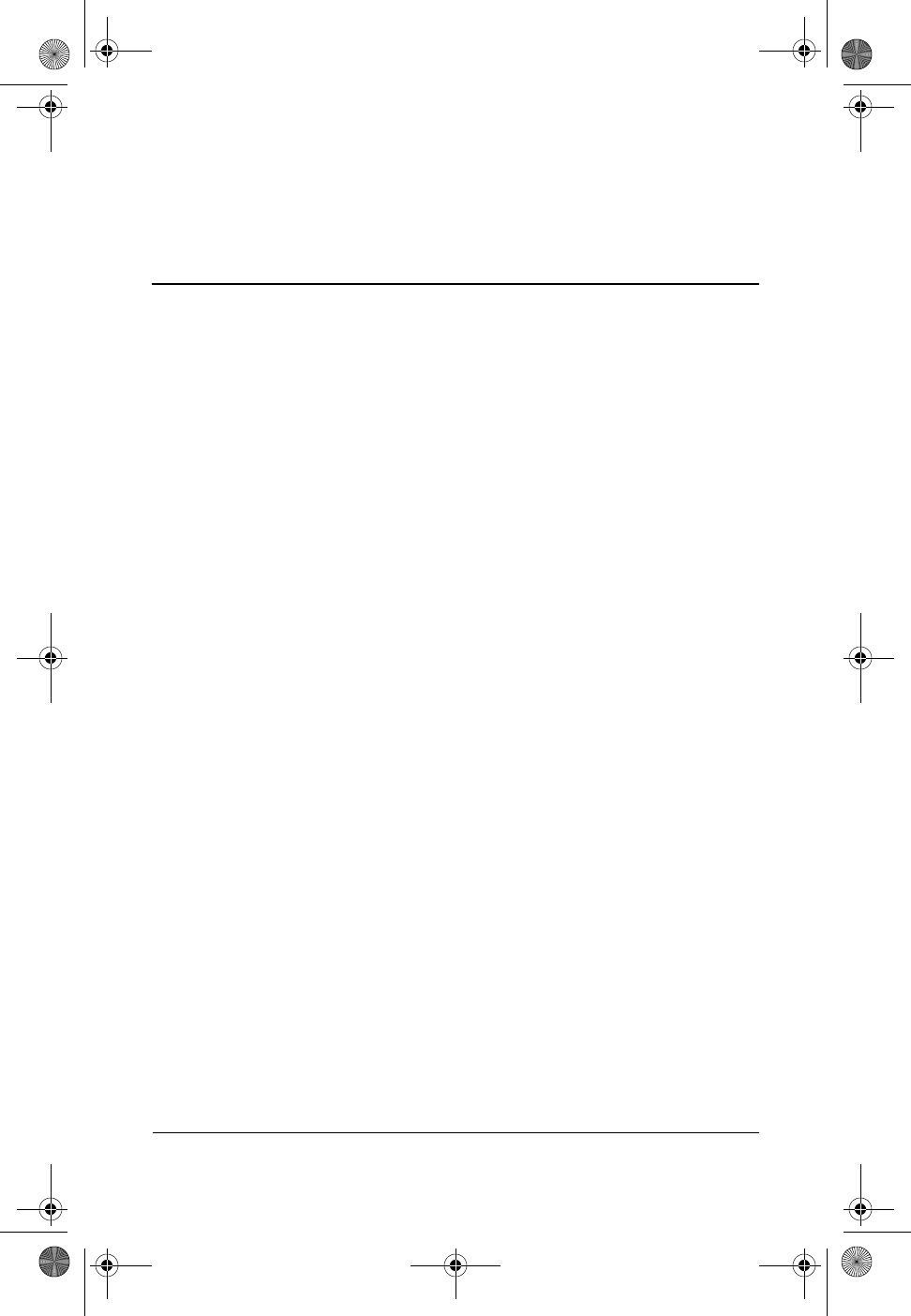
Startup and Reference Guide—Part 2 7–1
7
Communications
Contents
Modem . . . . . . . . . . . . . . . . . . . . . . . . . . . . . . . . . . . . . . . 7–2
Connecting the Modem . . . . . . . . . . . . . . . . . . . . . . . 7–3
Using the Modem While Traveling
Internationally . . . . . . . . . . . . . . . . . . . . . . . . . . . . . . 7–6
Accessing Communication Software. . . . . . . . . . . . . 7–9
Finding AT Command Information. . . . . . . . . . . . . . 7–9
Network . . . . . . . . . . . . . . . . . . . . . . . . . . . . . . . . . . . . . 7–10
Connecting the Network Cable . . . . . . . . . . . . . . . . 7–11
Turning a Network Connection Off and On . . . . . . 7–12
Accessing the Network at Startup . . . . . . . . . . . . . . 7–12
Infrared. . . . . . . . . . . . . . . . . . . . . . . . . . . . . . . . . . . . . . 7–12
Setting Up an Infrared Transmission. . . . . . . . . . . . 7–13
Avoiding Standby While Using Infrared. . . . . . . . . 7–14
HP-323140-001.book Page 1 Tuesday, April 1, 2003 4:20 PM
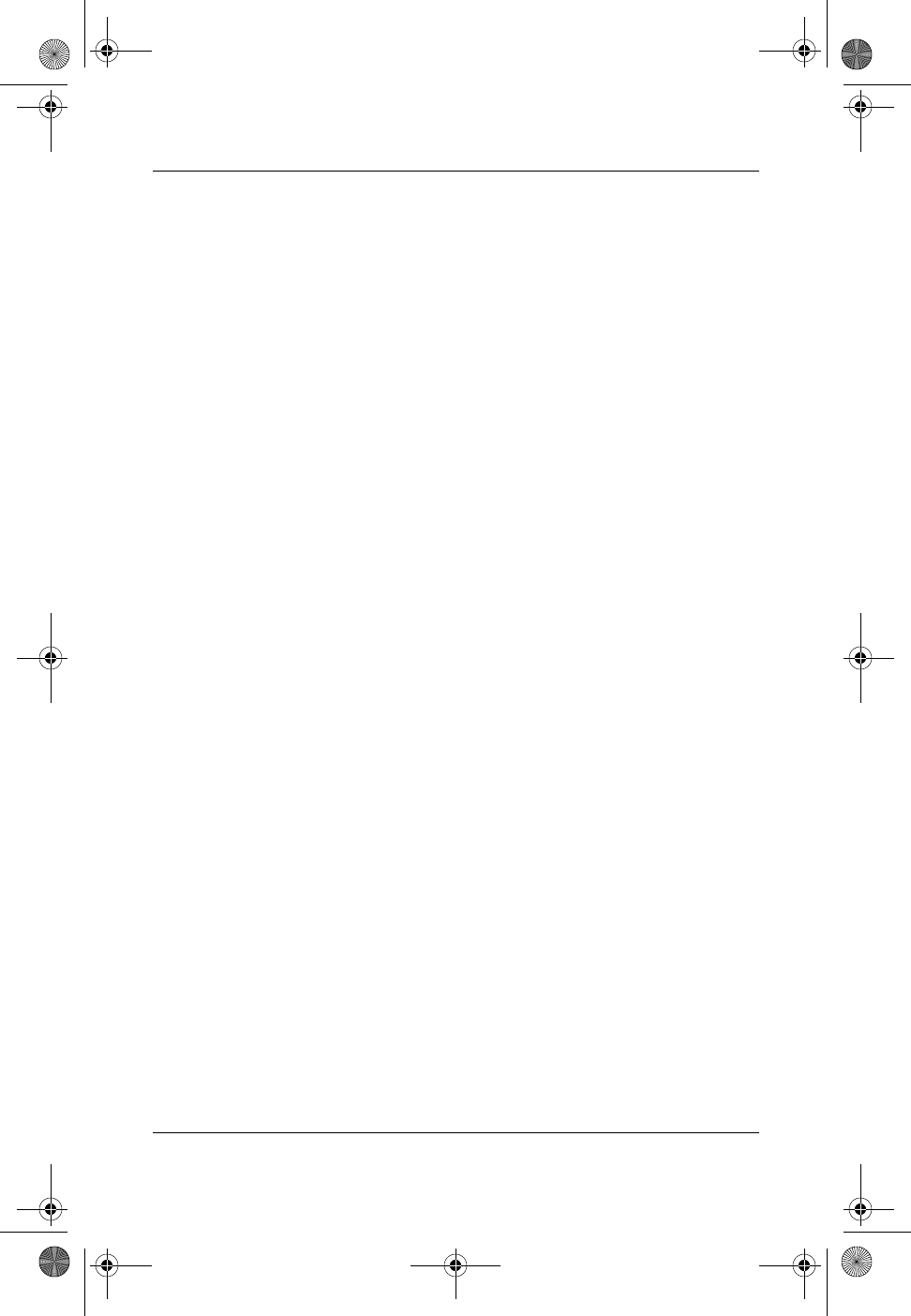
7–2 Startup and Reference Guide—Part 2
Communications
Modem
All notebook models include an RJ-11 telephone jack, and some
models ship with a preinstalled modem. A modem cable with
RJ-11 connectors at each end is included with select models.
You need a modem cable to connect a modem. If your model did
not include a modem cable, a modem cable can be purchased
from most computer or electronics retailers.
If you purchased a notebook with an internal modem in a country
where RJ-11 telephone jacks are not standard, a country-specific
modem adapter is included with the notebook.
An internal modem supports:
■All applications supported by the operating system.
■V.34 ITU (International Telecommunications Union) analog
modem recommendations for speeds up to 33.6 Kbps.
■V.44 data compression algorithm.
■V.90/V.92 ITU digital/analog modem pair recommendations
for speeds up to 56 Kbps.
The digital/analog modem pair rates allow faster downloads
only from compliant digital sources. Maximum achievable
download rates are currently unknown, may not reach
56 Kbps, and will vary with line conditions. Maximum
achievable upload rates are limited to 48 Kbps, may not reach
48 Kbps, and will vary with line conditions.
HP-323140-001.book Page 2 Tuesday, April 1, 2003 4:20 PM
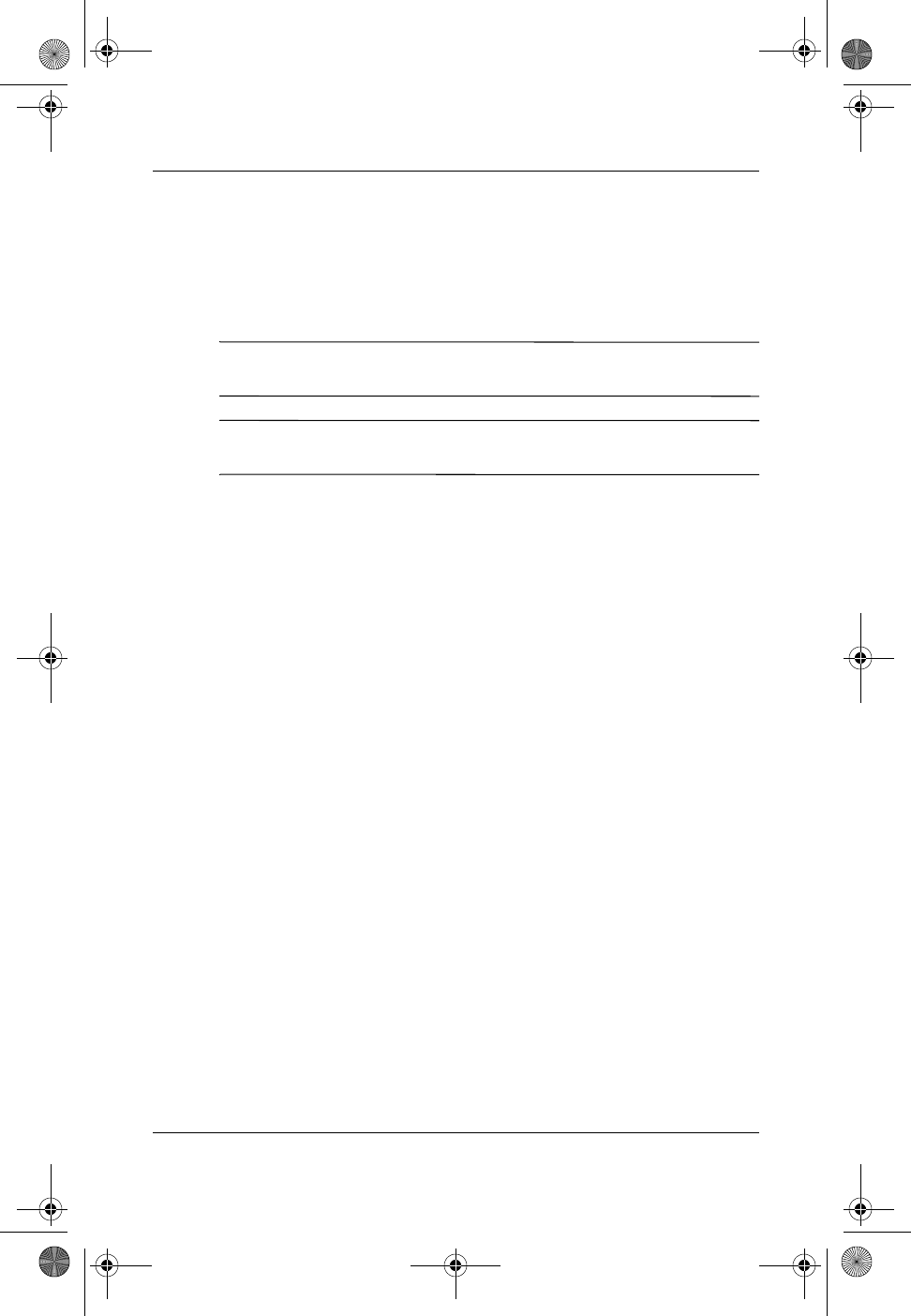
Communications
Startup and Reference Guide—Part 2 7–3
Connecting the Modem
Selecting Connectors
A modem must be connected to an analog telephone line.
ÅWARNING: To reduce the risk of electric shock, fire, or damage to the
equipment, do not plug a telephone cable into the RJ-45 network jack.
ÄCAUTION: Jacks for digital PBX systems may resemble RJ-11 telephone
jacks, but are not compatible with the modem.
Jacks for analog telephone lines and procedures for connecting
the modem vary by country:
■If you are connecting a modem in a country where
RJ-11 telephone jacks are standard, follow the instructions
in “Connecting a Modem to an RJ-11 Jack” next in this
section.
■If you are connecting a modem in a country where RJ-11
telephone jacks are not standard, a modem adapter specific to
the country in which you purchased the notebook is included
with the notebook. Follow the instructions in “Connecting a
Modem with an Adapter” later in this section.
■If you plan to use a modem outside the country in which you
purchased the notebook, you can purchase adapters specific
for the countries on your itinerary from most computer or
electronics retailers. For information about using
country-specific software configurations, see “Using the
Modem While Traveling Internationally” later in this section.
HP-323140-001.book Page 3 Tuesday, April 1, 2003 4:20 PM
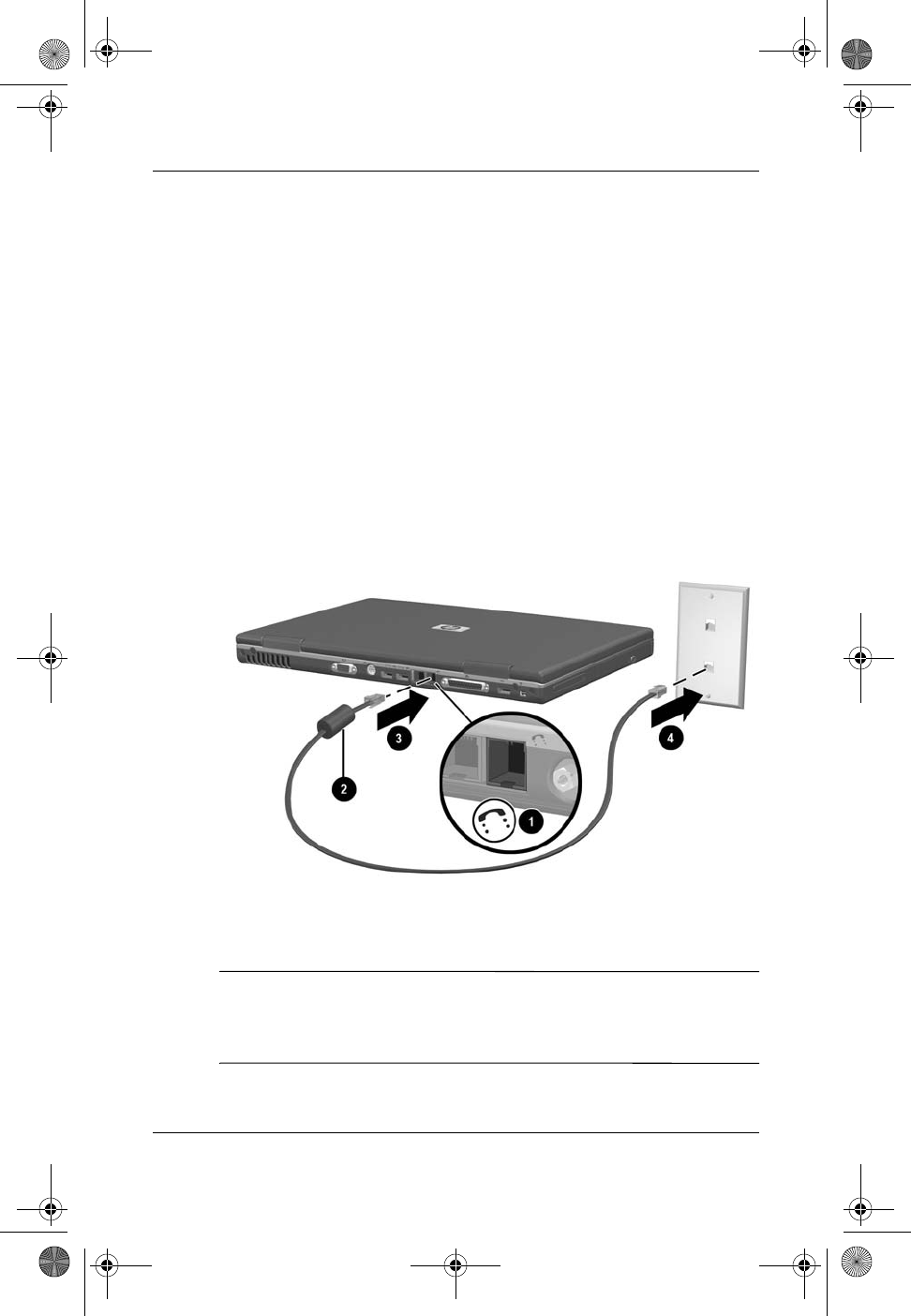
7–4 Startup and Reference Guide—Part 2
Communications
Connecting a Modem to an RJ-11 Jack
To connect a modem to an analog telephone line that has an
RJ-11 telephone jack:
1. Identify the RJ-11 1 jack on the notebook.
2. If your modem cable has noise suppression circuitry 2,
which prevents interference with TV and radio reception,
orient the circuitry end of the cable toward the notebook.
3. Plug the modem cable into the RJ-11 telephone jack (not the
RJ-45 network jack) on the notebook 3.
4. Plug the other end of the modem cable into an RJ-11
telephone jack (not into an RJ-45 network jack or a
PBX jack) 4.
Connecting a modem to an RJ-11 telephone wall jack (Telephone
wall jacks vary in appearance by region and country.)
ÅWARNING: To reduce the risk of electric shock, disconnect the modem
from the telephone network before accessing an internal compartment
of the notebook. Internal compartments include the memory
compartment and the battery and hard drive bays.
HP-323140-001.book Page 4 Tuesday, April 1, 2003 4:20 PM
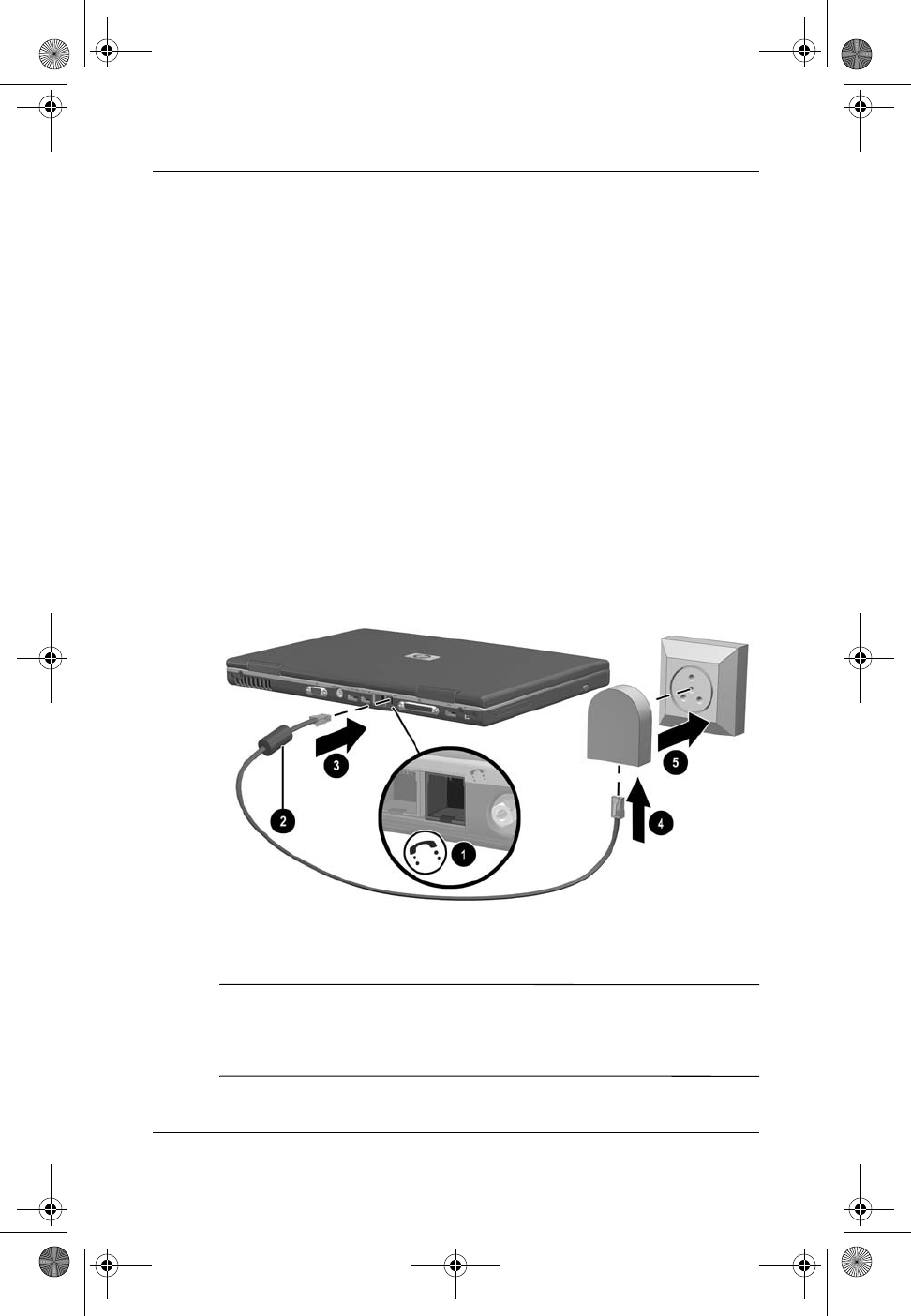
Communications
Startup and Reference Guide—Part 2 7–5
Connecting a Modem with an Adapter
To connect a modem to an analog telephone line that does not
have an RJ-11 telephone jack:
1. Identify the RJ-11 jack 1 on the notebook.
2. If the modem cable has noise suppression circuitry 2, which
prevents interference with TV and radio reception, orient the
circuitry end of the cable toward the notebook.
3. Plug the modem cable into the RJ-11 telephone jack (not the
RJ-45 network jack) on the notebook 3.
4. Plug the modem cable into the country-specific modem
adapter 4.
5. Plug the country-specific modem adapter into the
telephone jack 5.
Connecting a modem with a modem adapter (Telephone wall jacks
vary in appearance by region and country.)
ÅWARNING: To reduce the risk of electric shock, disconnect the modem
from the telephone network before accessing an internal compartment
of the notebook. Internal compartments include the memory
compartment and the battery and hard drive bays.
HP-323140-001.book Page 5 Tuesday, April 1, 2003 4:20 PM
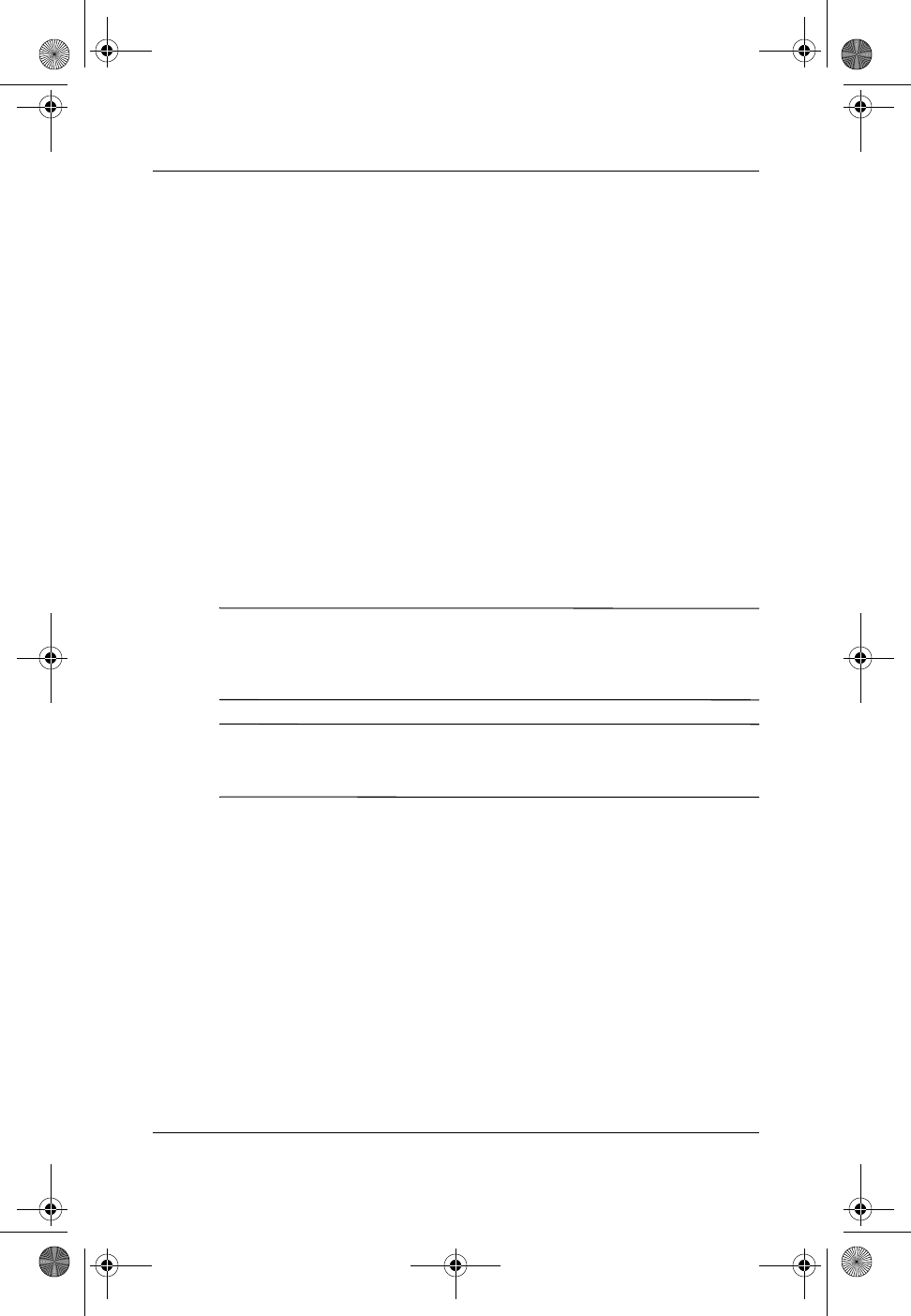
7–6 Startup and Reference Guide—Part 2
Communications
Using the Modem While Traveling
Internationally
An internal modem is configured to function in, and meet the
operating standards of, the country in which you purchased the
notebook. To use an internal modem in other countries, you must
add country-specific modem configurations.
Displaying the Current Country Configuration
To display the current country configuration, select Start >
Control Panel > Date, Time, Language, and Regional Options
category > Regional and Language Options icon > Regional
Options tab. The current country configuration of the modem is
displayed in the Location panel.
Adding a Country Configuration
ÄCAUTION: To prevent the loss of your current country configuration, do
not delete or replace your current country configuration. Additional
country configurations can be added without deleting the current
configuration.
ÄCAUTION: To prevent modem malfunction and violation of
telecommunications regulations and laws, use the modem only with the
country configuration for the country in which you are using the modem.
To add a country configuration:
1. Select Start > Control Panel > Network and Internet
Connections category.
2. From the See Also menu in the left column of the window,
select Phone and Modem Options > Dialing Rules tab.
3. Select the New button, then type a name for the new location
in the Location Name field.
HP-323140-001.book Page 6 Tuesday, April 1, 2003 4:20 PM
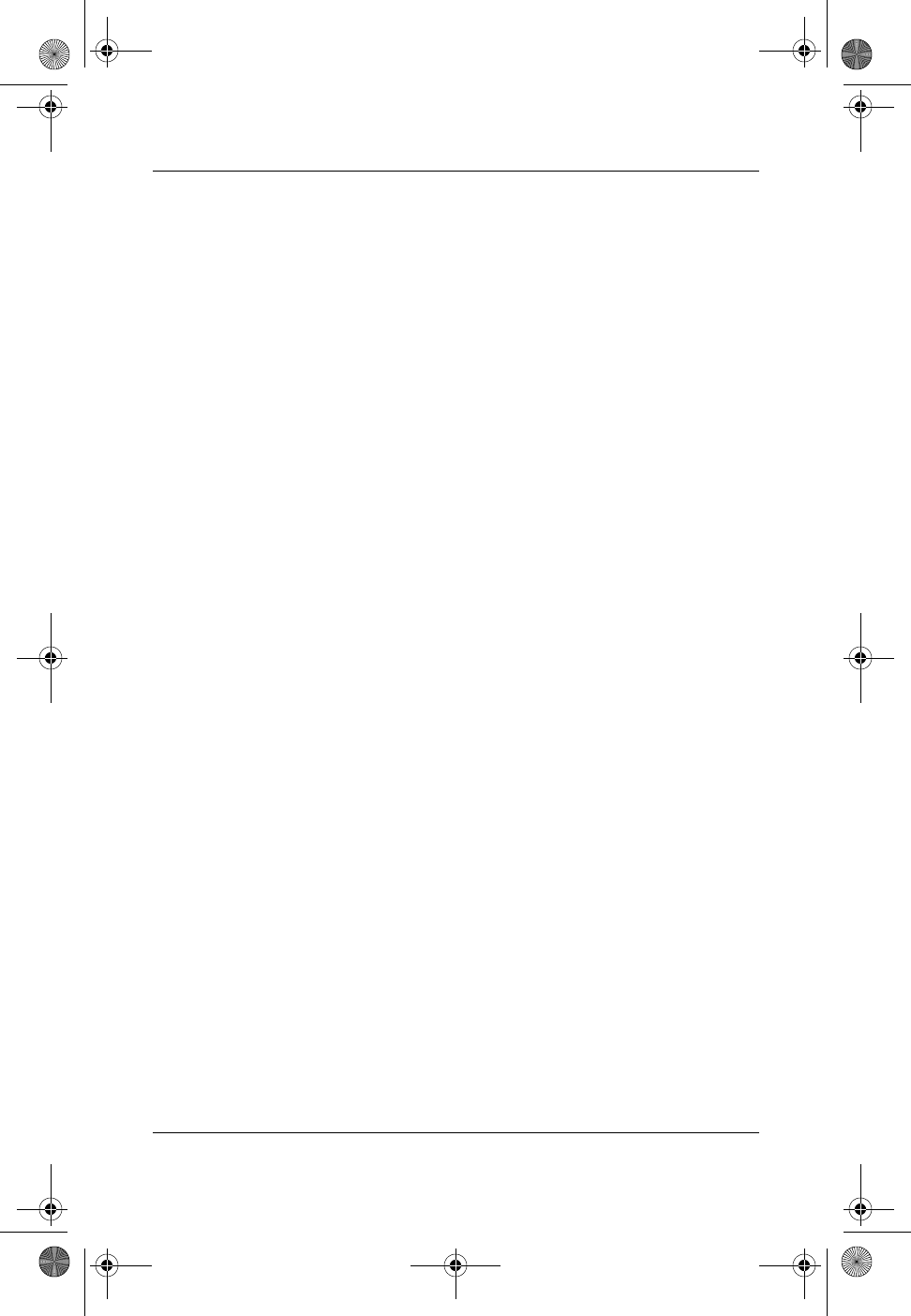
Communications
Startup and Reference Guide—Part 2 7–7
4. Select a country or region for the new location from the
Country/Region list.
If you select a country or region that is not supported by the
modem, the country configuration defaults to USA or UK.
5. Select the OK button > OK button.
Solving Travel Connection Problems
If you experience connection problems while using a modem
outside the country in which you purchased the notebook, the
following suggestions may be helpful.
Before changing any settings, you may want to write down your
current settings so you can quickly replace those settings when
you return home.
Check the Line
A modem requires an analog, not a digital, telephone line. A line
described as a PBX line is usually a digital line. A telephone line
described as a data line, fax machine line, modem line, or
standard telephone line is probably an analog line.
Check the Dialing Mode
Dial a few digits on the telephone, then listen for clicks or tones.
Clicks indicate that the telephone line supports pulse dialing.
Tones indicate that the telephone line supports tone dialing. To set
an internal modem to support a dialing mode:
1. Select Start > Control Panel > Network and Internet
Connections category.
2. From the See Also menu in the left column of the window,
select Phone and Modem Options > Dialing Rules tab.
3. Select your location, then select the Edit button.
4. Select the Tone or Pulse radio button.
5. Select the OK button > OK button.
HP-323140-001.book Page 7 Tuesday, April 1, 2003 4:20 PM
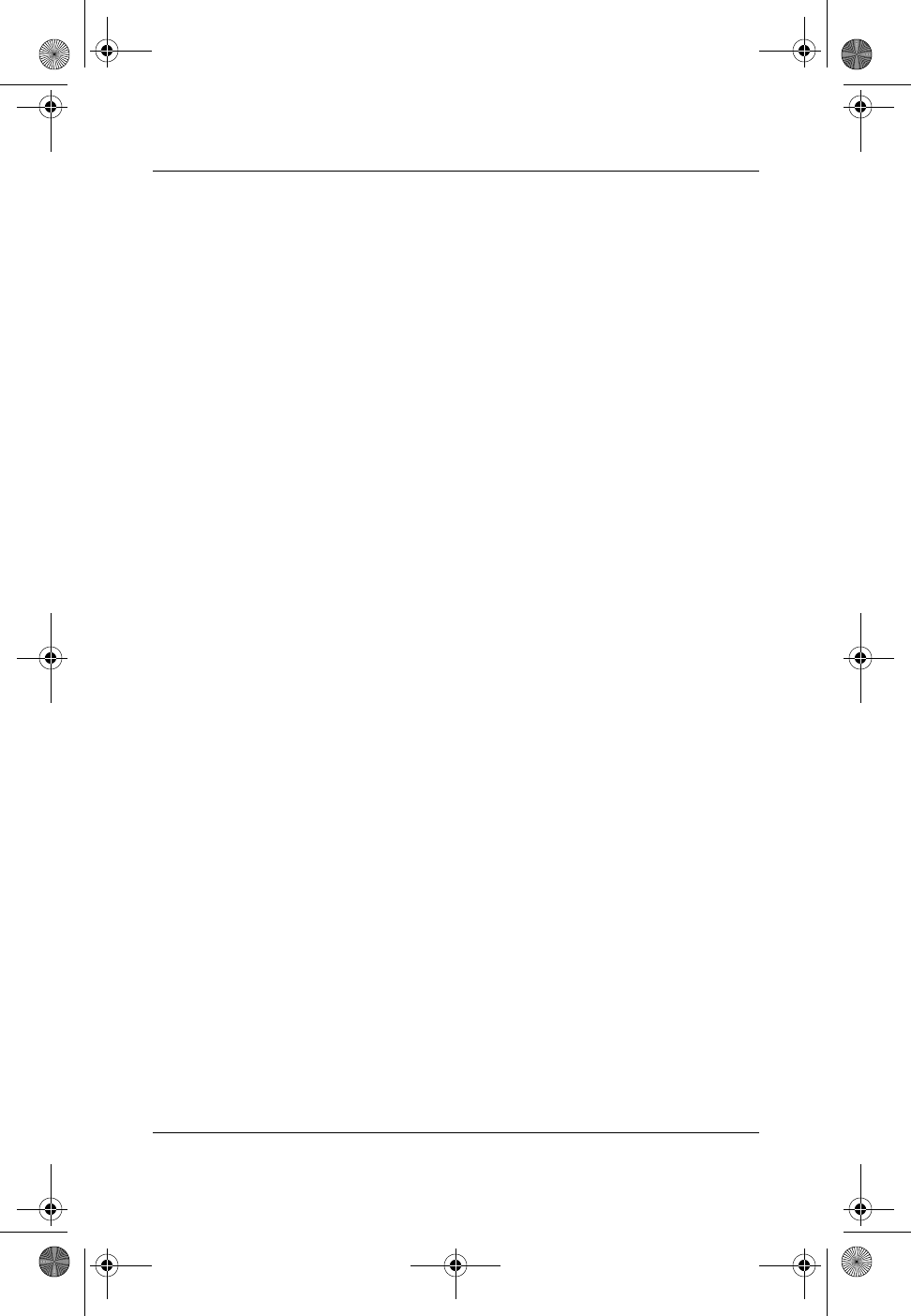
7–8 Startup and Reference Guide—Part 2
Communications
Check the Telephone Number
Dial the telephone number on the telephone, verify that the
remote modem is answering, then hang up.
Check the Dial Tone
If a modem receives a dial tone it does not recognize, the modem
will not dial and will display a No Dial Tone error message.
■To set the modem to ignore all dial tones before dialing:
1.Select Start > Control Panel > Network and Internet
Connections category.
2. From the See Also menu in the left column of the
window, select Phone and Modem Options >
Modems tab.
3. Select your modem > Properties button > Modem tab.
4. Clear the Wait For Dial Tone Before Dialing check box.
5. Select the OK button > OK button.
■If you continue to receive the No Dial Tone error message
after clearing the check box:
1.Select Start > Control Panel > Network and Internet
Connections category.
2. From the See Also menu in the left column of the
Network and Internet Connections window, select Phone
and Modem Options > Dialing Rules tab.
3. Select your location, then select the Edit button.
4. Select your location from the Country/Region list.
If you select a country or region that is not supported
by the modem, the country configuration defaults to
USA or UK.
5. Select the OK button.
6. In the Phone and Modem Options window, select the
Modems tab.
HP-323140-001.book Page 8 Tuesday, April 1, 2003 4:20 PM
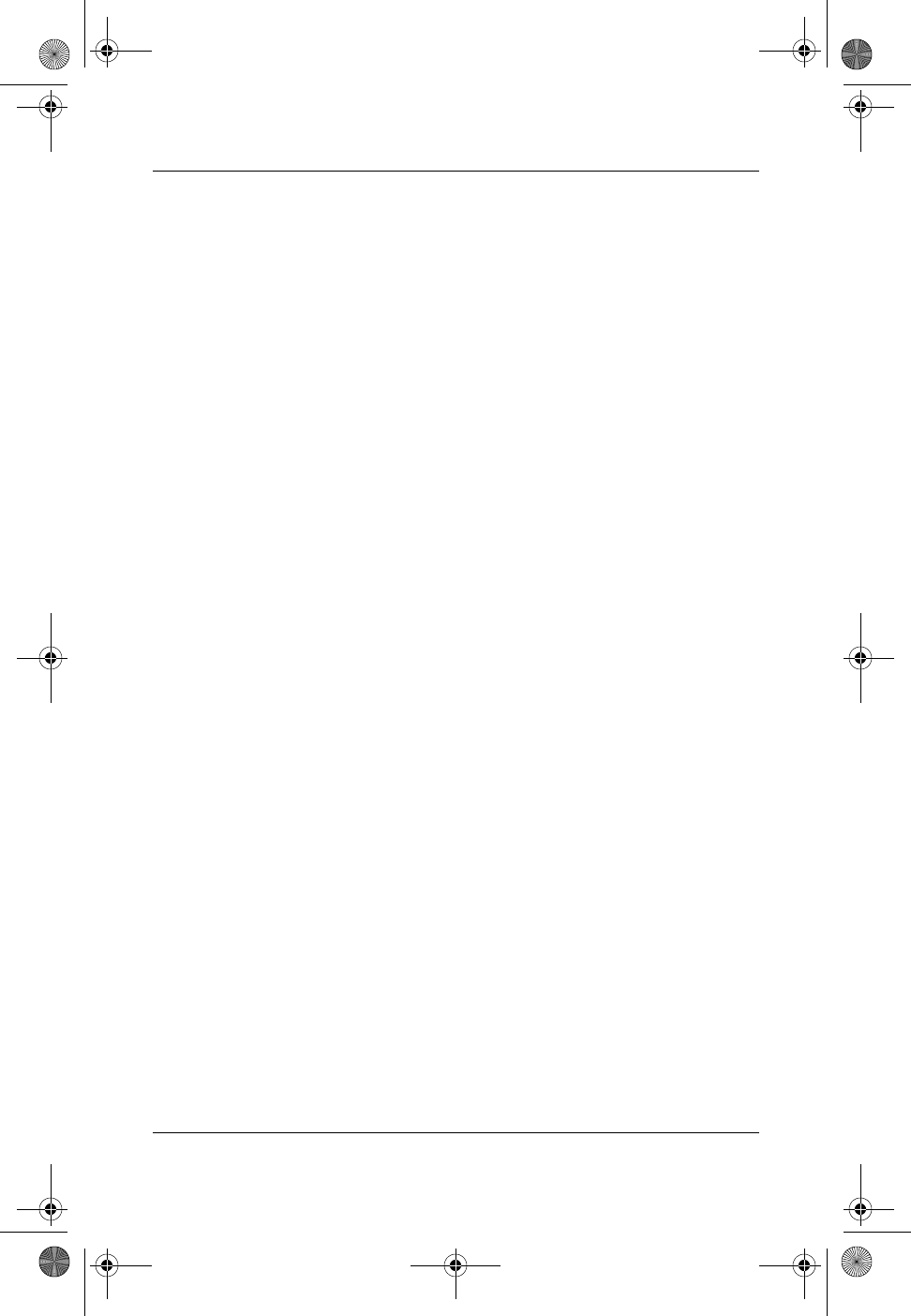
Communications
Startup and Reference Guide—Part 2 7–9
7. Select your modem > Properties button > Modem tab.
8. Clear the Wait For Dial Tone Before Dialing check box.
9. Select the OK button > OK button.
Accessing Communication Software
To access preinstalled modem software, including software
for terminal emulation and data transfer, select Start > All
Programs > Accessories > Communications, then select an
application, wizard, or utility.
Finding AT Command Information
It is not necessary to use AT commands with most modem
software. If you prefer to use AT commands, refer on the
Documentation Library CD to:
■Modem Commands Guidelines (Advanced Users Only) for
information about accessing HyperTerminal, identifying the
modem model in your notebook, and using AT commands.
■The Lucent/Agere Command Set (Advanced Users Only)
guide for the AT commands supported by a Lucent/Agere
modem. If your notebook shipped with an internal modem,
that modem supports the Lucent/Agere command set. For
command updates and supplementary information about your
Lucent/Agere modem, visit:
http://www.agere.com
The Lucent/Agere command set guide is provided on the
Documentation Library CD in English only.
HP-323140-001.book Page 9 Tuesday, April 1, 2003 4:20 PM
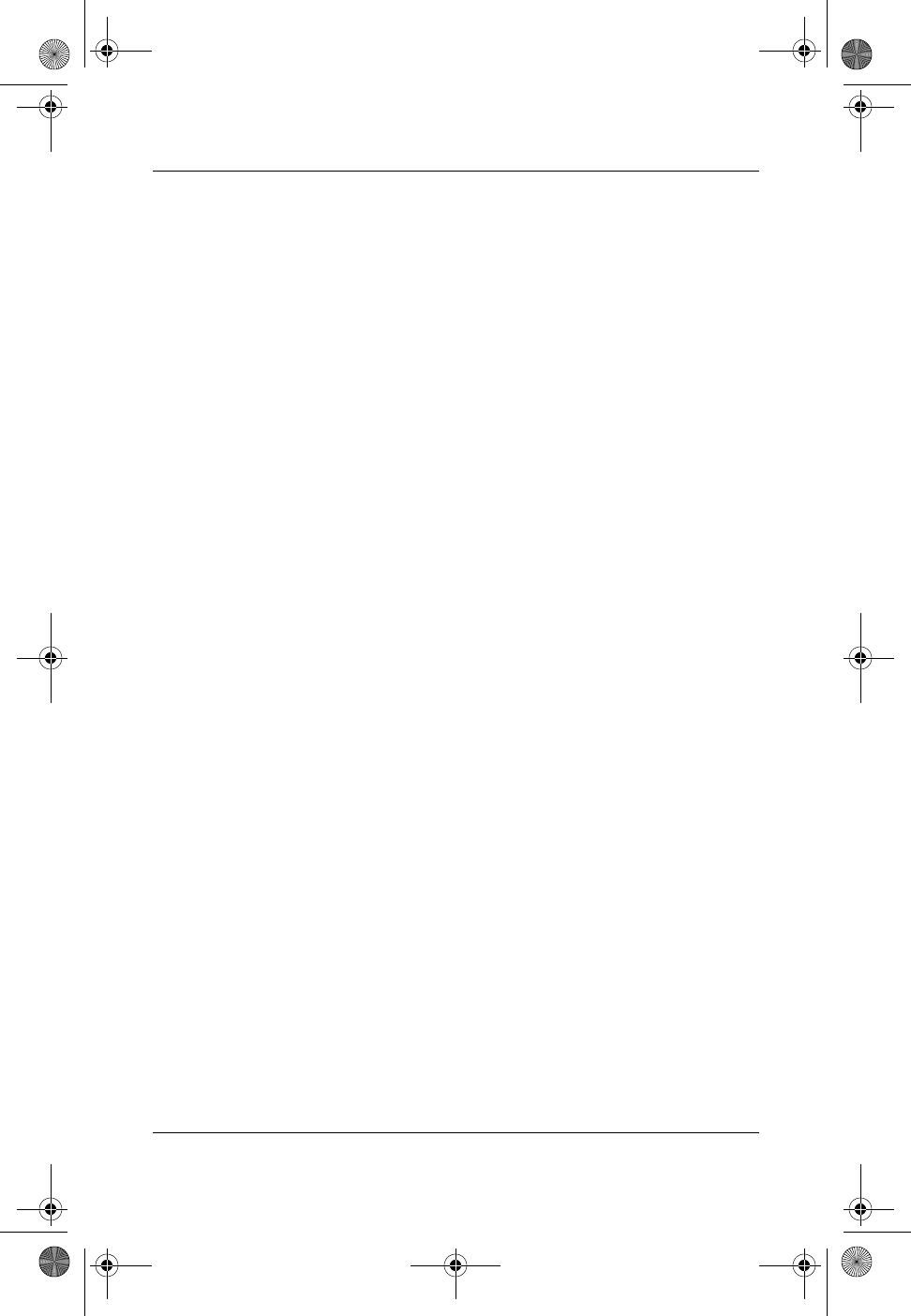
7–10 Startup and Reference Guide—Part 2
Communications
Network
All notebook models ship with an RJ-45 network jack. A network
cable with RJ-45 connectors at each end is included with select
models.
The notebook can be connected to a network whether or not the
internal modem is connected to a telephone line.
If your notebook is connected to a network, you may want to
confer with your network administrator before changing network
settings.
The notebook supports network speeds up to 10 Mbps when
connected to a 10BaseT network and 100 Mbps when connected
to a 100BaseTX network.
HP-323140-001.book Page 10 Tuesday, April 1, 2003 4:20 PM